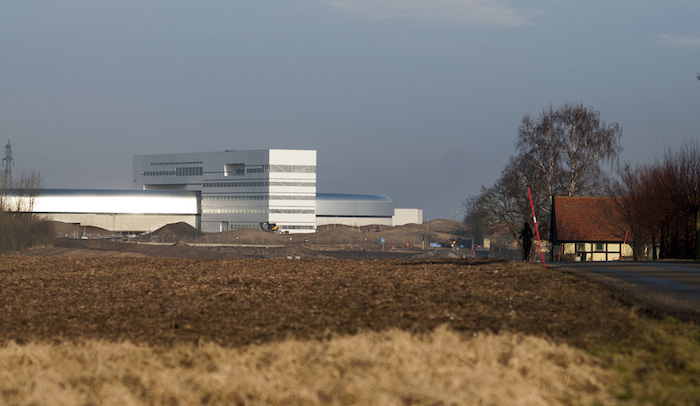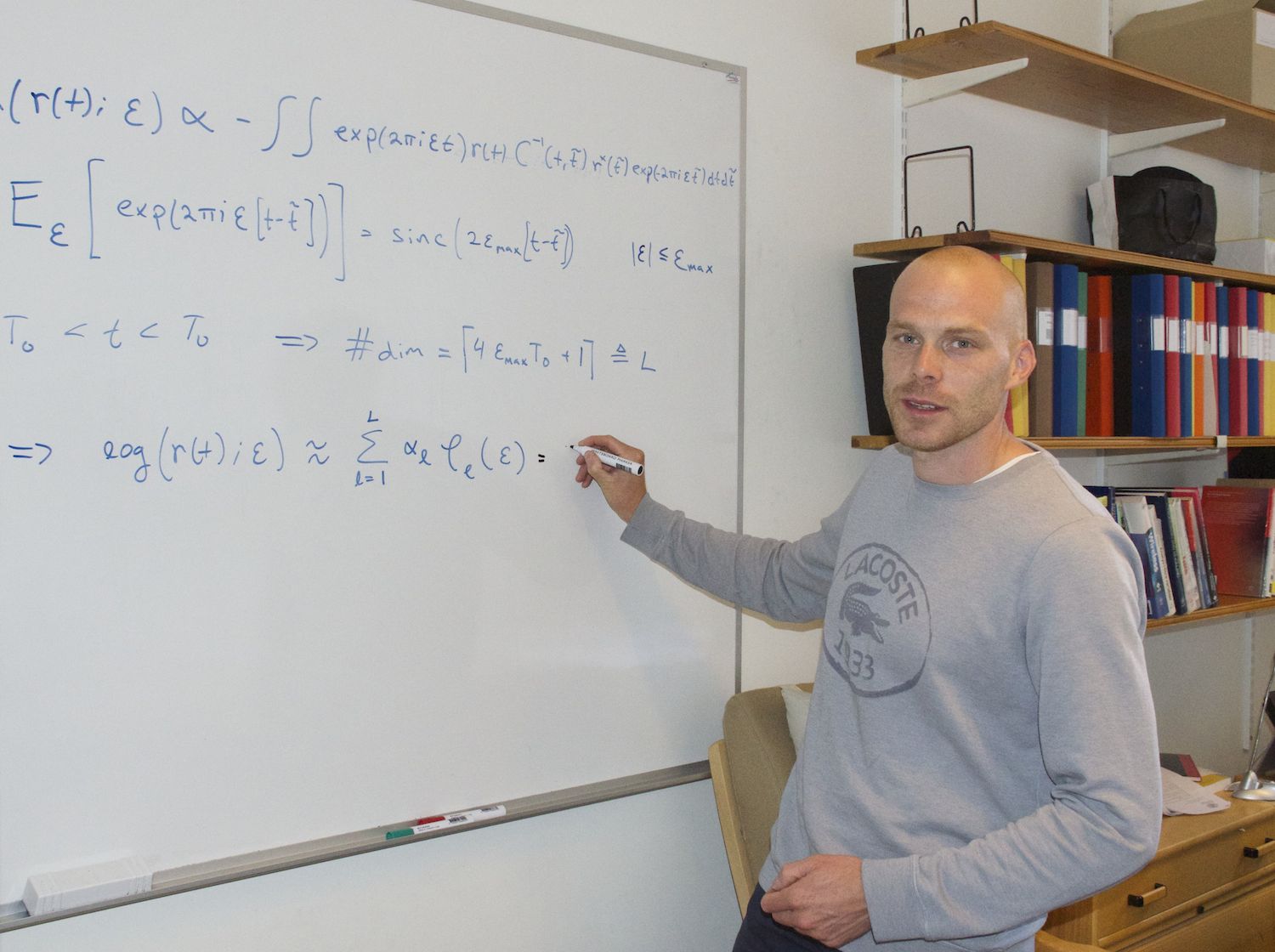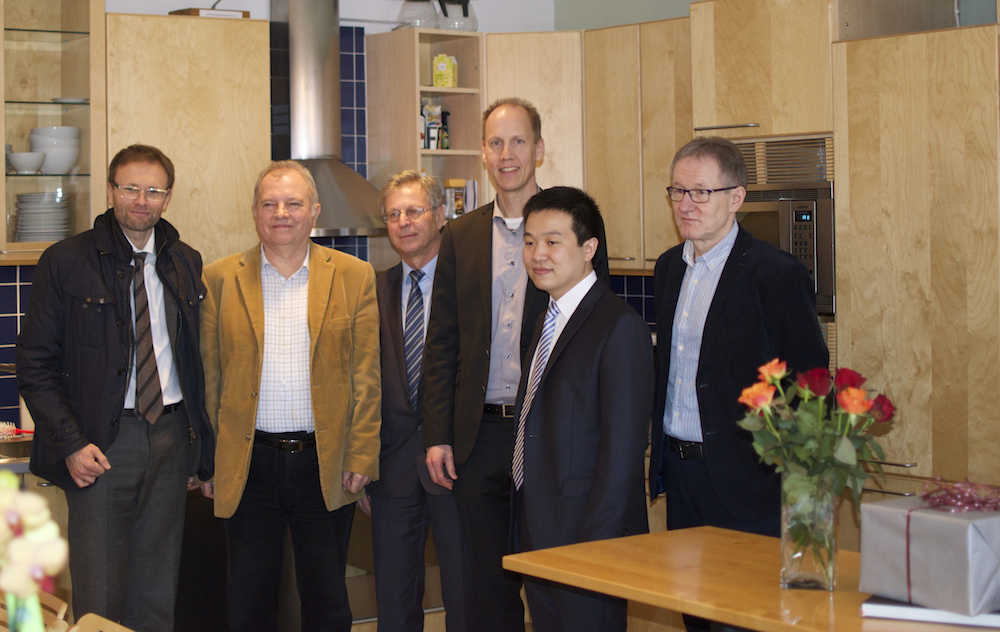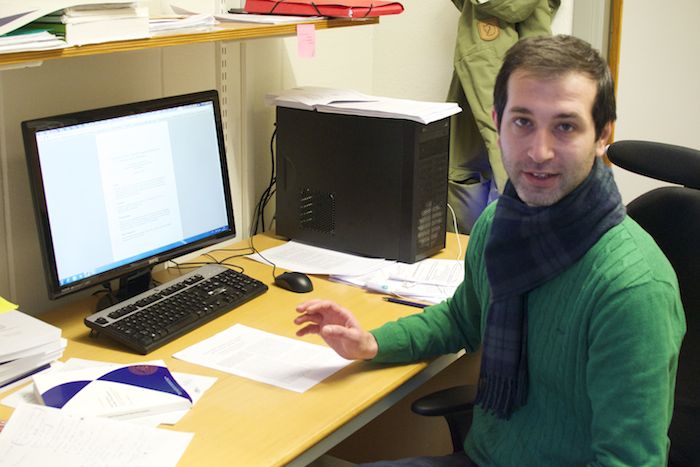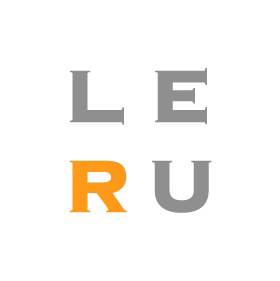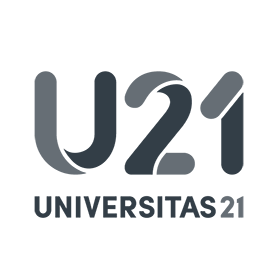News archive, 2015
Theory becomes practice in Imans research
Published: 2015-12-11
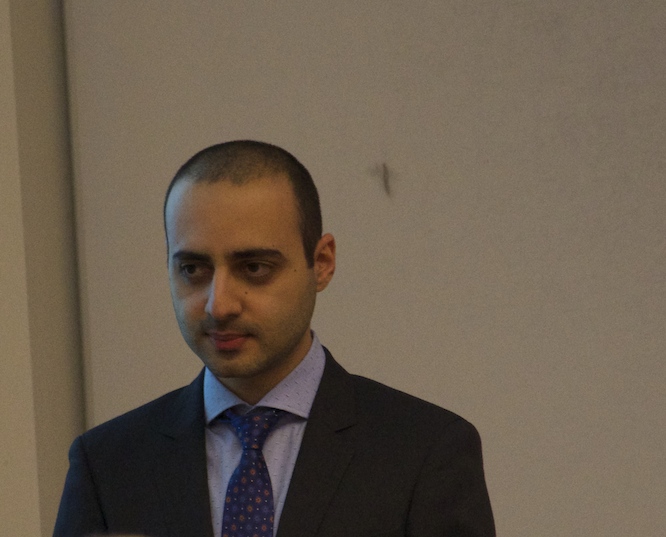
EITs latest doctor is Iman Vakili and his defense was held on November 27 this year. In his research they deal with so-called wavelets and short pulses of 100 ps. During this ultrashort time, 60 GHz signals are sent into the wideband antenna that Iman is behind .
Small and efficient short range antennas
The research area has, to some extent, already made an entry into commercial applications. The EIT-originated venture Acconeer is an example of an adopter of this kind of technology in order to make robotic vacuum cleaners work. This is an area where cost-effective short range radar functionality will be needed. In the long term this technology will climb up the frequency-ladder to perhaps 200 GHz in similar and other applications. These extremely high frequencies are already on the researchers' agenda whereby you can achieve even shorter pulses and higher resolutions.
-A specifically sized bluetooth-antenna would, redesigned for 60GHz, give much, much higher gain, says Iman . We get smaller antennas for higher frequencies simply. Antenna size is related to the wavelength, a fact known by all electrical engineers.
60 GHz is extremely suitable for indoor applications. Even if higher frequencies might decrease the range, it could still enable wireless contacting of backplanes, replacement of cables inside computers, etc. As for the bit rate we are talking about up to 20 gigabits per second in future applications. -Something we already can accomplish in a laboratory environment, says Iman.
Collaboration between research groups
Iman cooperates with Lars-Erik Wernerssons group where Lars-Erik himself is a supervisor making this a really good example of cross fertilization between EIT-units.
The wavelet-generator that Iman uses is designed by the nano-group and the antenna that he designed is extremely wide band because the transmitted pulse is very short. Remember the Dirac pulses containing all frequencies because it was infinitely short? Iman works really at the border between theory and practice and has in his research project combined the wavelet generator and an antenna into a functioning system .
Attracted to research. But perhaps in industry.
With all respect to vacuum cleaners, Imans research can be used for other things also. For example, security personnel at an airport might want to see through clothes and quickly uncover the introduction of illegal things into safe areas. Looking ahead, Iman wants to do research with a useful and practical extension in products or industrial applications. A wide field as it appears. -Lately, however, all the focus has been on the thesis and the dissertation so I need to recover a bit before the next step towards the future is taken, Iman tells us.
Started as a summer project
Iman arrived in Lund 2009 and started in a summerproject within Mats Gustafssons Teorel-group 2010. A project that grew to a master thesis work and the materialized further to a research project finanzed by the nano-group. To learn by teaching others is a method also used by Iman in providing lecturing-efforts within the Teorel courseplan.
Iran and Sweden are homes
Iman is from Tehran in Iran and he travels home to his family now and then. The new president of Iran has increased optimism and Iman hope that his country is now on the right track after a number of long hard years . We have a whole little Iranian research community at EIT which does its part to feel at home in Sweden . Sweden is a country which he like a lot and is willing to continue to work in. And the meatballs are ok. And salmon. -A good Iranian restaurant called Shiraz in Lund mixes Swedish and Iranian food culture. Free hint of the day from Iman.
Fluent in Swedish of course after 6 years here, I ask. -I'm sorry, no, says Iman a bit embarrassed. Everyone talk english and my girlfriend is good in swedish and do translations for me. I've become "language-lazy" because of that.
Classical Persian music is an interest and Iman excercizes a bit himself on a 6-string tar. His tutor tells him to practice more however. Pleasant audiotones in 2,5 octaves serves as good relaxation inbetween the 60 GHz-sessions in the lab.
From EIT: -Congrats and good luck in the future.
Text and picture: Anders Borgström
"Best Student Paper" to Therese Forsberg.
Published: 2015-12-11
Therese Forsberg received the award ’Best Student Paper" at Asia-Pacific Microwave Conference 2015 in Nanjing. Congratulations!
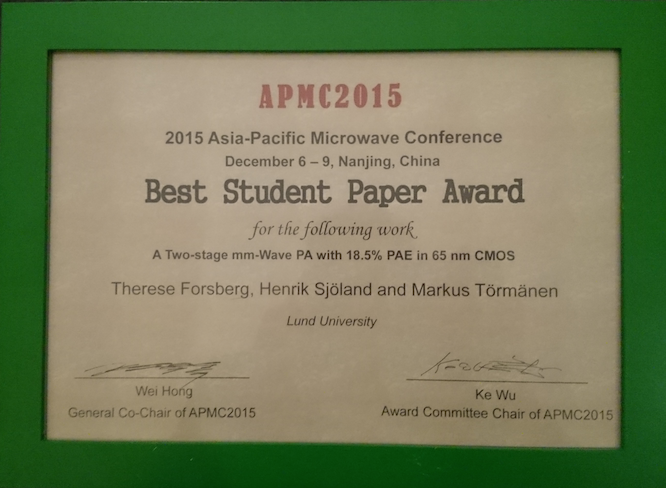
Anders scraps the coils in his RF-receivers
Published: 2015-11-27
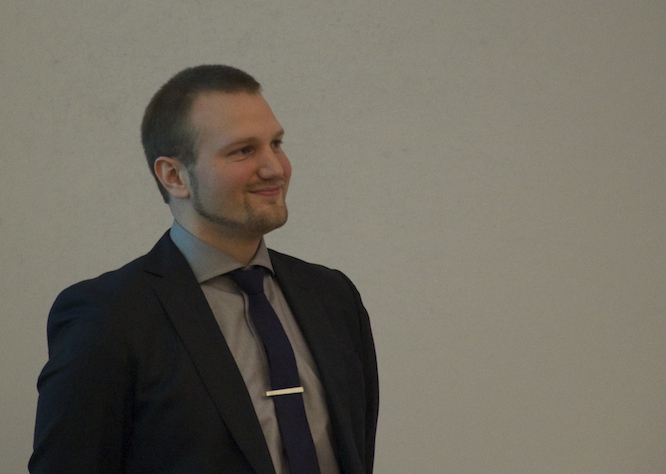 Fresh PhD Anders Nejdel.
Fresh PhD Anders Nejdel.
Streaming video to cell phones is natural to all of us today as a normal phone call was before. It is however not that easy to provide the technology solving it for small mobiles RF-paths. Furthermore, everything that aim to be implemented in consumer products must be cost effective, energy efficient and flexible.
Challenges exist, yes.
-There are lots of challenges, says Anders. To push it all and to not fall into trade-off traps is the hardest. Noise, linearity, power consumption, etc must all be treated in and efficient way. There will also always be new requirements that must be taken into account and flexibility of the systems is necessary in order to let it deal with new scenarios. Moreover, as I have learned now towards the end, it's hard to get everything to work when you have lots of different parts of the receiver on the same chip. The last chip I did also had an analog-to-digital converter which posed certain problems. This was something we first discovered during tests, and a phenomenon that we could not reproduce in the simulator.
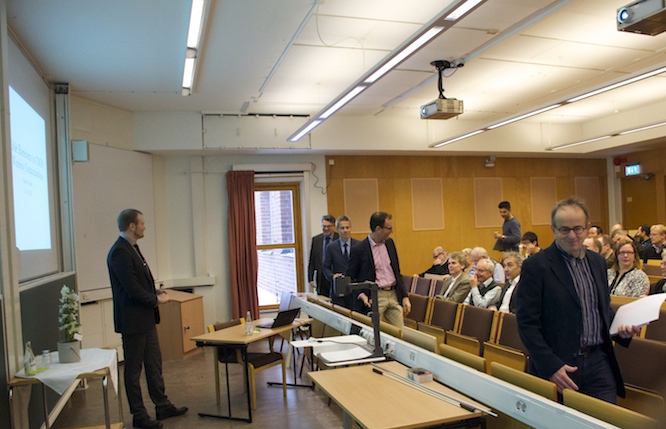 Opponent, committee and audience coming in
Opponent, committee and audience coming in
Theory and practice in good harmony
In his doctoral thesis, Anders Nejdel presents new approaches and ideas for future receiver frontends. As so often in EITs research is not just a question of calculations, theory and circuit-design. Anders solid work also produces actual CMOS circuits and verification of the results with measurements.
In his very educational presentation, EITs recent doctor explains the methodology where components become circuits followed by fabrication into chips ending up at the lab where evaluation begins, a process which in total takes about half a year. In terms of components, we would prefer not to handle coils since they require space, something that Anders consistently stresses through his research. When asked what is so difficult with coils in microelectronics, Anders tells us:
-Size. Modern circuits optimized for digital applications are always driving transistor size downwards in order to reduce the area and power consumption. This is unfortunately bad for "analog components". Coils do not diminish in size and can take a lot of space. Because the price / area is constantly increasing, this means that price / coil is also constantly increasing.
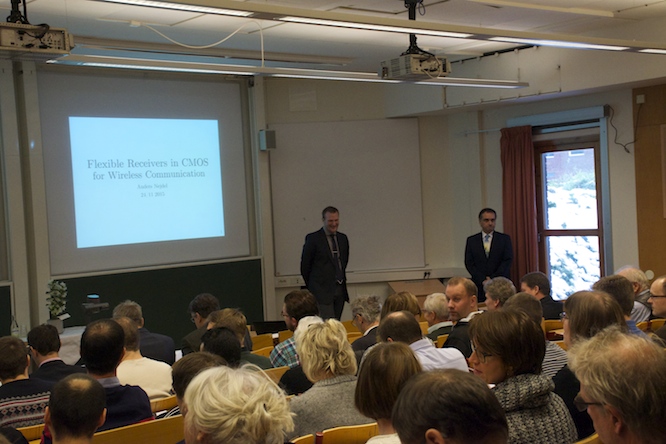
Pietro Andreani introduces Anders Nejdel and his thesis
Dynamic world
During the presentation we also hear of a straight-on energy comparison in order to understand how much difference there can be between a phone's sent and received signal-power. Power from nuclear power plants is compared with the same thing from a LED lamp. Showing the dynamics of the situation! And in engineering-lingo, what does it mean?
-Around 100 dB, Anders tells us. If you think that a nuclear power plant (size Ringhals) can deliver about 3 GW, and an LED lamp draws about 10W, 100 dB would be the difference between a LED light and the 100 nuclear power plants!
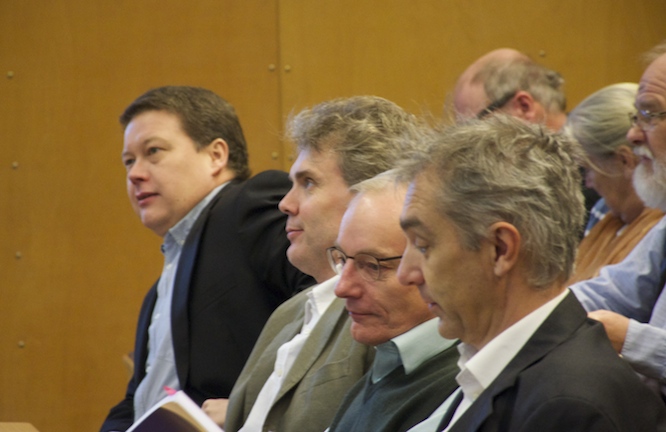
Important researchers for inspiration: Markus Törmänen, Henrik Sjöland, Sven Mattisson, Bo Bernhardsson
Prestigious invitations
The thesis contains five scientific articles, all based on the results of measurements on 65 nm CMOS circuits and Anders has studied different solutions for flexible receivers. One of the articles shows how to implement a full receiver path from the RF input to digital output.
In the introduction of the disputation, Pietro Andreani mentioned that some of the dissertation articles have been invited to prestigious journals and we are naturally curious about this.
-I have received three invitations, Anders tells us with joy and proudness! Springer Analog Integrated Circuits and Signal Processing. What I am really proud of are the two invitations to the IEEE Journal of Solid-State Circuits (top magazine within integrated circuits). The second article to JSSC was submitted the day before the defense.
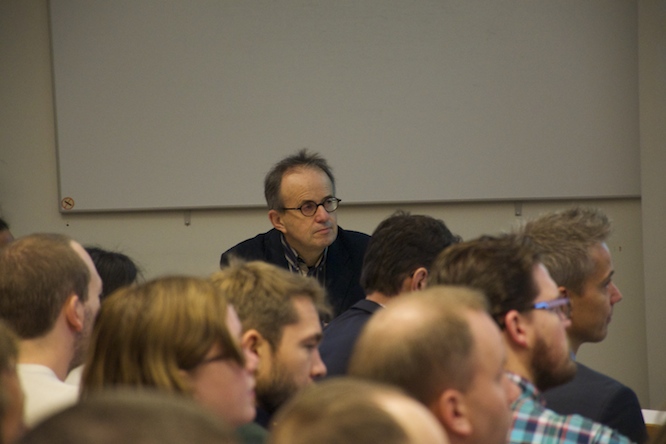
Opponent Eric Klumperink and...
Perhaps postdoc…
Asking about "what's next", Anders let us know that it will most likely be a post-doc and "some other stuff", leaving us unaware of details. -And who knows, perhaps industry work in the future, we'll see, Anders says.
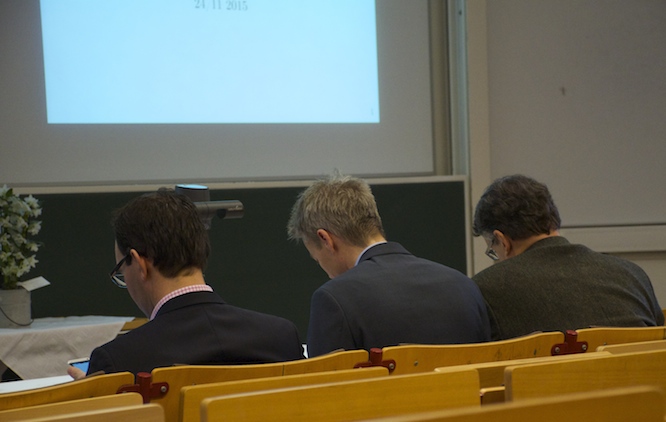
...the committee prepare for questioning
Work is not all
There is also a life outside. In that, our fresh PhD is mostly ocuupied with family business. They all live in Kävlinge and his partner Jennie and their daughter Livia get his most attention. Together, they will probably all join in future countryside- and travelexperiences , something Anders like. Travelling has already been a nice part of his research work.
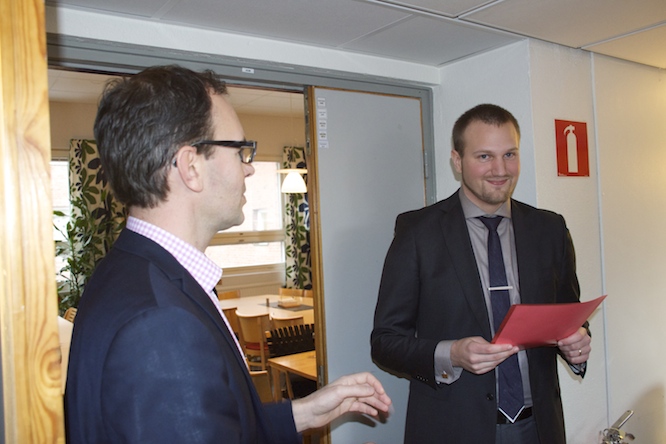
Certificate
Prefer electronics to biology and chemistry.
-I grew up in Svenljunga, a small village outside Borås, Anders says. After moving to Skåne for high-school, I stayed here. Military service was done in Revinge and followed by technical nanoscience in Lund. It was too much biology and chemistry for me however. I longed for applied sciences and moved to electronics. I was determined to move to industry after my masters but when an opportunity for PhD-studies appeared, I found it exciting. Another four years at LTH! During my research studies I also took part i an exchange program at Marvell, Pavia in Italy for 4 months last year. Lot's of fun and I learned a much.
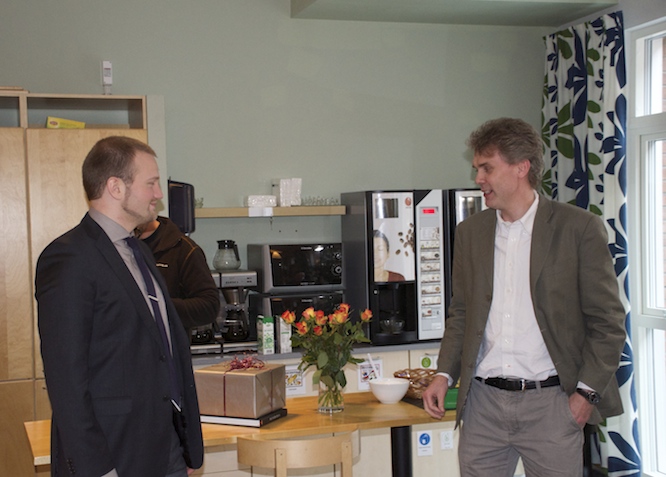
Congrats from supervisor Henrik Sjöland
EIT congratulates to PhD-exam and wish good luck in coming careers!
Text and photo: Anders Borgström
2015-11-19 Viktors trappa invigd.
Published: 2015-11-19
Officiell invigning av dörren och trappan från EITs fikarum till innergården genomfördes medelst bandklippning av prefekt Daniel Sjöberg under torsdagens informationsmöte. Nu är det fritt fram att äta, fika och lösa världsproblemen i friska luften.
Open Campus i Helsingborg
Published: 2015-11-16
Nyligen hölls det fjärde Open Campus i Helsingborg. Campus dörrar öppnas för alla som är intresserade och nyfikna på dagsaktuell och samhällsrelevant forskning.
Fler än 4200 studenter och över 200 medarbetare bedriver dagligen utbildning och forskning i nära samverkan med region, myndigheter och näringsliv. Dessutom finns det fler än 120 studenter från 30 länder på plats och forskare och lärare från många olika länder. Här utbildas framtidens modevetare, kommunikationsstrateger, socionomer, ämneslärare, högskoleingenjörer och ledare inom servicesektorn.
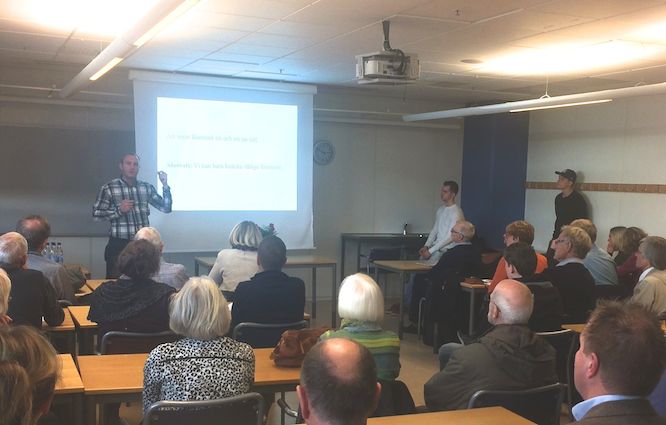
Martin Hell, EIT, föreläser om lösenord. Bild: Erik Larsson
Tre EIT-presentatörer var på plats. Nedelko Grbic pratade om hur man kan förbättra vår hörsel med hjälp av mikro-datorer, Martin Hell beskrev hur ett lösenord knäcks och hur man skyddar sig och Erik Larsson undrade om man kan lita på elektronik. Stort intresse med mycket folk på plats.
Förutom EITs presentationer bjöds föreläsningar om allt från servicekultur, begriplig pensionsinformation, ungas politiska deltagande i sociala medier, handel och trender i en global värld, kunskap i skolan och mycket mer.
Text: Anders Borgström.
2015-11-09 VR Grants announced. Three to EIT!
Published: 2015-11-09
VR have published this years grants and among them are three EIT-ones.
Erik Lind: "Endimensionella högpresterande III-V nanotrådstransistorer." 3 MSEK
Thomas Johansson: "Framtida kryptografiska primitiver från LWE och relaterade problem." 3,4 MSEK
Fredrik Tufvesson: "Fasbaserad positionering med hög noggrannhet." 3,6 MSEK
Full list here.
Congratulations!
Aiming for bright collaboration with MAX IV
Published: 2015-11-02
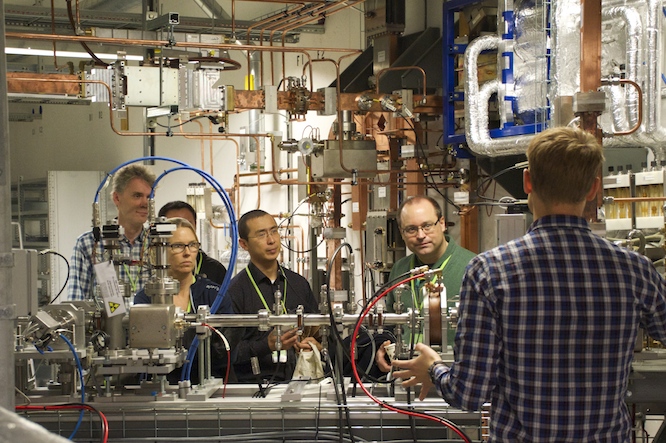
Earlier this year LTH's management queried our researchers on how to involve in coming-up ESS- and MAX IV-activities. A number of entries arrived describing areas and possible partnerships that could have a potential in fruitful research collaborations. This goes for both accelerator technology and experiments that will be performed in the MAX IV beamlines during the coming years.
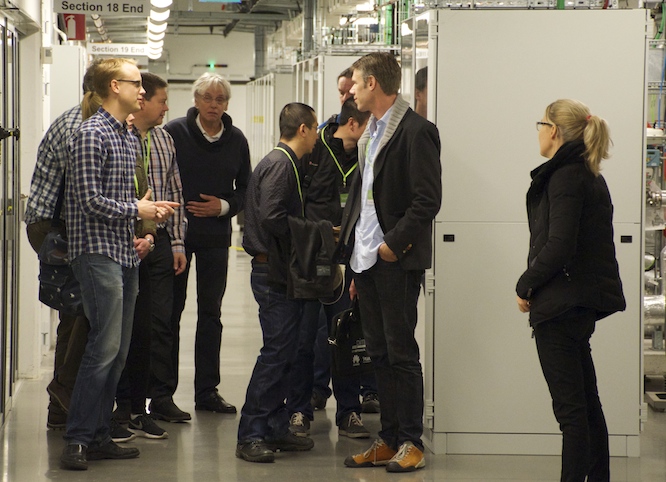
A variety of proposals were posted, among others they dealt with characterization, accelerator design, IoT, signal processing, big data, cloud, assembly technology, FPGA and more. There is no lack of ideas and creativity in thought.
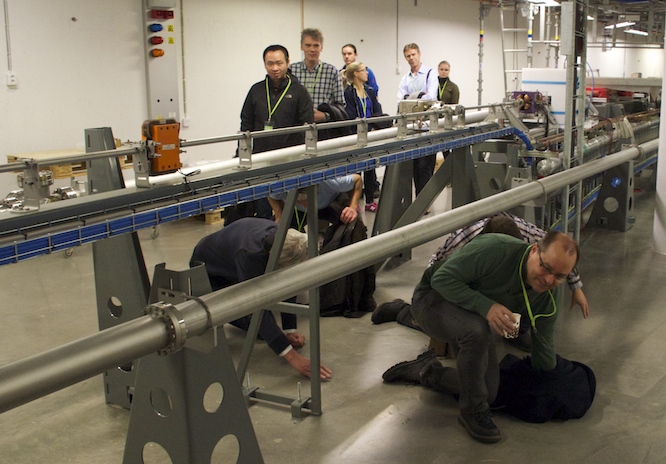
In order to boost dialogue, we arranged a trip to MAX IV. The site is in good progress towards initial operation and the research groupleaders together with those who had shown collaboration potential all took the local bus (nr20!) to the brand new site.
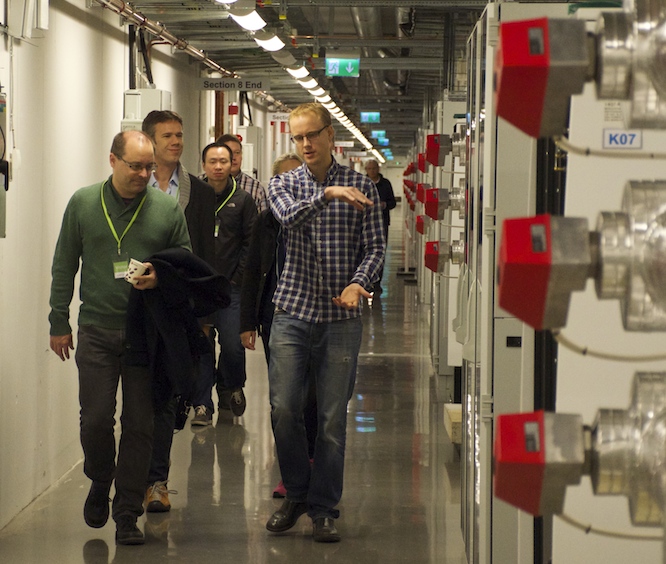
Up there, a short specialized lecture and a guided tour took place, focusing on electronics, RF and electromagnetic fields. In the MAX IV- and ESS-accelerators, it's much about pulling and kicking charged particles with help from electromagnetic fields, an area EIT is pretty well familiar with. Another interesting area for us is how to handle the huge amount of data being produced through the experiments in the beamlines. Big data concerns with regards to storage, processing, transport, presentation and more are things that also tune in to many of EITs research areas.
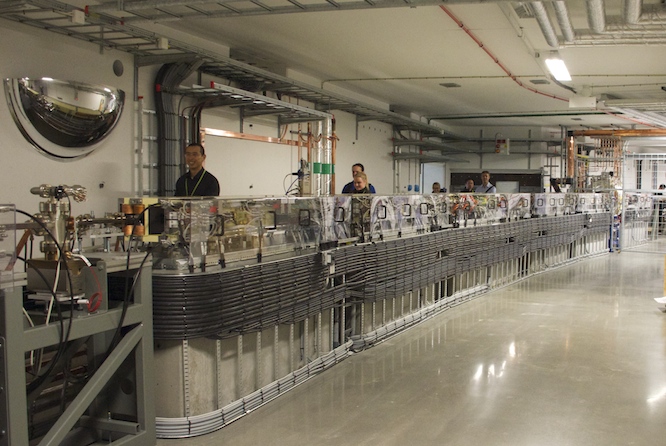
The MAX IV lab consists of 2 storage rings with electron energies and circumferences of 1,5 GeV/96 m resp 3 GeV/528 m. The produced electrons are accelerated firstly in a so called LINAC (Linear accelerator) and the being injected in the storage ring. The presentations gave a very good overview of how it all works.
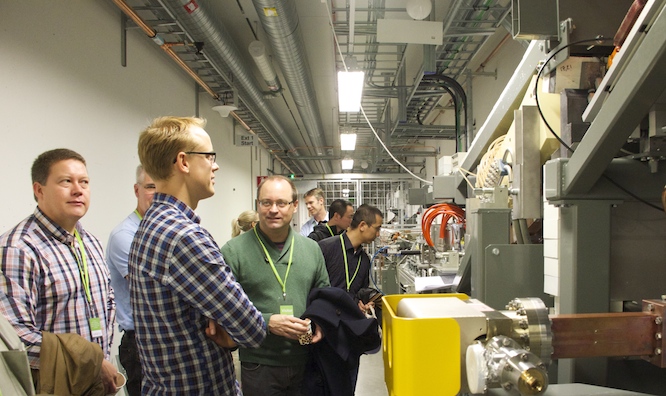
The MAX IV technology evolves from MAX II an MAX III and the synchrotron light is created when the electrons are accelerated in the circular movement in the rings. The Max IV light will be much more energetic than in earlier labs which will provide a full set of new opportunities in coming experiments. We will simply see more and the "lightbulb" is benchmarking very well on the global arena of accelerators.
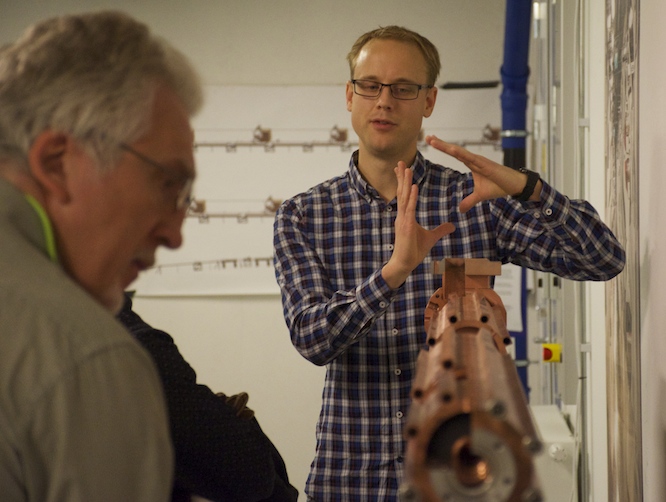
The meeting, the presentations and the guided tour were initial steps to create preconditions for a fruitful dialogue between our research teams on both sides. The later ESS-collaborations will probably be even more interesting (some are already running) but a field trip to that site would today more focus on excavators and construction technology. Perhaps something for LTH V-section?
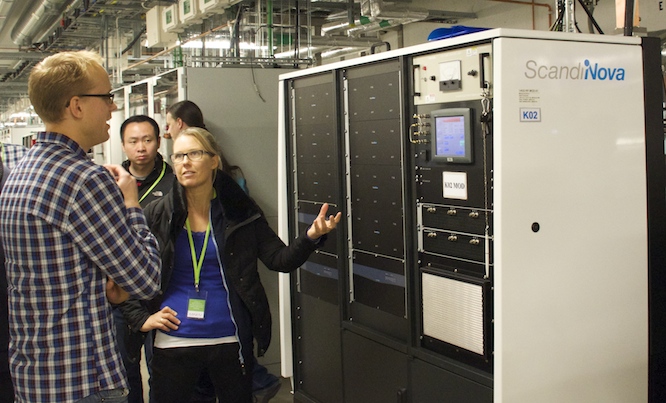
A warm thanks for a very nice and high technology guidance goes from EIT to Sverker Werin, David Olsson and Lars Malmgren. And thanks also to Sara Thorin who organized it all but unfortunately not attended because of sick child at home.
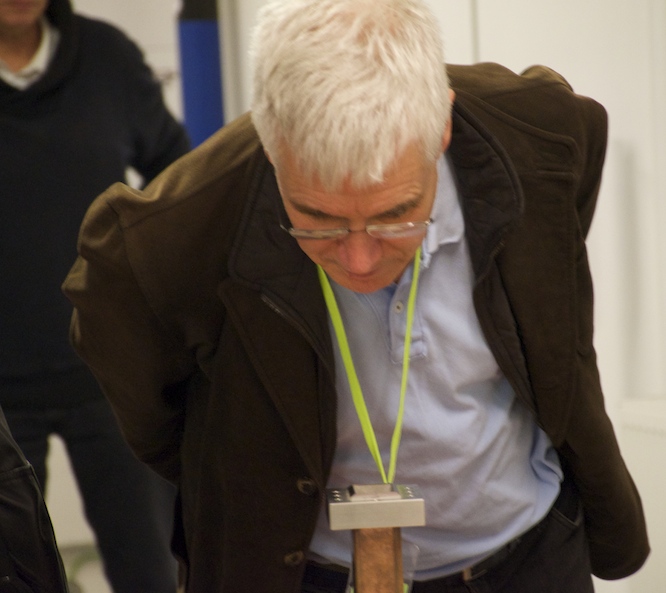
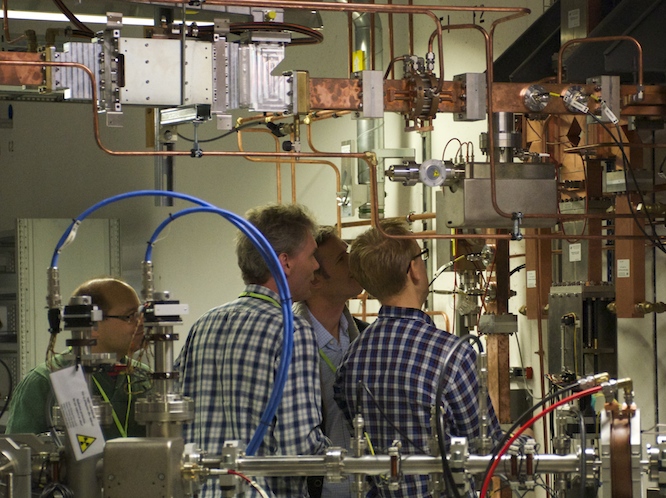
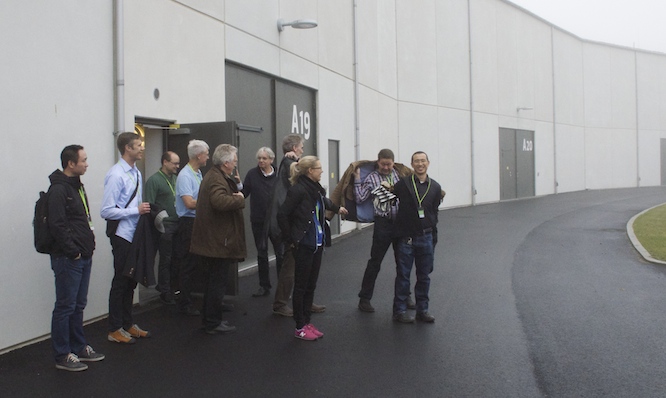
Text och bild: Anders Borgström
InfoCOM 2015 med rymdtwitter och virtuella pengar
Published: 2015-10-20
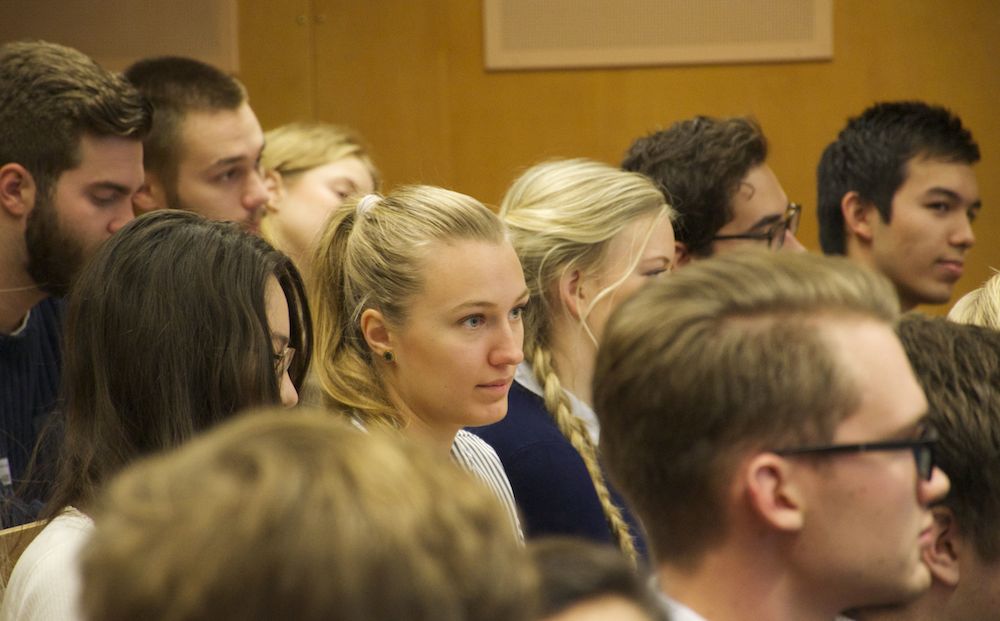
Koncentrerade åhörare på InfoCOM 2015. Bild Anders Borgström.
Kursen Kommunikationssystem avslutades häromdagen med elevkonferensen InfoCOM 2015 där studenterna presenterade resultatet av sina fördjupningsstudier. Förutom examen och presentationer efter 6 v arbete så är det en "konferensträning" för deltagarna där man också granskar varandras rapporter, ställer frågor, minglar i fikapauser och annat som hör till större vetenskapliga events.
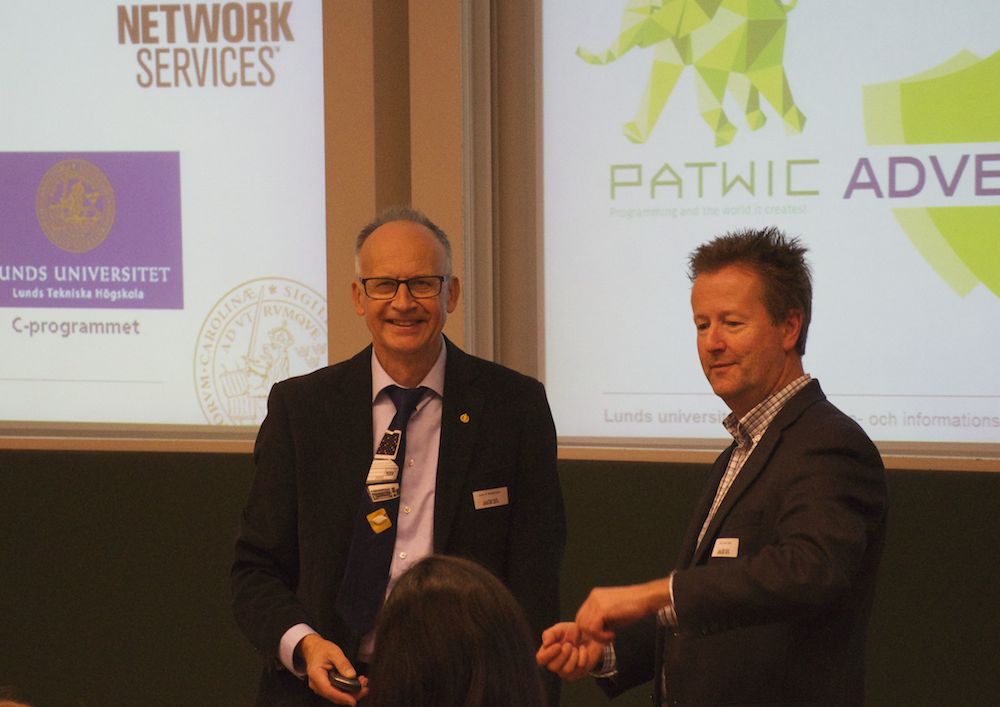
Konferensordförande Jens A Andersson och Key-note speaker Carl-Axel Alm. Bild Anders Borgström
Universitetsadjunkt Jens A Andersson inleder konferensen med att prata om kommunikationssystem och vad studenterna kan förväntas ha för kommande arbeten och uppdrag i framtiden. Detta är som sagt examen och skriftliga rapporter är inlämnade och ligger nu i proceedings på USB-minnen.
Som på varje viktig konferens kommer det sedan en öppningstalare eller s.k. key-note speaker, en roll som detta år besätts av Carl-Axel Alm från Axis Communications. Dessutom får alla veta vem som betaler kaffe, kakor och mackor m.m. I år ser vi Sony, Anritsu, Network Services, Patwic, Advencia och sist men inte minst Lunds Universitet på sponsorsliden.
Carl-Axel Alm eller “Cacke" inleder med att säga grattis till studenternas val av LTH vilket i hans fall ledde till bra jobb och roligt liv. 1985 då han skrevs in stajlade man med VAX-terminaler, Macintosh Plus och alla möjliga fonter i sina rapporter. Efter 22 år på Axis har han varit med om en spännande resa som tagit företaget från leverantör av 6809-baserad diabildsväxlare och IBM printservrar till att bli marknadsledande på nätverkskameror med mångmiljardomsättning i bokslutet. Förutom kameror och mjukvaror så utvecklar företaget även sina egna ASICar vilket sysselsätter 20 utvecklare. Japanska Canon håller successivt på att ta över ägandet vilket ger stabilitet i en stor värld samtidigt som kreativiteten tillåts fortsätta. Man har totalt 800 utvecklare i Lund och en uppskattad rekryteringsväg in till företaget går via exjobb där ca 60 examensmogna studenter varje år får en inblick i företaget och inte sällan också ett kul jobb efteråt. Man anade viss lockelse i publiken.
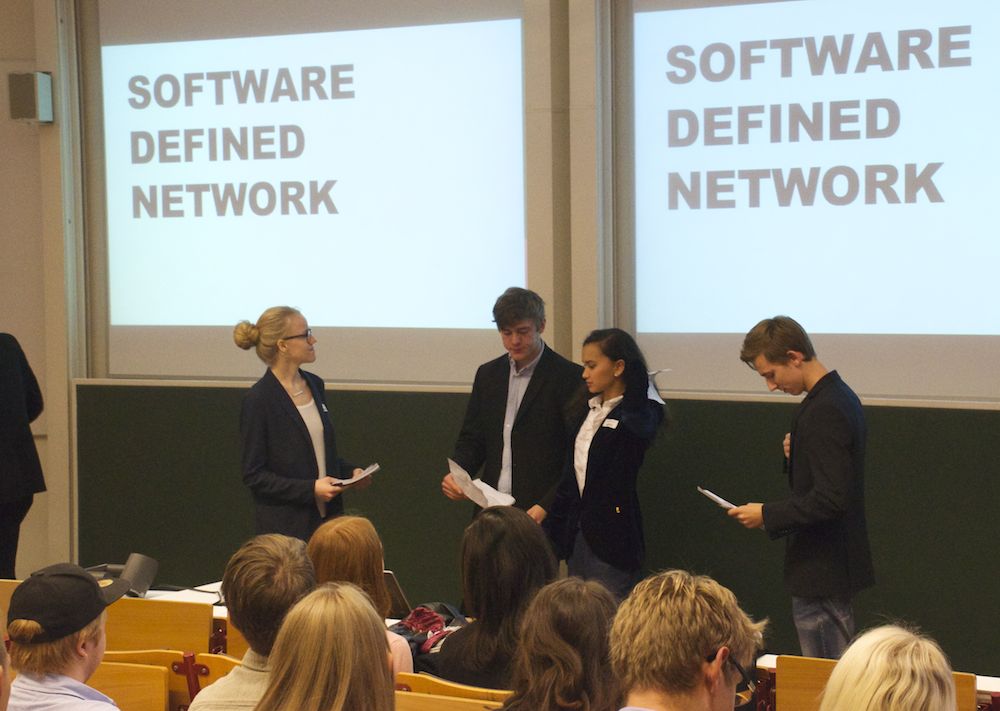
Presentation av framtidens nätverk. Bild: Anders Borgström
Efter keynoten var det dags för studenternas presentationer. Snyggt uppradade, välklädda och med trevlig norsk brytning inleds den “riktiga” konferensen med ämnet SDN eller Software Defined Network, ett område som handlar om abstraktion för dataplaner, arkitektur för nätverk, kontrollplan, dataplan, API er däremellan m.m.. Vi får höra att det är en flexibel och utvecklingsbar plattform där nätverk kanske kan bli som elektriciteten hemma i framtiden. Man betaler efter förbrukning helt enkelt. Om jag behöver lite mer bandbredd till filmen eller lägre fördröjning till spelet ikväll så cashar jag in några tior till. Så kör vi som vanligt i morgon igen.
Nästa gäng ställde på skoj frågan om det gick att twittra i rymden eller kanske lite mer specifikt hur vi ersätter det gamla hederliga TCP/IP-protokollet när de fysiska avstånden mellan nätverksnoderna blir väldigt långa. Lösningen kan då vara s.k. Delay Tolerant Networks (DTN), ett nätverk som syftar till att lösa problem som uppstår i extrema miljöer. Som rymden. DTNs arkitektur följer OSI-modellen och man samlar upp data i stora “bundles” istället för att skicka många meddelanden.
Efter dessa presentationer fick auditoriet veta mer om optiska nätverk, NFC-transaktioner, LTE, kognitiv radio, Bitcoin och andra spännande områden som ingenjörer med kunskaper i kommunikationsteknik kan tänkas arbeta med i framtiden. Summerat: En lyckad kurs, en lyckad konferens och studenter med nya kunskaper och konferenserfarenhet i bagaget.
Text: Anders Borgström
Hackar för att hjälpa mänskligheten
Published: 2015-10-08
I början av december arrangeras ett så kallat hackathon på Lunds Tekniska Högskola. Då samlas omkring 200 personer med intresse för design och programmering i Kårhuset för att under en helg ta fram lösningar som hjälper andra människor ? genom...
? Att folk får upp ögon och intresse för öppen källkod och att man även som teknik- och dataintresserad kan hjälpa till och göra en skillnad, både globalt och lokalt.
Läs mer om Openhack: http://www.openhack.io
Läs mer om LUFOSS - Lund University Fund for Open Source Software: http://www.lth.se/lufoss
Water taps and quantum mechanic tunneling in Martins world of nano.
Published: 2015-10-05
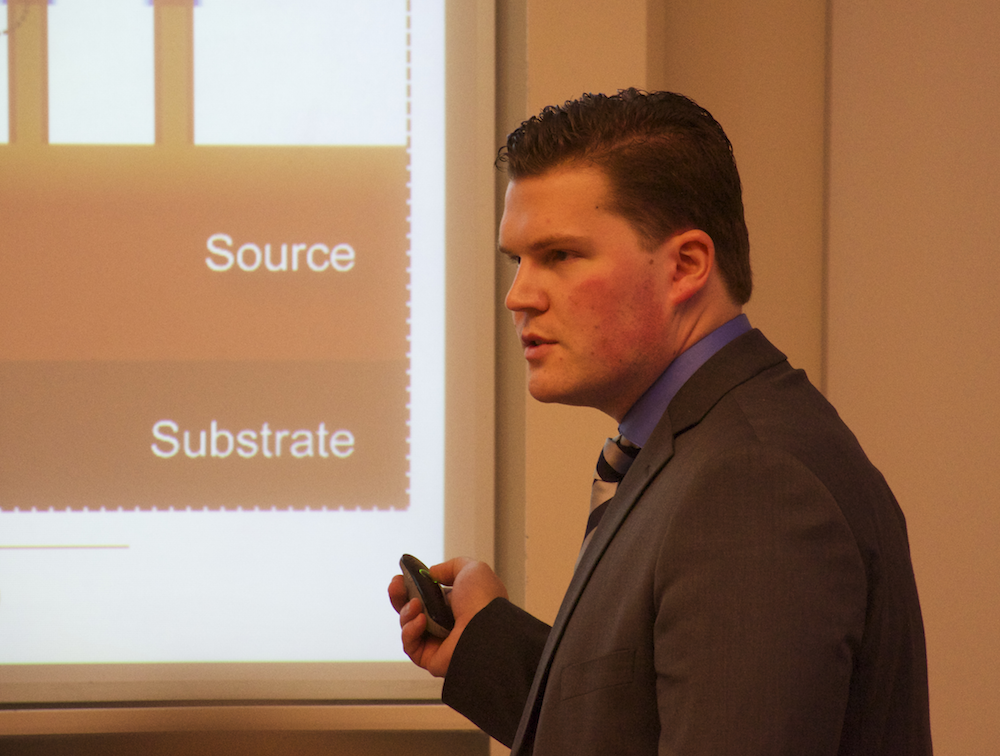
How does one explain a transistor to someone, if not with a water tap? The gate is the handle, the water work is source and the sink symbolises drain. That's the thesis in a nutshell! Martin Bergh does however tell us a little more about his research. Like for example how few atoms between source and drain can lead to quantum mechanical tunnelling effects. Maybe slightly harder to comprehend than the drain example.
Faster and more energy efficient with nanowires
In his research, Martin has studied the usage of nanowires in electronic components and circuits. Nanowires are cylindrical objects with dimensions of only a couple of dozen nano meters. By designing these wires out of semiconductor material and building transistors out of them, you can potentially achieve faster and more energy efficient electronics than through conventional methods.
Has produced circuits
“We were a couple of people working on these nanowire transistors, but I was mainly focused on the issue of how to build them and how to come, in practice, as close as possible to the theoretical performance that had been calculated. During the course of my work on it, I have developed new methods of transistor production, new ways of finding elements in the transistors that reduce the performance and, in addition, designed electrical circuits that use the nanowire transistors”, Martin says.
Exciting topic
Martin was previously studying for his masters degree on the technical nano science program and when an opportunity arose for Martin and Kristofer to do their master theses with the EIT nano electronics group, it eventually led to a role as a research assistant, and after that, a PhD.
”The mix of electronics, physics, maths, measurement technology and chemistry is both fun and challenging”, Martin tells me. ”Ever since school, I've enjoyed maths and the natural sciences and I haven't found it that hard, so continuing with it at university seemed like the right choice.”
From Västergötland to Skåne
He's 29 years old and originally from Lidköping, in the North of Västergötland, but has after all these years moved down to Lund and Skåne. After some initial trouble understanding the local accents of the lecturers, he's now able to handle it a bit better. And Lund is nice.
Larger contacts and better performance
So what advantages do nanowires have, compared to planar technology? “Maybe it can enable you to make larger contacts for your transistors and thereby making the contact resistances smaller. If you can freely exploit the extra dimension in vertical direction, then you get an advantage in performance. Same thing could happen if you use lateral transistors with nanowires stacked on top of each other”, Martin continues.
Thin and short is the target
The nanowires that the team currently have in their lab are about 30 nm thick and with a height of 6 to 700 nm, they can get sticky and vibrate. “We want them shorter, but lower than 400 nm, which is probably not possible in today's lab. Stacking 5 to 6 transistors in every wire could also be possible, which is tricky to get right but could be done if there's some progress in production methods”, Martin cautiously adds.
When asked why the semi conductor InAs is better than silicon, Martil tells me that it has to do with the mobility of the electrons and the so called injection velocity. Both parameters measure how fast the electrons can flow through the material and faster transistors are always a good thing.
And now things are getting small
The smallest transistors today are around the size of ten atoms. “Quantum mechanic tunneling” can occur and can cause a short circuit between source and drain, resulting in transistor failure.
“Gate lengths of around 3nm (equivalent to 20 to 30 atoms) is a realistic expectation according to the opponent's comments on the thesis”, Martin explains to me.
No paper with Kristofer?
“No and that's a bit of shame since we've worked together for so long, but at the moment we've been working in different fields, with me in the lab and Krille doing simulations.
What do you want to be when you grow up?
“It's a bit of an open book at the moment, with possible routes being industry, academia or starting up my own business. The important thing for me is to be able to work with research, development, experiments or theory. It feels important to learn more, gain more knowledge and help humanity develop, Martin says. “And I'd like to not have to deal with economics. But sadly you need money for research too”, he sighs.
“A fun fact is that I've contacted Arbetsförmedligen and spoken with their expert on nanowires. ;-) I'll have to see what he finds.”
EIT congratulates him on his PhD and wishes him all the best in the future.
Text/Photo: Anders Borgström
Kristofer Juggles nano research and games programming
Published: 2015-10-05
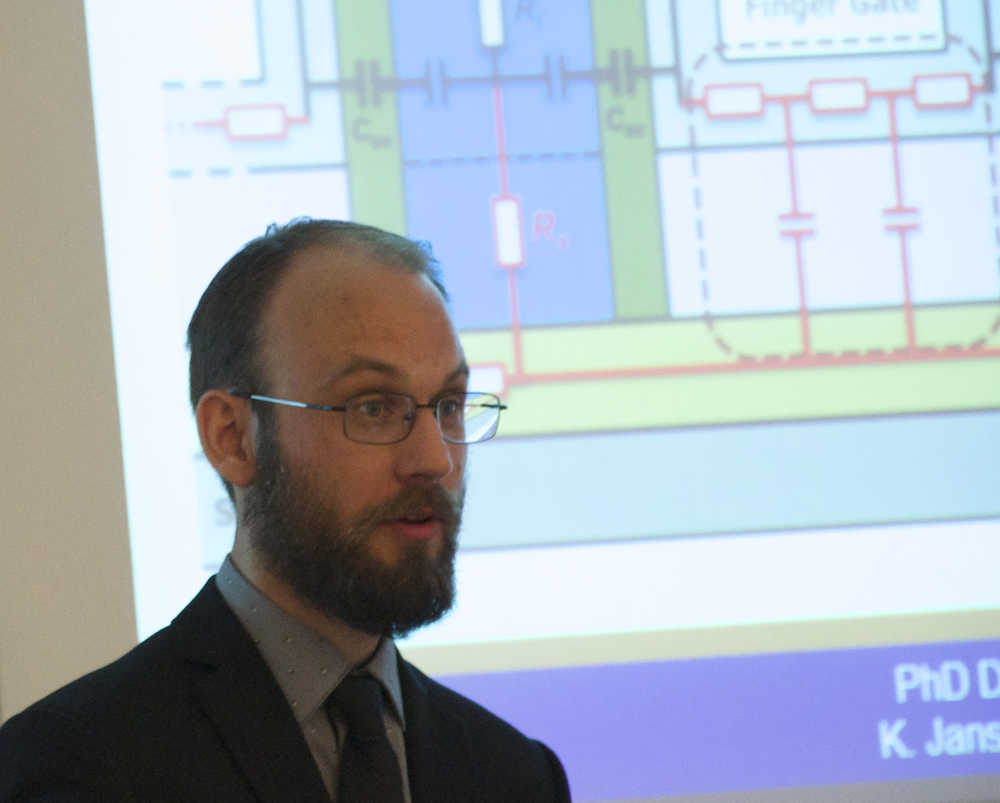
Explaining your line of work to someone isn't always easy and especially so if it happens to be something as advanced as nano threads for 3D transistor builds. One of EIT's newest PhD's however, can both build them and talk about them.
“If the party was fun? Yeah, it was nice to see all my family, relatives, friends and collegues”, Kristofer Jansson, one of EIT's newest PhDs, says. His thesis is entitled “InAs Nanowire Devices and Circuits” and despite the heavy topic, Kristofer thinks most people were able to keep up when it was presented. “I spent quite a lot of time trying to find the right level to do my presentation at. And the page on popular science in the thesis was probably the hardest one to write”, he jokes with a hint of seriousness.
Video disputation
The opponent's grilling was conducted via video link from India, a new move which will probably be used again by us many times in the future. Even if the risk of insufficient communications quality can cause certain anxiety on the part of the doctorate, it's doubtlessly a technology which will save both time and aviation fuel.
Fast, efficient and small
The research group that Kristoffer is part of has specialised in the area of ”Vertical In-As Transistors in Nano Threads” which is probably the shortest way possible of describing the topic. When it comes to this bransch of micro electronics, the key words are fast, efficient and small and we're talking unity-gain upp i THz-area. Despite this, the circuit components that are being processed are simple, fundamental ones and the more complex circuits of the future that employ this technology may 'only' use a couple of hundred GHz.
Vertical III-V instead of planar silicon
“Can you make hybrids with both nano threads and planar transistors in silicon?”, I ask. Dr Jansson informs me that other people in the group have shown that nano threads can indeed grow on silicon substrates. Researchers in Lund, however, are mainly looking at pure III-V technology and the team has Indium Arsenide as their niche, which is the semi conductor that the nano threads are built in. One of the reasons they want to use this semiconductor material is the high electron mobility it provides. “And we build vertical nano threads, as opposed to many other research groups in the world who lay them down instead”, Kristofer tells me.
Basic research that will be useful ten years from now
Asked when these results will hit the market, the answer is that it will be quite a long while. “Probably closer to ten than five years”, is Kristofer's qualified guess. “We're definitely dealing with the fundamental parts of the research here, even if we are still trying to demonstrate simple, working circuits. It's about simple inverters or amplifiers built from one to two transistors,” he tells me. “The yield is insufficient to attempt more complex circuits and a lot more process development remains before we can start applying the technology more broadly.”
From Nano to Games
Kristofer likes films (especially Star Trek), science, technology, games etc and is in fact active within the commercial games industry with MasterSpace, a game set in space that was released a couple of years back. “I've done a lot of programming through the years and in my game you fly around in space and build space ships. It can be purchased on the distribution platform Steam,” he adds with a hint of commercial savvy. He developed the whole game by himself and it took a couple of years, using C++ and a mix of various open source libraries.
With expertise in both nano threads and games development, EIT has certainly found a scientist with great technological range. Who knows, maybe the games of the future will be run on nano threads-based platforms!
From Lidköping to Lund and happy to stay
Kristofer points to Lidköping on the map and we end up just south of Vänern. Martin Bergh, who is about to complete his PhD on the same topic, is a friend of Kristofer's since high school and they now share an office here at the institute.
And what does the future hold for Kristofer? “Well... we'll see, really.” Lately, there has not been that much time and energy to spare for anything but completing the thesis.
“But industry, academia, entrepreneurship, everything's a possibility and it's all down to what opportunities that arise, of course. Lund is both exciting and pleasant to live in”, says the previous Lidköping resident who has spent the last 10 years of his life here. And after such a long time, he's happy to continue his work in the local area.
EIT congratulates him and wishes him all the best in the future!
Text/Picture: Anders Borgström
New director at the helm of this years INDEC-SoS Workshop
Published: 2015-09-24
|
Director Pietro Andreani (Piero) opened up this years Lund Circuit Design Workshop at Grand Hotel in Lund. Many interesting talks and spontaneous meetings took place at the workshop which is hosted by the VINNOVA Industrial Excellence Center in System Design on Silicon (SoS) and by the SSF-projects DISTRANT and DARE. EITs own researchers delivered new findings in different research fields and we also heard inspiring talks by distinguished invited speakers from Ericsson, Intel, Bell Labs, Sony and Twente University.
|
.. |
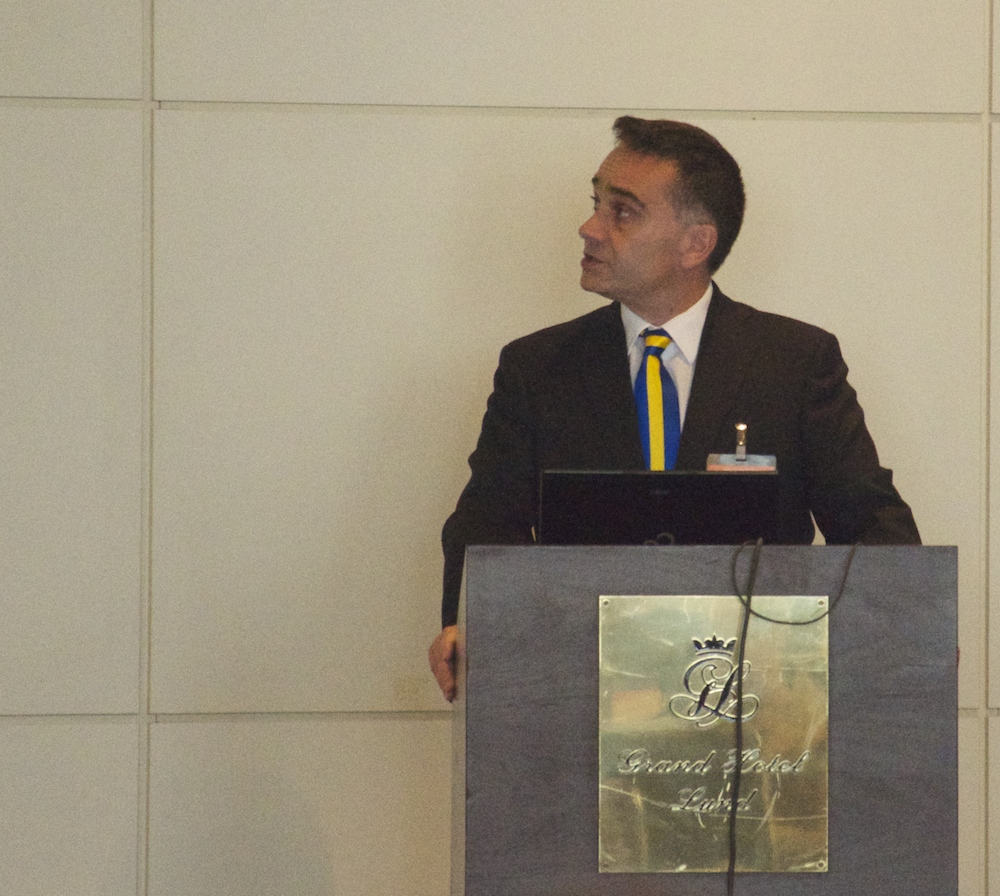 |
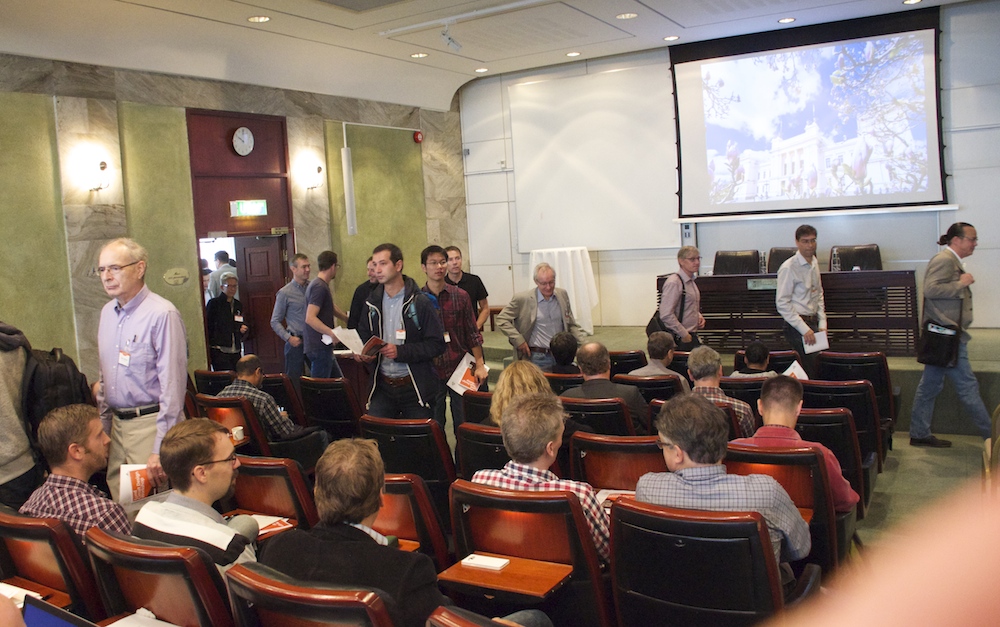
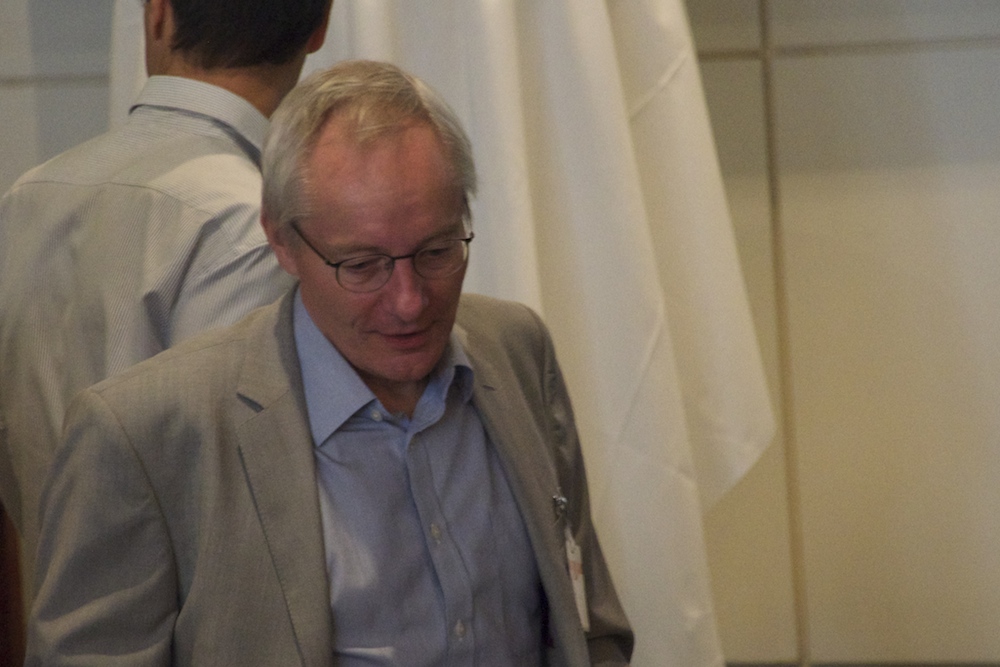
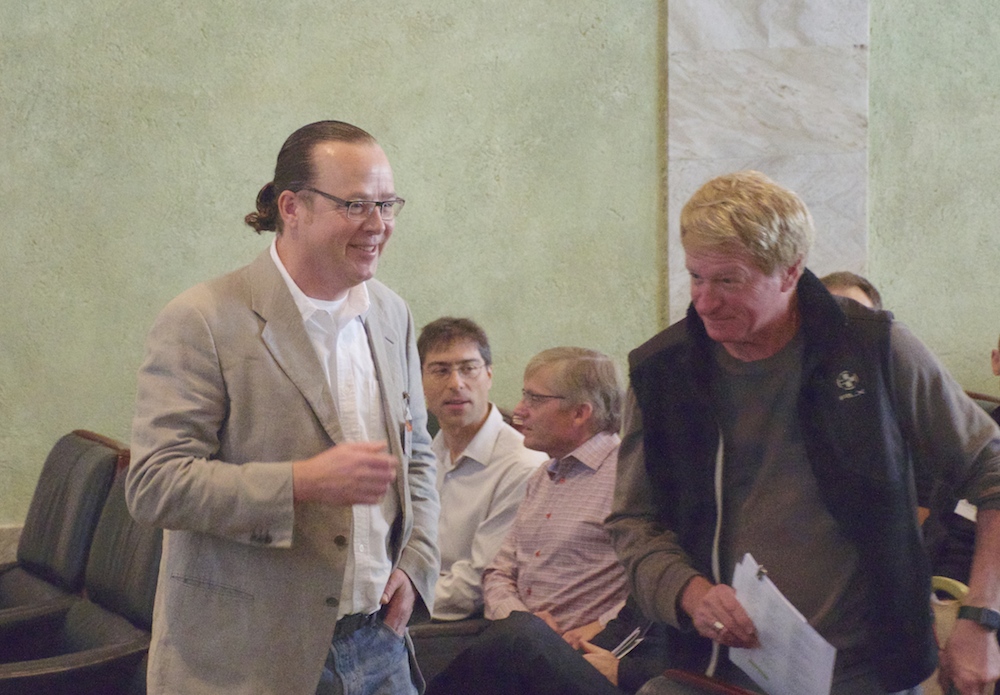
By Pieros side we saw chairman Sven Mattisson, previous center director Viktor Öwall (now LTH Dean), professor Jan Rabaey from Berkeley and other prominent attendees from near and far. This years workshop gathered around 150 people altogether.
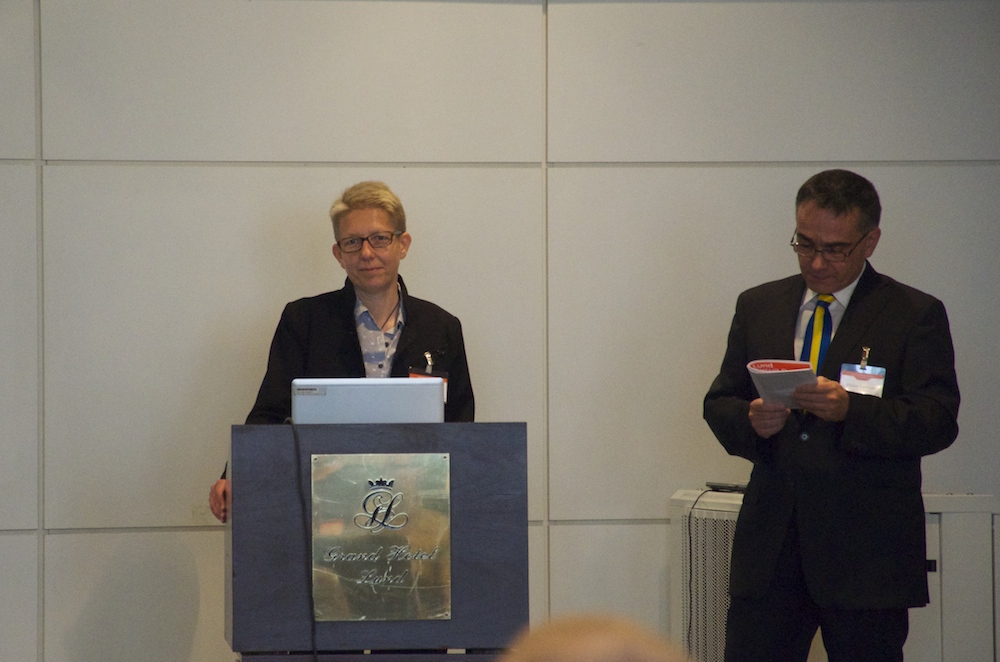
First speaker out was Dr. Ylva Jading from Ericsson and the title of her talk was “Network Energy Performance of 5G Systems”.
Ylva talked about some essential drivers for the future networks, namely Economy, Ecology and Engineering. She meant that we will face new significant grid technology leaps of the size similar to what we have seen in the transition from laptops to tablets. -What is actually 5G she asked us all and herself. Well, probably a mix of an LTE-evolution and a completely new radio access technology, acronymed NX in the Ericssonworld. -When do we see 5G in operation, she continued? Well, Japanese operator DoCoMo e.g. will definitely require 5G deployed in time for Toky Olympic Games 2020. So let’s go for that was her advice!
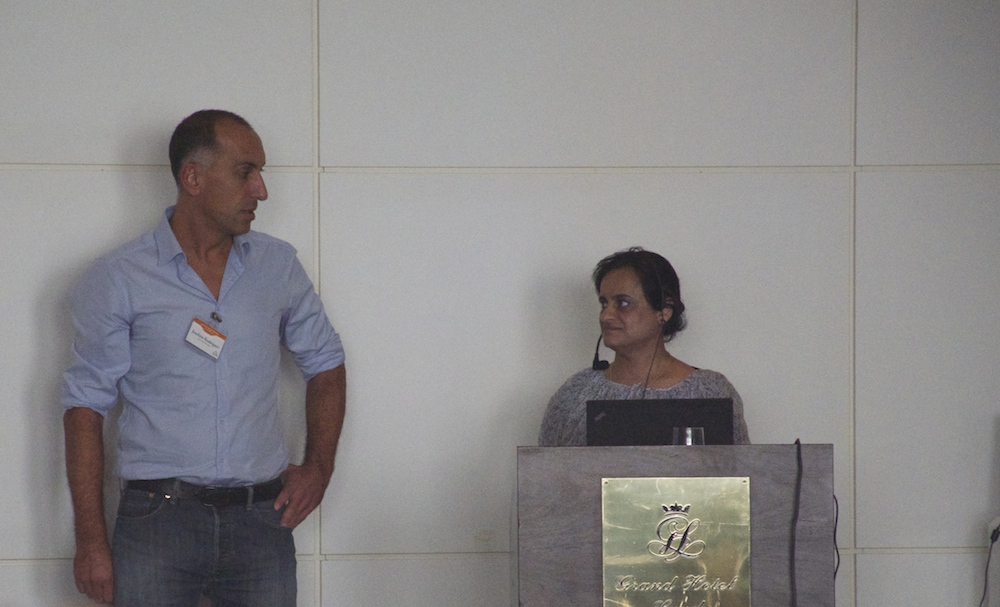
Dr. Farhana Sheik from Intel Portland, Oregon US was introduced by Joachim Rodrigues and she presented, among other things, findings around FIR-filter configurations and power-performance optimizations.
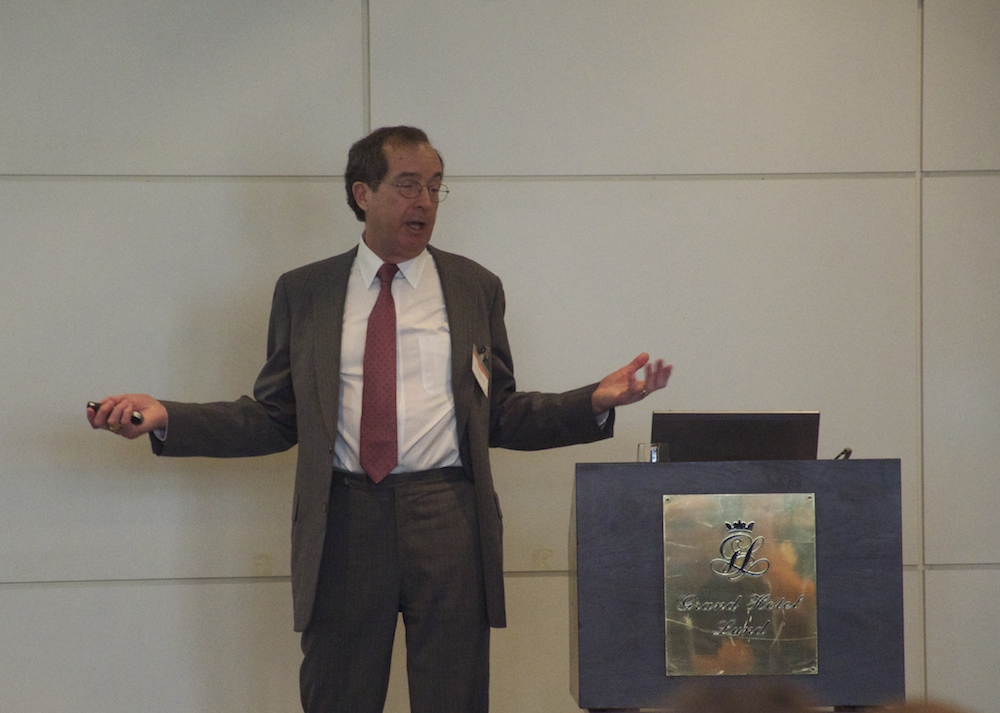
Dr Tom Marzetta from Bell Labs talked about fundamentals and system issues around the Massive MIMO technology, an area that has taken off significantly with many research projects addressing the topic from different aspects.
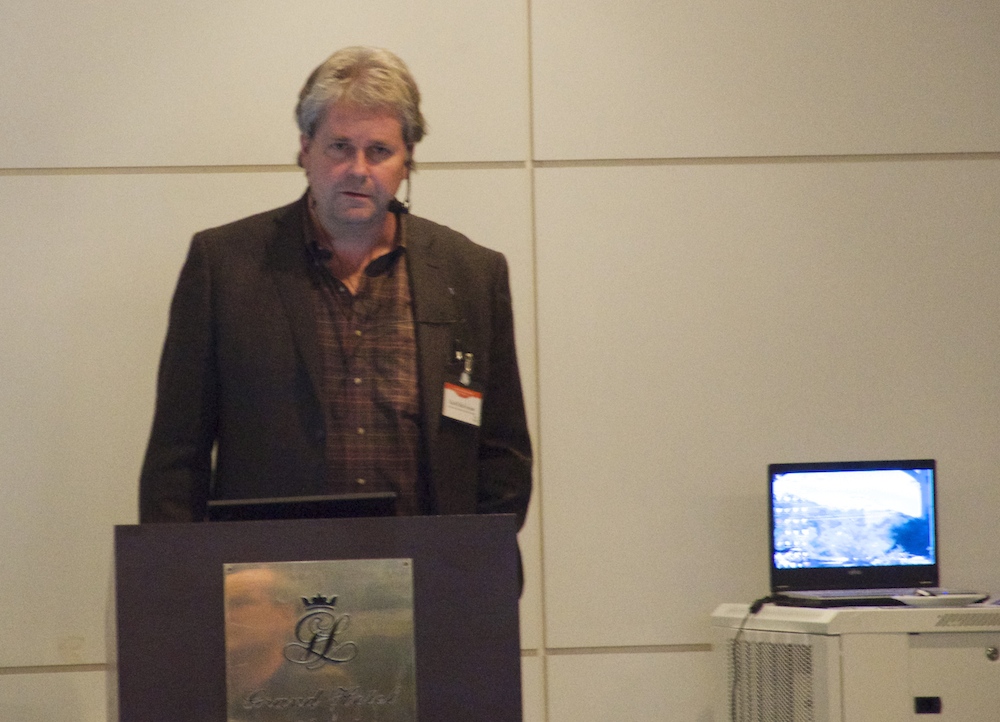
Professor Karl-Erik Årzen from the department of Automatic Control at our own university, enlightened the audience with a new large research program called WASP. This initiates from the private sphere of Wallenberg and will during 10 years focus on autonomous systems and software. The programs total budget is 1.8 BSEK.
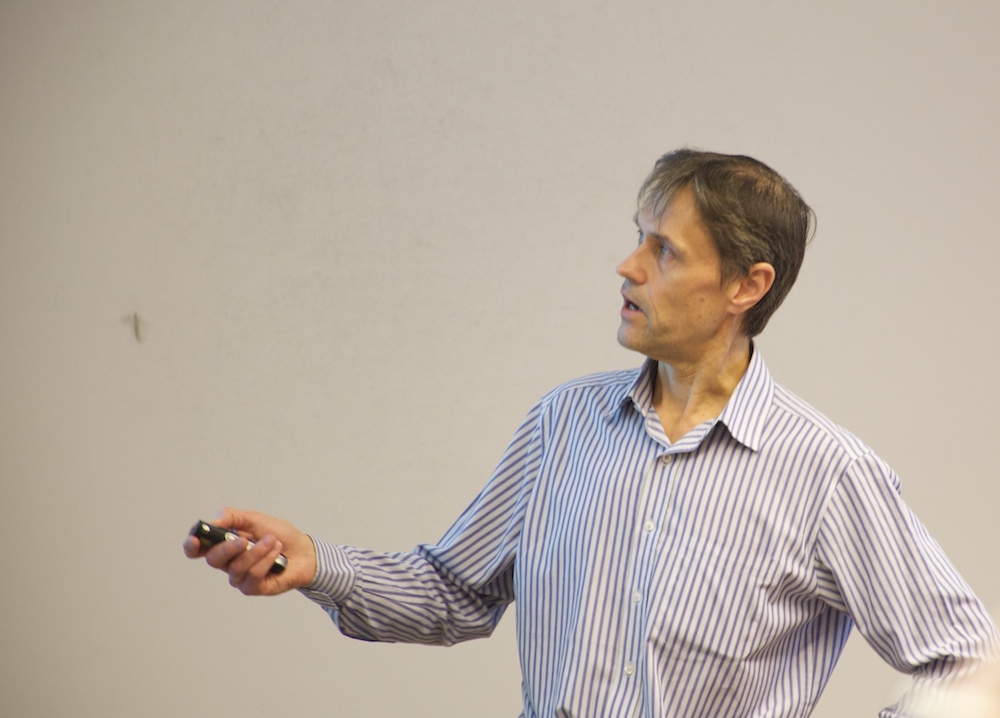
The next invited speaker in day 2 of the workshop was Chris Clifton, CTO at Sony, Basingstoke, UK. His presentation covered the challenges facing RF engineers in providing multi-mode and multi-band architectures.
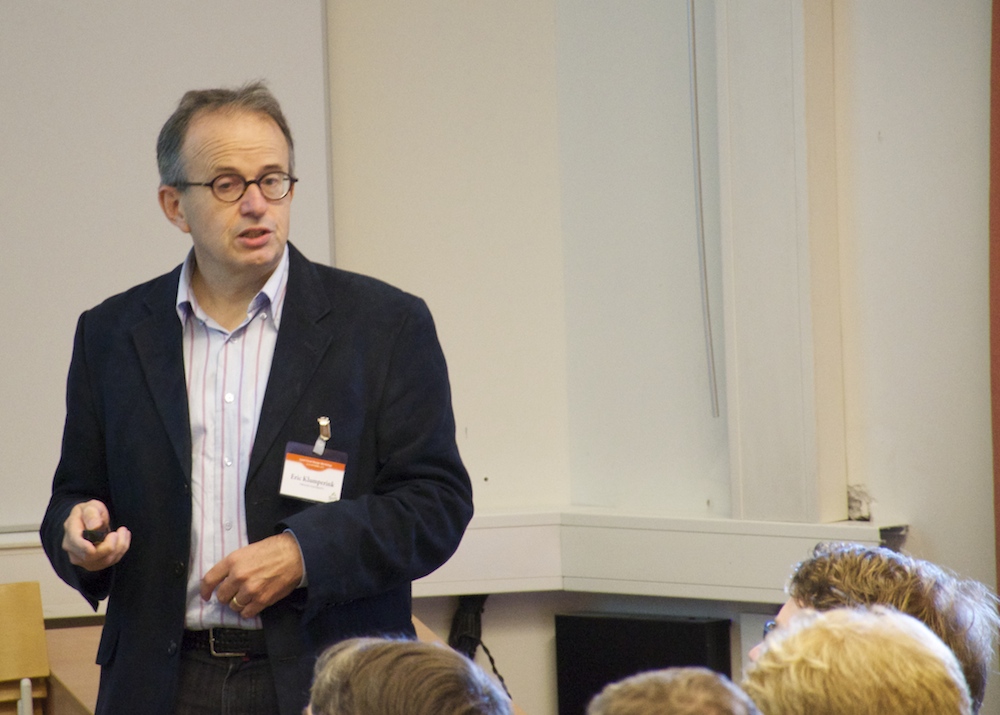
The last external speaker was Associate Professor Eric Klumperink from Twente University in Enschede, The Netherlands. He talked about challenges on interference in CMOS receiver front-ends and also described some recently proposed switched-R-C circuits that will aim to reject or cancel such interference.
The following talks were performed by EIT-speakers:
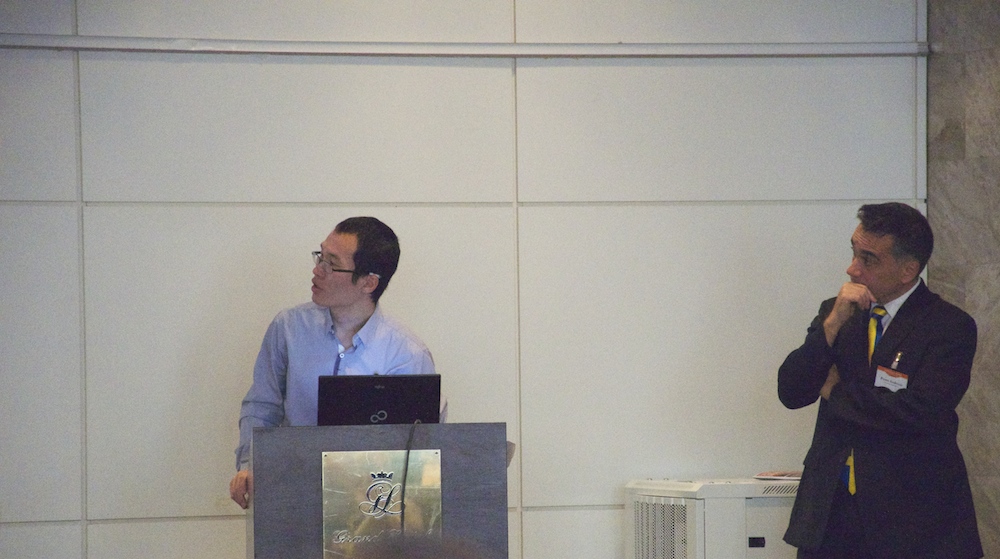
Xiaodong Liu talked about “ Power-Efficient Wideband Radio Receiver”
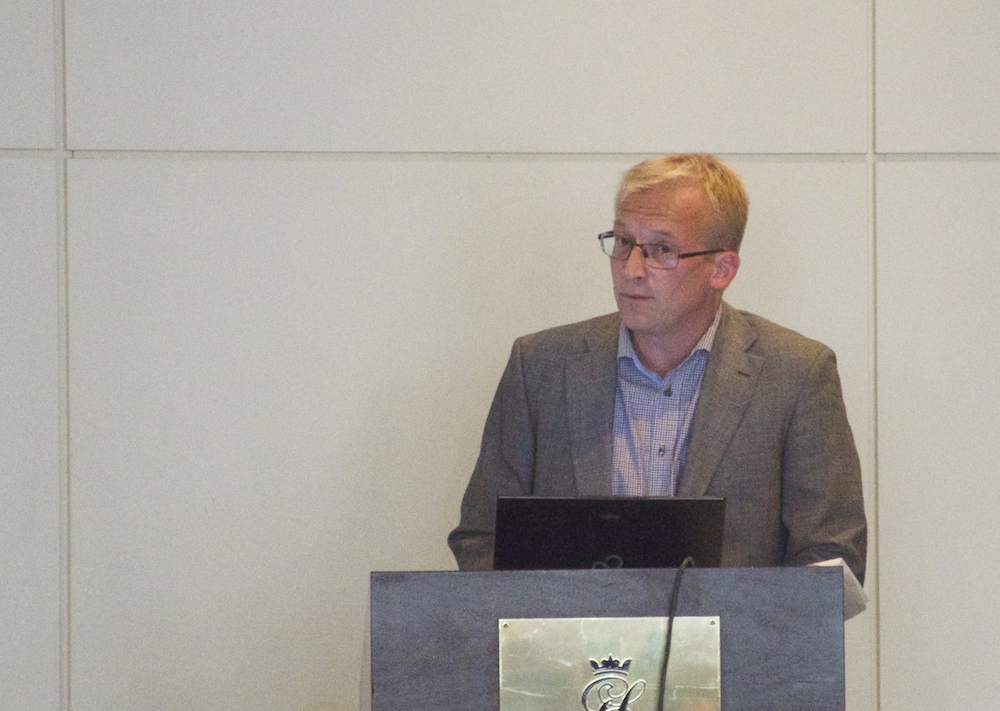
Tobias Tired talked about “SiGe PLL design at 28 GHz.
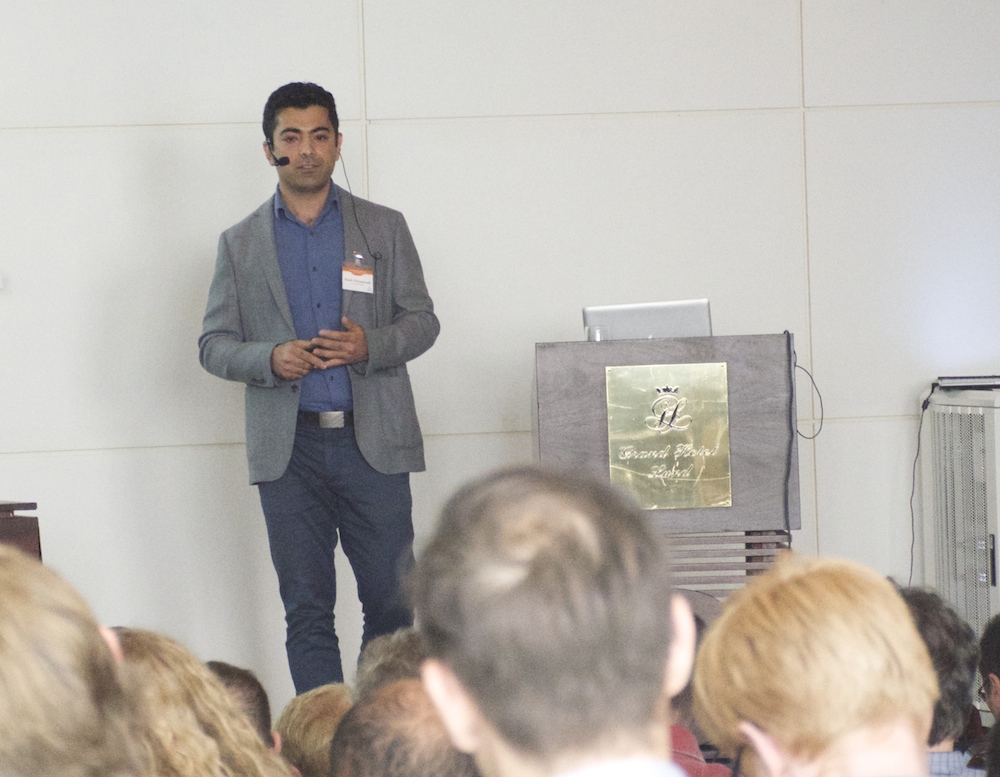
Babak Mohammadi talked about “Assist circuitry for low-power digital”
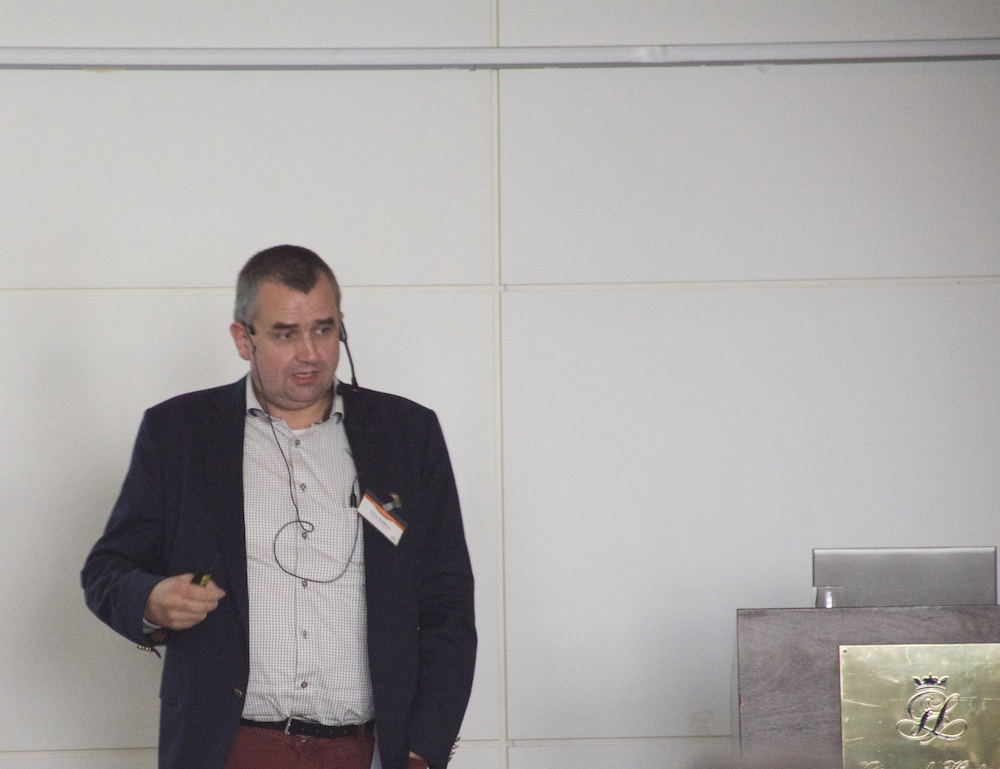
Ove Edfors talked about “Metrics for optimal front-end design”
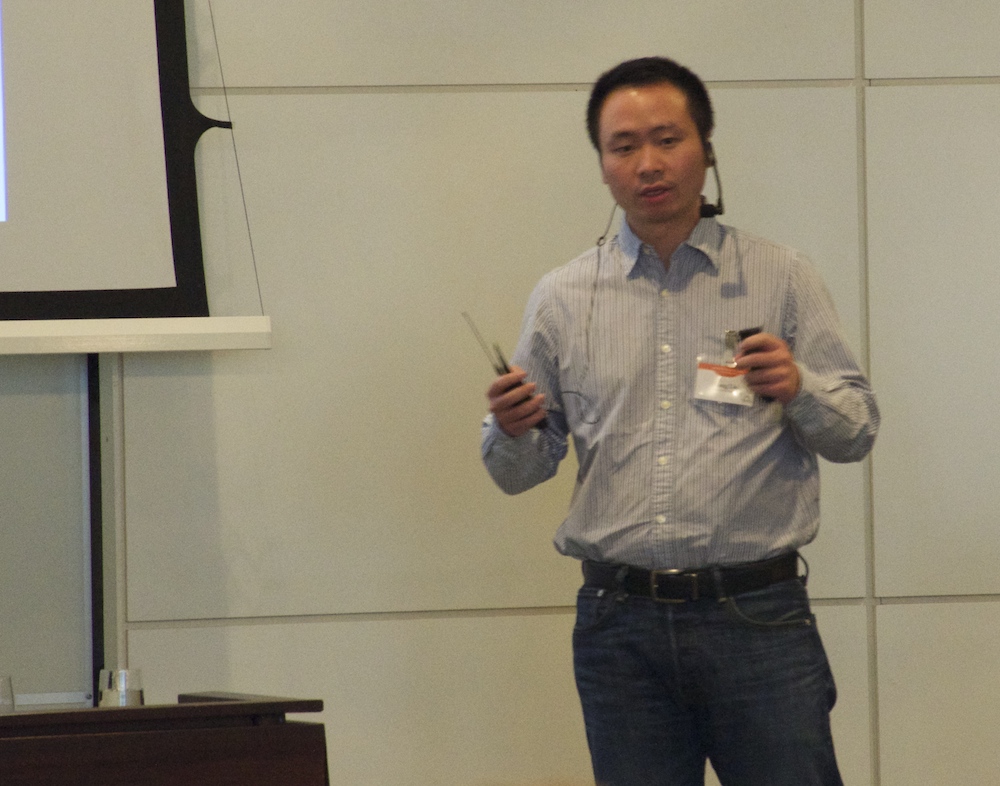
Liang Liu talked about “Massive MIMO at Lund University – LuMaMi”
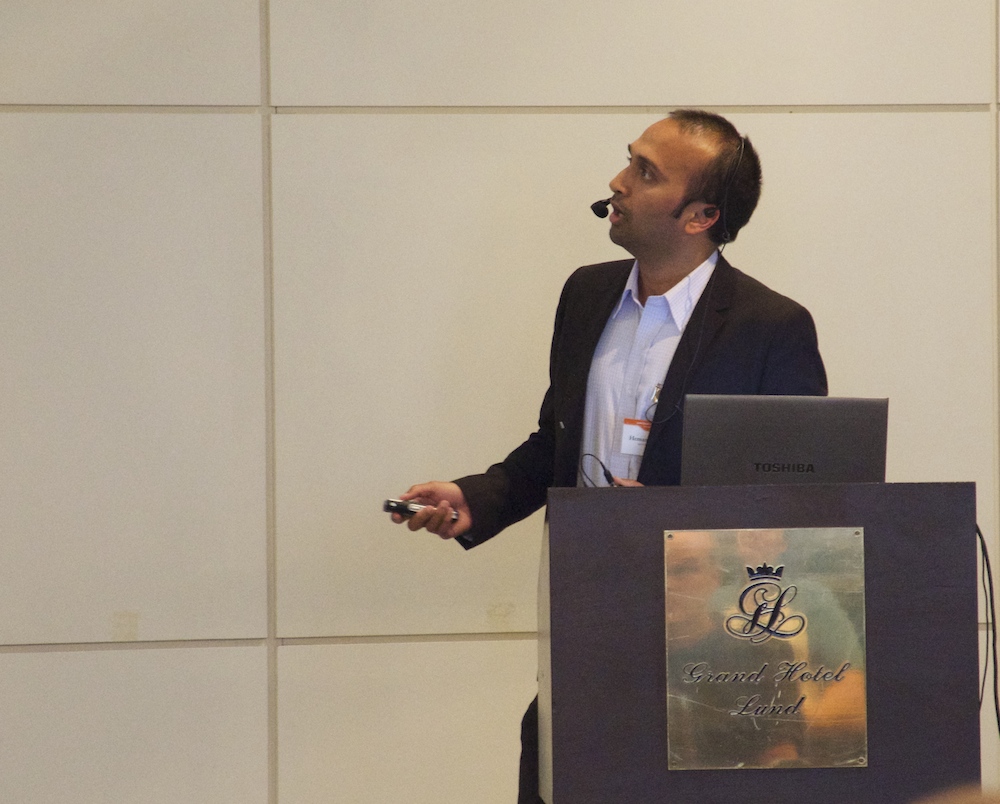
Hemanth Prabhu talked about “Efficient Baseband Processing for Massive MIMO”
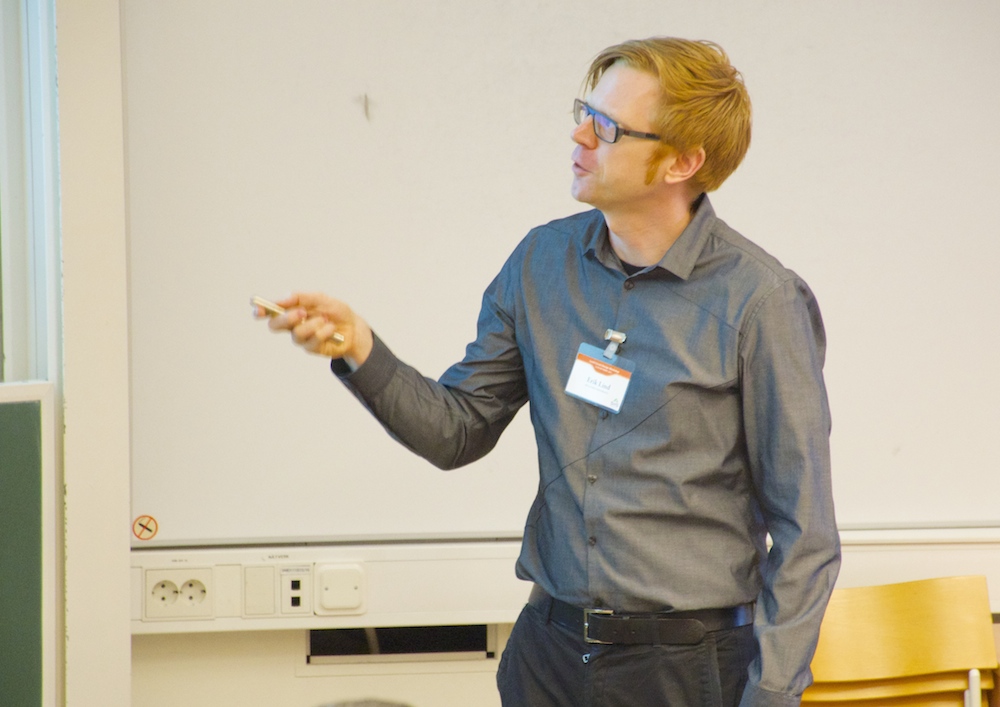
Erik Lind talked about “mm-Wave Characterization of III-V Nanowire MOSFETs”
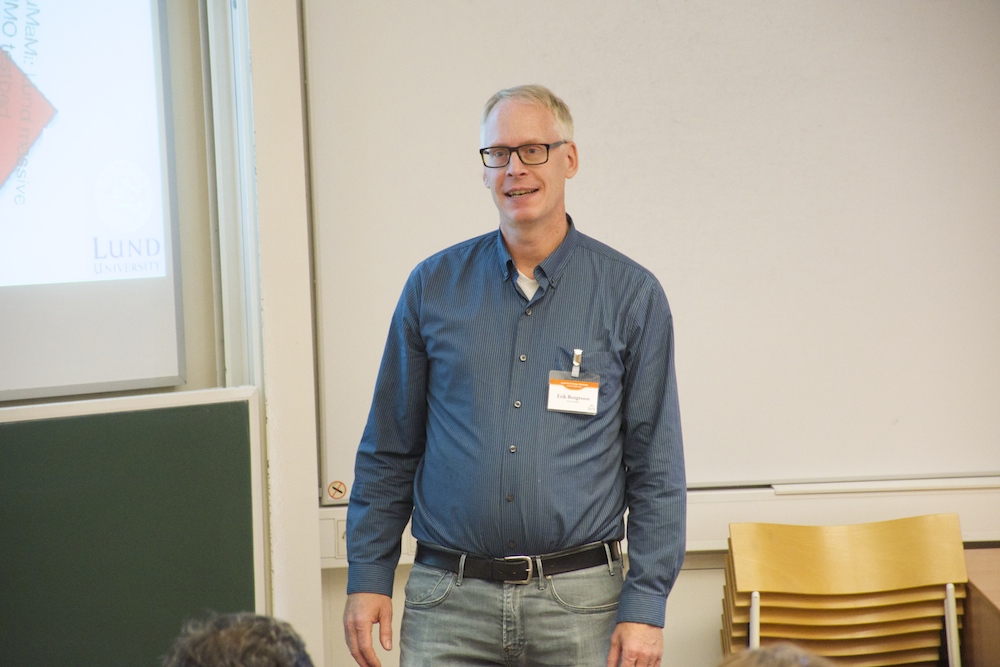
Erik Bengtsson talked about “Handset antennas for Massive MIMO"
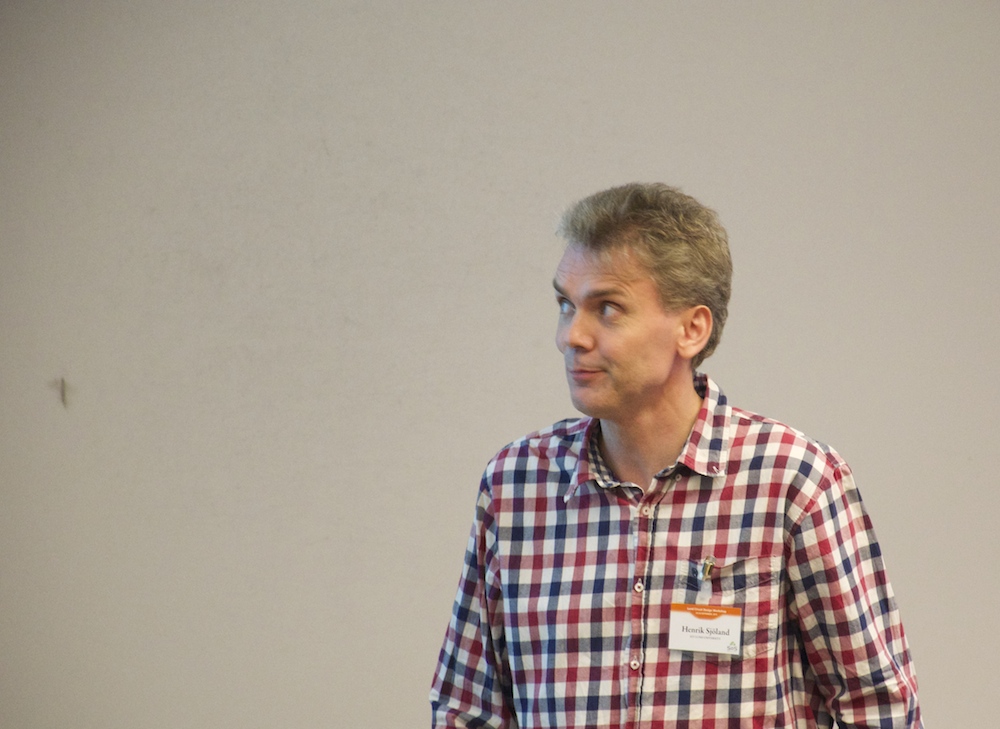
Henrik Sjöland talked about “Progress in RF circuit design”
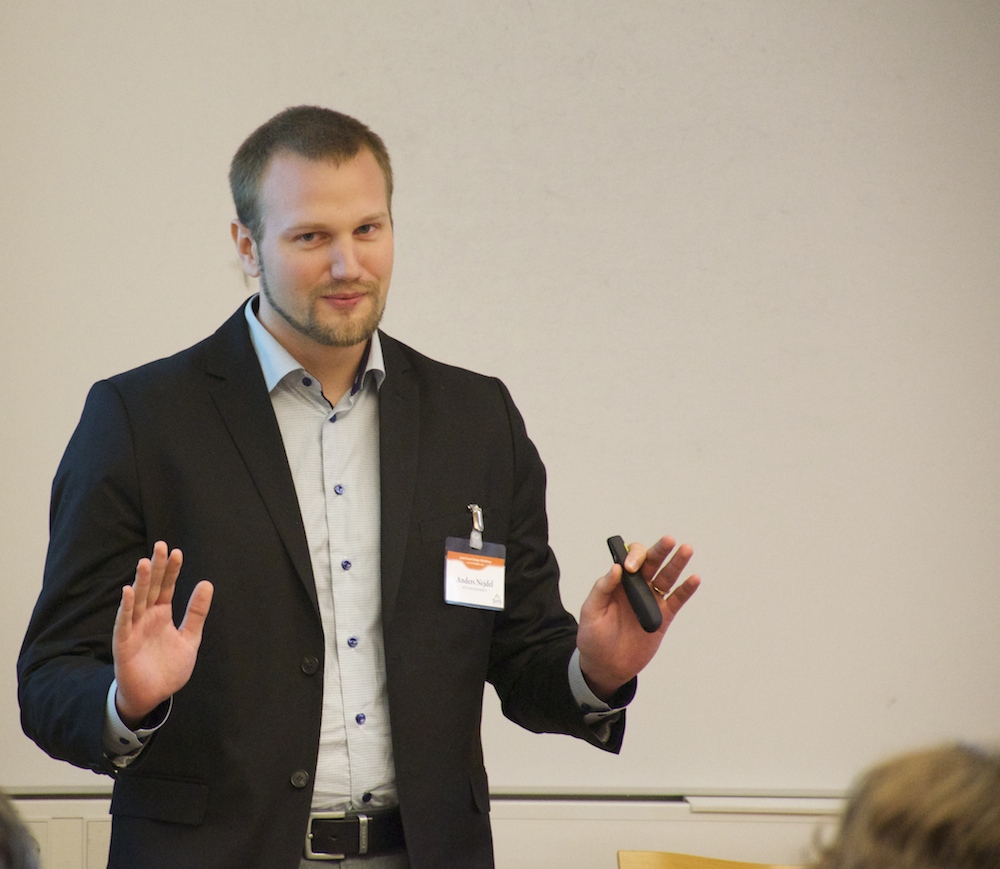
Anders Nejdel talked on “Feedback-based RF front-ends”
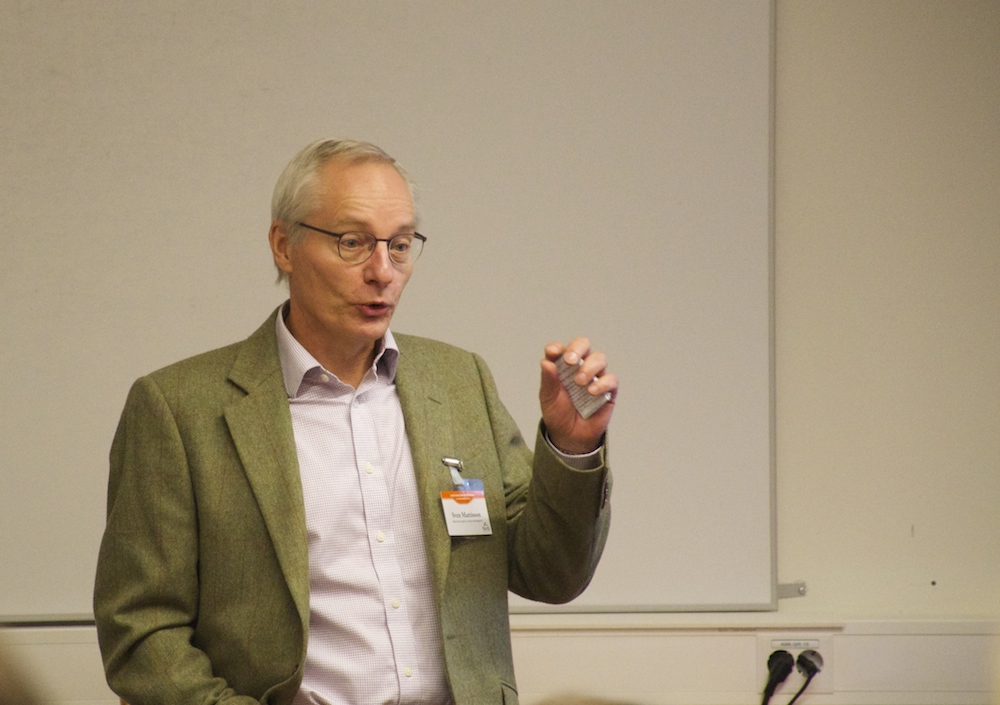
Finally the centers chairman Sven Mattisson thanked the presenters, the audience and the organizers for an event, very well performed and welcomed us back next year. As always, big results and small circuits. A special thank to Pia Bruhn who masterminded all the logistics.
A few more pictures from the event below.
Text and Photos: Anders Borgström
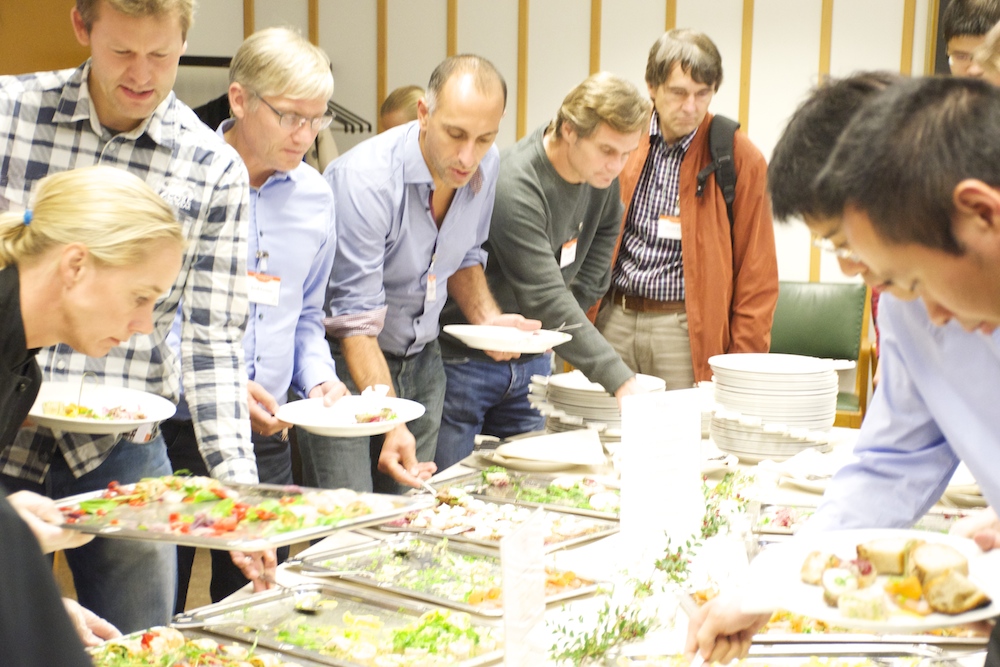
Hungry not only for knowledge…

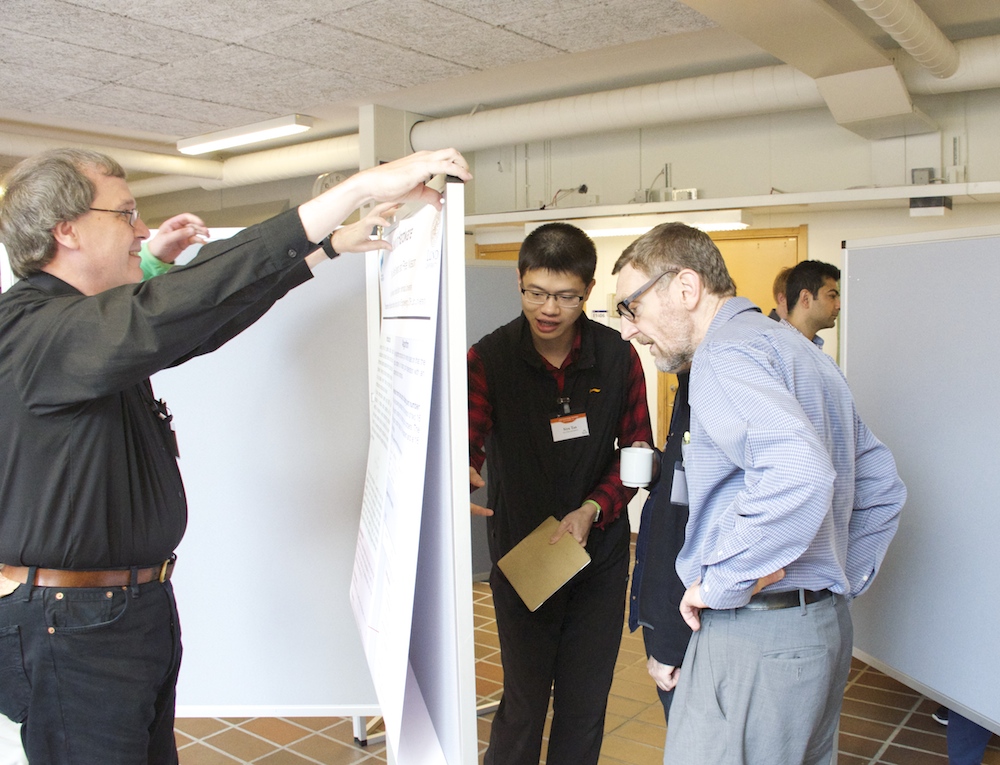
Demo and posters
Coming up! Lund Circuit Design Workshop!
Published: 2015-09-14
Around 150 researchers and outstanding experts from academia and industry will gather in Lund Sept 23-24 for 2015 Lund Circuit Design Workshop.
The “Lund Circuit Design Workshop” will take place at Grand Hotel and LTH September 23-24 and this years event will host expert guest speakers talking about 5G energy performance, Massive MIMO, autonomous systems and much more.
In addition to that, the main program will present world class research results on the circuit design fields such as power efficiency, PLL design, baseband processing, RF front-end, mm-wave, handset antennas and much more. Six expert speakers from academia and industry together with some ten from EIT will together deliver the latest findings to more than 150 researchers summoned in Lund. The workshop is hosted by the VINNOVA Industrial Excellence Center in System Design on Silicon (SoS), and by the Swedish Foundation for Strategic Research projects: Distributed antenna systems for efficient wireless systems (Distrant) and Digitally-Assisted Radio Evolution (DARE).
See detailed program here
See SoS Homepage here
Text: Anders Borgström
EIT-research within LTE heading towards IoT-markets
Published: 2015-09-09
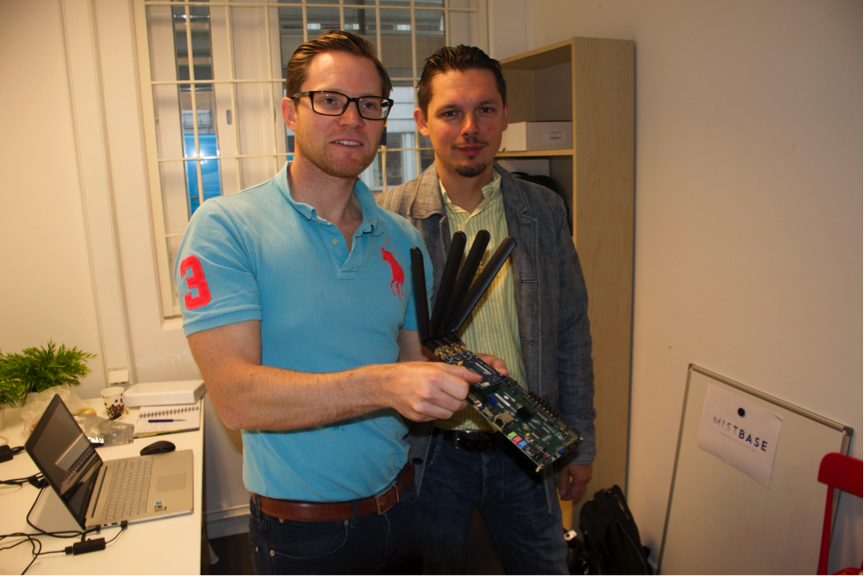
Magnus Midholt, “handyman” and Michal Stala CEO in Mistbases headquarter at Ideon Innovation.
Photo: Anders Borgström.
Michal Stala, PhD student at EIT together with Magnus Midholt with many years at Sony Ericsson/Sony Mobile are both working hard to take their proprietary solution to market. The aim is to address the world of IoT (Internet of Things) using 4G or LTE. -We will have a working demo at MWC in Barcelona next year, they say hopefully.
With office and lab hosted in a small room at the business incubator Ideon Innovation they also have nearby access to business coaches who interrogate with questions. Questions on business potential, customer benefits, marketing and other issues needed to make innovations hit the market. Technology development is one thing and business is another. -And we would like to do both. We have stepped up on the bridge between research and innovation, the guys tell us.
Magnus and Michal have been considering a joint startup since they did their Masters studies together at LTH and many ideas have since been tossed around frequently throughout the years. At the time, WAP and color displays were hot, now other things make headlines.
After employment at Ericsson, Michal began his PhD studies at EIT where he addressed the fields of LTE and 5G. -A course on LU Innovation in entrepreneurship for scientists got the business ideas to mature and our company Mistbase was born, says Michal.
Magnus is currently on leave from Sony Mobile and works full time and eagerly with his new company. He has been at Sony Mobile/Sony Ericsson since 2003 and during hard restructuring times he has been thinking a lot about the possible commercialization potential of research findings.
Trade magazine Elektroniktidningen, Newspaper Sydsvenskan and other mainstream media have written about Mistbase which has generated good buzz around their venture and some major industry players have already contacted them.
Mistbases unique solution includes circuitry and control software for the hardware plus some signal processing algorithms. Everything is compatible with the new so-called LTE MTC standard which will be launched by the standardisation body 3GPP shortly. MTC means Machine Type Communications and is an acronym that we all should start to get used to from now on.
Magnus tells us that the "real" LTE can deliver bit rates of hundreds of Mbps. -We are however aiming at bit rates below 1 Mbps and this will radically save cost and reduce power consumption, he adds.
One critical thing concerns how long the terminal is allowed to sleep before it "pings" and says "hey here I am" to the base station. Today, the maximum time is around 2.5 seconds, but with the MTC it can be held significantly longer. A cornfield that need to be watered e.g. does not have to ask for that every other second. With longer ping-times and highly optimized "sleep" they believe an IoT-unit will theoretically survive 10 years on 2 AA batteries.
The 2016 spring demo becomes a type-test case which will transmit signals between the base station and the terminal according to the LTE standard. -We validate and demonstrate that the next step to product is not long. -And we will show this with help from a sharp demo through the air, says Michal.
Coming up is recruitment of developers and testers for hardware or software and finances is of course a concern, as in all businesses. Today LUIS has entered the scene with basic investment and a minor partner- and ownership. VINNOVA has also supported and a few more calls and applications in neartime will hopefully help to get things to take off on a larger scale.
Collaboration ideas also spins in the guys heads, taking into account both scientific and industrial potential partners. They run many meetings now and approach both large and small businesses as well as other institutions within the university. It does not need not be just pure technical cooperation which is of interest. Also solution to problems and definition of needs and use cases are hot areas. We learn a lot about the future use-cases and business cases and how that can benefit players in the field. -We can help with both specs and solutions, the newborn entrepreneurs tell us.
Good luck from EIT!
Text: Anders Borgström.
EIT-antennas on world-map. Vancouver IEEE-report v2,0
Published: 2015-08-27
Prize money, getting published, and the honour of winning for Georg Wolgast, Hampus Månefjord, Edvard Johansson, Alexander Israelsson and Casimir Ehrenborg, alongside supervisors Anders Sunesson and Jakob Helander.
As mentioned here previously, student team 'Gerhards Grabbar' reached the finals in Vancouver on the 21st of July with their low-power BAN-antenna system and, at the awards ceremony of the IEEE Antennas and Propagation Society, the team was happy to discover that they had won first prize.
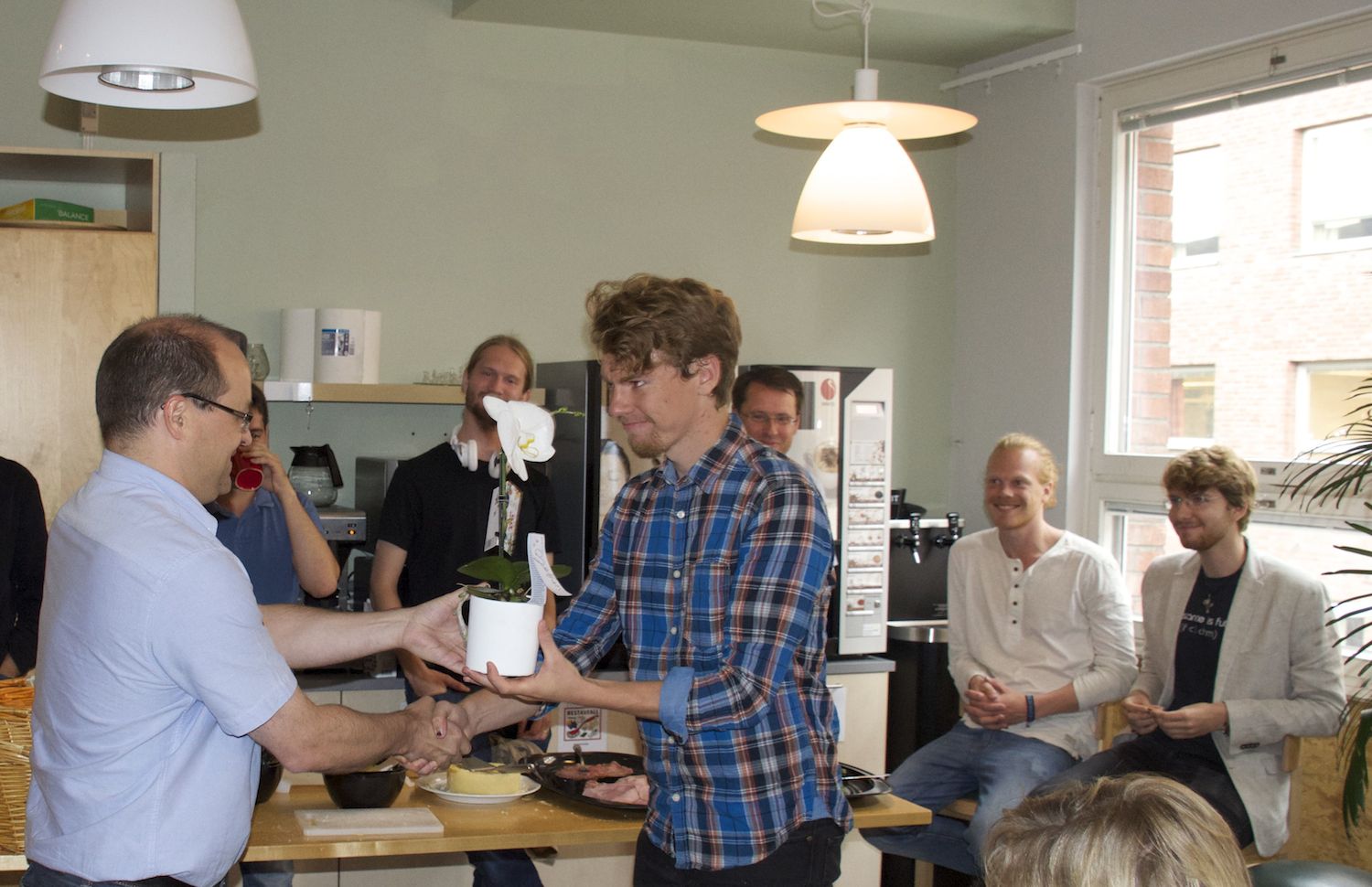
EITs Head Daniel Sjöberg congratulates Edvard Johansson to first prize in IEEE antenna competition.
Picture Anders Borgström
Details can be found in a previous EIT news article (search for "Gerhards Grabbar" in the news archive).
When asked if everything had gone according to plan, Edvard Johansson and Georg Wolgast exclaim ”Not at all! We'd reached the finals and thought that had been enough!” ”After having seen the other teams we definitely didn't think we'd win as they were all so impressive”.
The conference is the biggest in the area of antennas and wave propagation, with over a thousand participants, leading us to be curious about how things are done over there. ”Everyone had done measurements on their antenna and presented it in the report, and then during our first day there we did a joint measurement on all antennas using the same measuring equipment”, Edvard tells me. ”The antennas turned out to all be more or less the same strength, but with various individual strengths and weaknesses”.
The next day it was time for the conference, with an exhibition stall, a poster, presentations and four different judges who came up to look and ask questions. ”We had a poster and the whole system up and running where we showed everything off, obviously to the judges' satisfaction”, Georg remarks, pleased.
And then at the end of the day there was a ceremony with various prices to be handed out. Did the group see or hear anything interesting that could take the technology even further? ”There's was actually a great deal of discussion around potential collaborations for projects and applications within medicine technology. We've talked to a couple of different people who have since been in contact with us”, they say.
They didn't know any of the other teams ahead of the competition but after these couple of days spent together the team have gained some new friends and acquaintances. ”We got started pretty immediately with going on trips, eating lunches together and doing lots activities in order to get to know each other better.”
When asked where they see themselves in five years, they seem not quite sure. ”Maybe not medical technology”, one replies. ”Potentially something to do with antennas”, another says. ”The great thing is that at the moment we're just picking courses and we're really starting to choose our specialisations. But BAN-technology, wearables, smart clothes etc are growing areas of interest so there's probably plenty of opportunities.” ”Instead of EKG electrodes stuck to the body, they might be integrated into a shirt with conductive fabric”, one of the supervisors speculates.
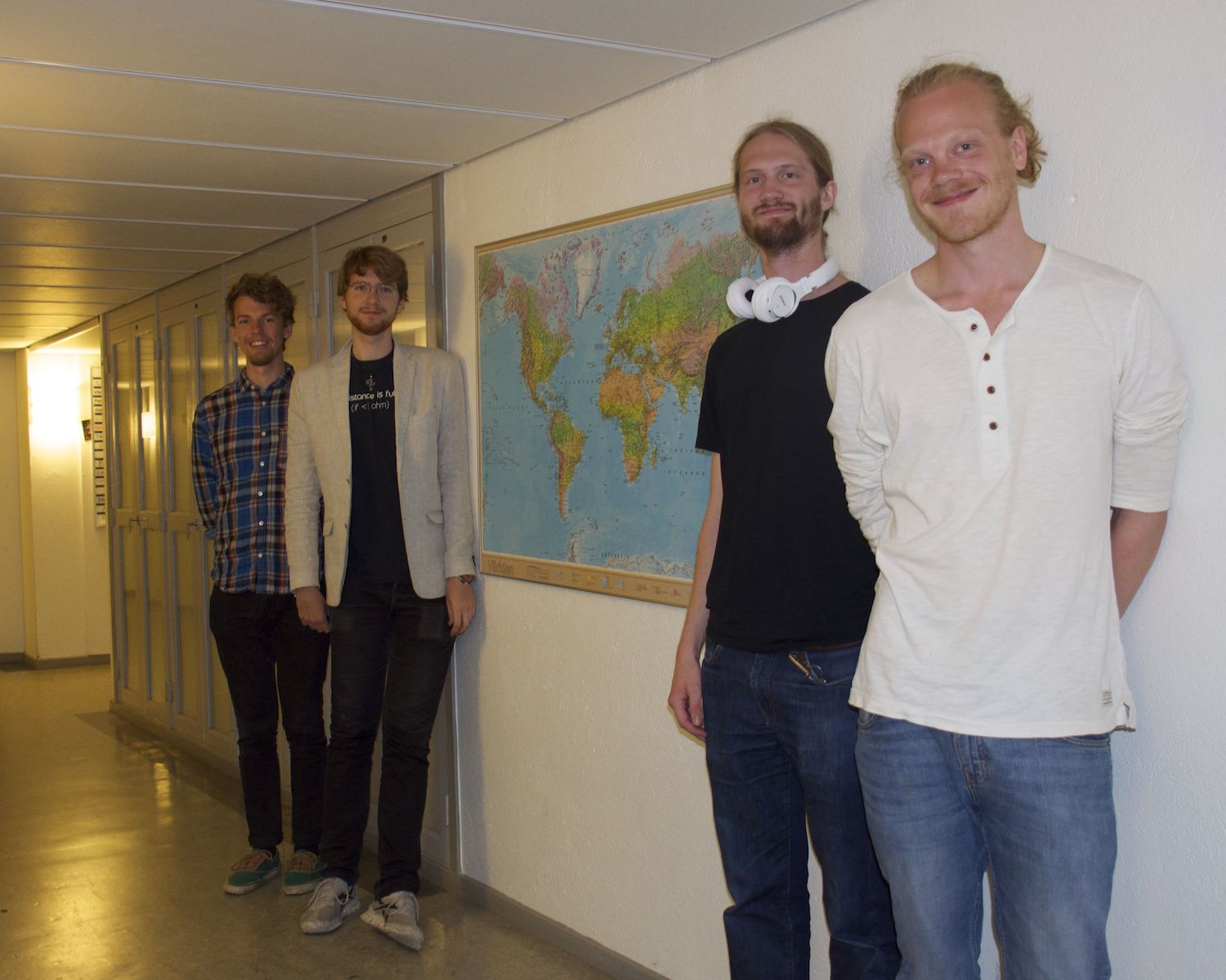
Edvard Johansson and Georg Wolgast together with supervisors Casimir Ehrenborg and Jakob Helander.
Picture: Anders Borgström
From there, our conversation drifts into ”Energy-Harvesting” and supervisor Jakob Helander and Casimir Ehrenborg mention that it may very well be an option for next year's student project. They seem keen to continue taking on fresh challenges that put the students of LTH on the global map. Money? Yes! The 1500 dollar prize money and publication in IEEE Antennas Propagation Magazines student column were an additional bonus that came with the adventure. Travel costs were, by the way, supported by a couple of scholarships and helped along further by the American currency exchange rate.
EIT says congratulations and GOOD LUCK with your continued studies!
Text: Anders Borgström
Vincent excels as editor
Published: 2015-08-21
|
EITs Buon Kiong Lau, or Vincent as most of us know him, has been recognized for excellent editorial performance. During the recent IEEE International Symposium on Antennas and Propagation in Vancouver (19-24 July 2015), Buon Kiong Lau (Vincent) was awarded a certificate of recognition by the IEEE Transactions on Antennas and Propagation for exceptional performance as an Associate Editor (AE) for the journal. There are currently 46 AEs and every year 3 AEs are selected for this award. Vincent has been serving as AE since 2010, and he has also been involved in guest editing two special issues for the journal (one published in 2012 and one in progress). |
Vincent receives his award in Vancouver |
|
IEEE Transactions on Antennas and Propagation is one of the most popular IEEE publications and the top journal in the field of antennas and propagation. For many years, it has been ranked among the top 3 journals in terms of number of downloads from the IEEEXplore database with 3.7 million articles (e.g. No. 2 in 2014). Since 1952 this journal has delivered many thousands of articles on a wide range of topics of interest to specialists, practising engineers, educators and students in the field of interest of the IEEE Antennas & Propagation Society.
|
Summerschool in accelerator technology
Published: 2015-08-10
The world will learn accelerator technology at EITs summer school
|
Students from Europe, Australia and USA will during August 17-23 participate in a summer school hosted by EIT and directed by the Nordic Particle Accelerator School (NPAS). NPAS is a joint European project between Lund University, ESS, MAX IV Laboratory, Uppsala University, Aarhus University, University of Oslo, Jyväskylää University and the course will be held by experts from the NPAS-members respectively. Earlier this year EIT, ESS and MAX IV were granted a contribution of 3 MSEK in order to run a summerschool, to develop a MOOC (Massive Open Online Course) and to create a network for education within accelerator technology. From EITs side our experts Anders Karlsson and Anders J Johansson will participate and more on the summerschool can be found on EITs courseplan Fundamentals on Accelerator Physics |
MAX IV |
|
The course gives an introduction to particle accelerators and gives the students 3 ECTS. During the week, students will have lectures, run a small project and have visits to ESS and MAX IV. Topics addressed are synchrotron light sources, spallation sources, accelerator physics, optics, tools, computer simulations, beam diagnostics, RF sources and components, magnet technology, medical applications, proton cyclotrons, hadron therapy and much more. Participants will also be introduced to how research frontiers are continuously pushed with help from higher beam energy, better beam brilliance, new theories, better technologies and other significant parameters. EIT and the accelerator school managment says a warm welcome to everyone participating in this event that will contribute actively in the build-up of the regions emerging high-technology accelerator environment. Text: Anders Borgström
|
EIT and Huawei initiate collaboration
Published: 2015-08-13
|
The Department of Electrical and Information Technology (EIT) at LTH initiates a collaboration with the Huawei development unit based in Lund. The joint project is focused on the area of Non-Orthogonal Multiple Access (NOMA), which is one of the techniques being investigated for the fifth generation mobile systems (5G). The collaboration advantage is two-fold. Firstly it opens up a new area of research for EIT and secondly it contributes to Mobile Heights efforts in strengthening regional partnerships, setting south-swedish mobile industry even more clearly on the map. |
Fredrik explains NOMA. Photo: Anders Borgström |
From EIT, the work is headed by Associate Professor Fredrik Rusek, who explains about an ongoing recruitment for a postdoctoral researcher, who will receive full funding from Huawei during 2 years. In total, Huawei will contribute with 2.8 MSEK. Huaweis development unit in Lund is responsible for the groups terminal-based 5G platform and those operations are led by Tord Wingren.
NOMA is a recently proposed, unconventional method i order to service multiple mobile phone users simultaneously. Mobile terminals are traditionally separated from each other by dividing either time or frequencies in transmitting through the radio spectrum. In NOMA, multiple users are served simultaneously on the same frequency. The system will provide service to more users but will also result in users disturbing each other. It's a non-orthogonal system. The research approach is focused on eliminating the disturbances in order to fully exploit the NOMA efficiency.
- During most of my time as a PhD-student I worked with non-orthogonal transmission methods. Although NOMA is significantly different, it will be great fun to once again work with these slightly unconventional systems, says Fredrik Rusek.
- It is gratifying that we can start a partnership with a major player like Huawei. It shows that the mobile cluster in Lund continues to be regionally active with new research approaches for the benefit of the mobile industry, says EITs head of department Daniel Sjöberg.
- It is important for Huawei to collaborate with leading universities in mobile communications and we are very happy about this. We hope for more collaboration with Lund University in the near future, says Tord Wingren and Peter Almers, responsible for coordination of the project on Huaweis side.
Text: Anders Borgström
Lars makes small big things
Published: 2015-06-11
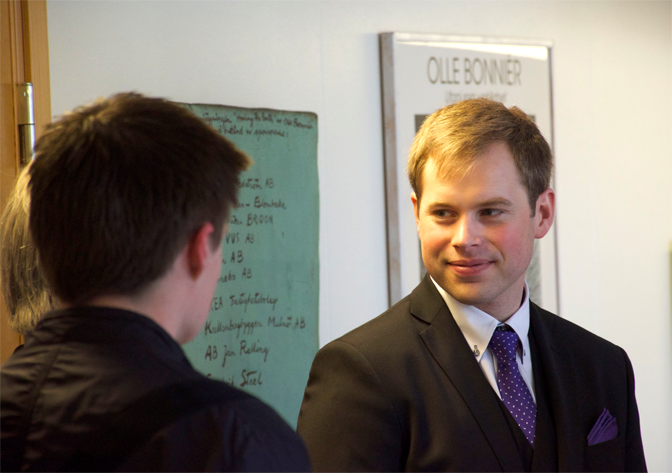
On June 5th, Lars Ohlsson became PhD in Nanoelectronics after having presented how he and his colleagues had been able to demonstrate that a radio transmitter, including antenna, can be accommodated within a cubic millimeter.
Super-computer in the pocket
Lars grew up on a small island in the Småland archipelago but moved to Lund when it was time for university studies, to learn more about ... everything!
– And in particular the physics and electronics that allow us to walk around with what was recently considered a super-computer in your pocket. There is a lovely mix of advanced theory and sophisticated manufacturing technology.
– I go back home now and then to enjoy the tranquility and to hunt waterfowl, elk and wild boar, says Lars who also appreciates hikes in Swedish mountains as well as Danish hills.
A natural choice
After finishing his nano engineering studies, Lars took the chance to study for a PhD in the specialist field. "A natural choice taking Lund’s position in the area in consideration", he expresses his choice. The result was successful and is described in the PhD thesis "Compact and Efficient Millimetre-Wave Circuits for Wideband Applications".
– We have examined what can be achieved just outside the limits of what today is considered as the conventional technology in radio electronics. Electrical components based on nanostructures of III-V materials have been used to create wideband signals at high frequencies, with good efficiency. Furthermore, we have shown that such a radio transmitter, together with its antenna, doesn’t need to occupy more space than a cubic millimeter, says Lars and is a little mysterious about his plans for the future:
– The plan is to make small big things ...
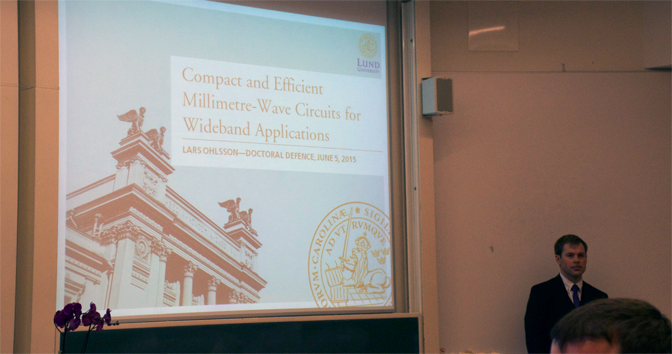
Text: Johan Cedervall
Photo: Anders Borgström
Hatten på för Liesbet
Published: 2015-06-05
Viktor Öwall, Liesbet Van der Perre och Ove Edfors i Lundagård. Bild: Ove Edfors
Flankerad av LTHs rektor Viktor Öwall och professor Ove Edfors skiner LTHs och EITs färskaste hedersdoktor professor Liesbet Van der Perre ikapp med solen i Lundagård. Fredagen den 29:e Maj var det dags igen för årets stora akademiska högtid, doktorspromotionen, där nybakade doktorer, hedersdoktorer och jubeldoktorer hyllas. Liesbet har som högt förtjänt forskare och viktig samarbetspartner i LTHs forskning utsetts till hedersdoktor vid Lunds Universitet. Ring, hatt och diplom plus en massa visdom och lyckönskningar på latin östes över vår akademiska elit och Liesbet fick sin beskärda del.
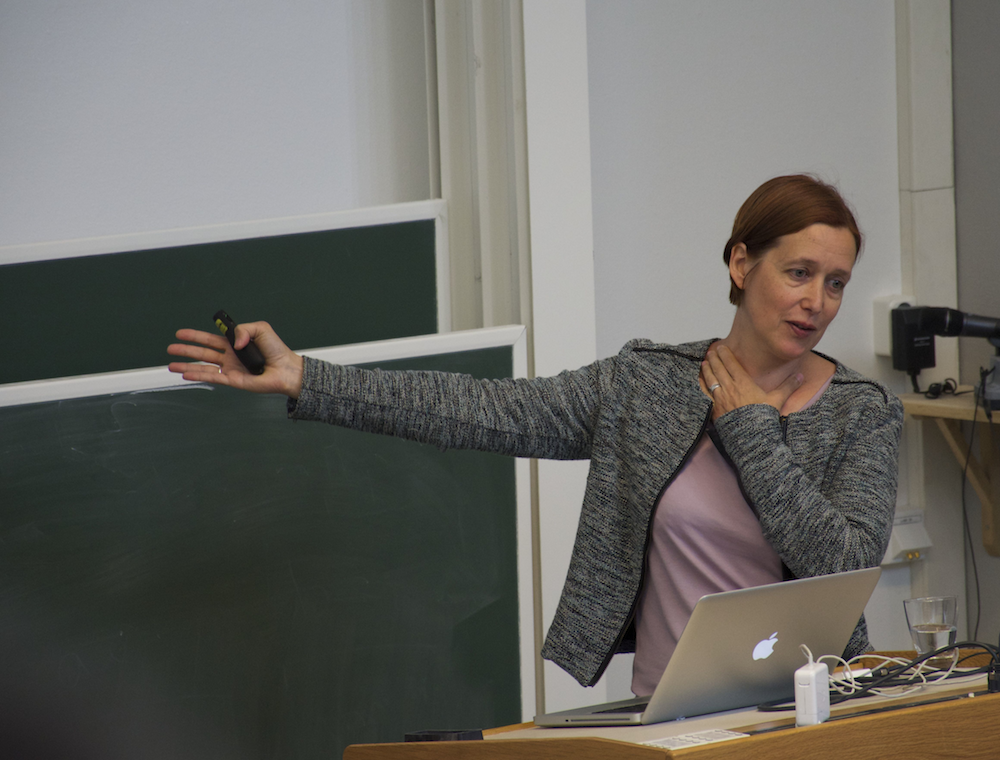
Liesbet Van der Perre föreläser vid EIT. Bild: Anders Borgström
Dagen innan fick vi lite mer handfast ta del av Liesbets visdom i en mycket välbesökt föreläsning med titeln "Precious bits, sharing the spectrum, on elegant energy". Vi fick bl.a veta att man inte kan lura fysikens lagar och det är ett obestridligt faktum att det finns gränser både vad gäller radiovågornas utbredning och hur mycket man kan skala upp den trådlösa kapaciteten. Det ska enligt Liesbet inte hindra forskarna att ta nya tag och stångas mot framtiden.
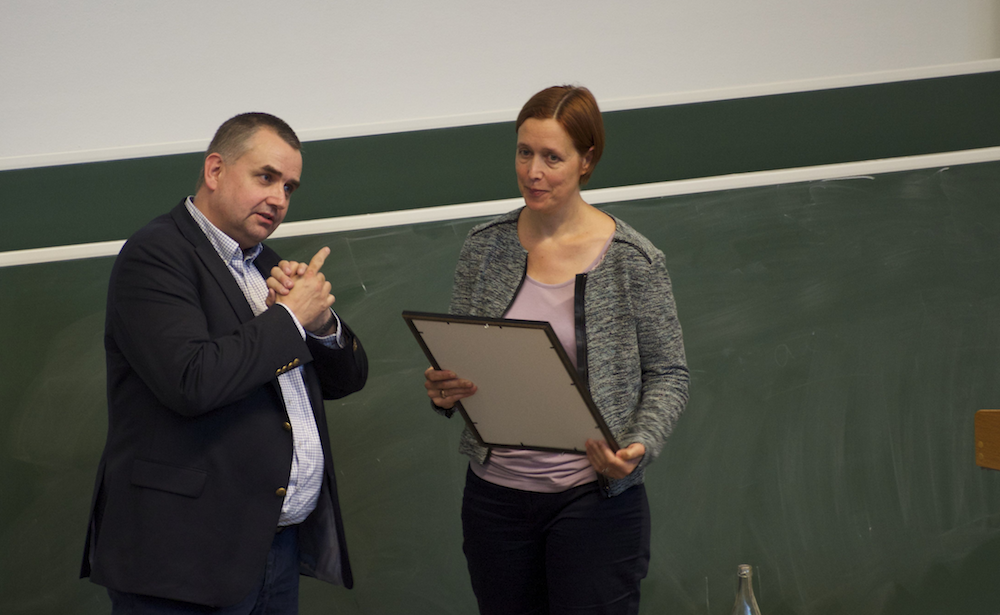
Liesbet Van der Perre tackas av Ove Edfors. Bild: Anders Borgström
Liesbet tackades efter föreläsningen av Ove. Inte bara Liesbets forskning håller världsklass, så också de svenska tårtorna som tillsammans med kaffet avrundade dagens tillställning.
Text: Anders Borgström
"Best Paper" to EIT at ICC 2015
Published: 2015-07-23
Yezi Huang and Eduardo Medeorios with coauthors from Lund University and Ericsson Research received a best paper award with the paper “Mitigating disorderly leaving events in G.fast” presented at ICC 2015. The authors presented a solution to the problem that when one modem is turned off during operation, neighbouring modems may temporarily loose their broadband connection. In today’s connected society, this may lead to angry neighbours if it occurs frequently during say popular sports events. This paper solves the disorderly leaving event problem for the newly standardized fibre-DSL system G.fast and similar fixed broadband technologies. Two operation modes are proposed to make channel estimation and precoder update unnoticeable to active end-users. In addition, the estimation effort is reduced from K^2 to K, where K is the number of twisted pairs, lowering complexity and cost for the modems.
MAPCI hosting new positioning lab.
Published: 2015-06-02
The new Lund Positioning Lab will aggregate research in Lund University around positioning technology. Regional industry will also be provided modern facilities for experiments and give opportunities to build valuable academic contacts. Key persons and early actors in this environment are Björn Landfeldt (MAPCI), Kalle Åström (Mathematics), Fredrik Tufvesson (EIT), Bo Bernhardsson (Automatic Control).
Erasmus+ grants funding for summer school, MOOC and more
Published: 2015-05-30
Wallenberg commits to 1,8 BSEK in basic research
Published: 2015-05-29
Wallenberg Foundation commits to spend 1,8 BSEK during ten years in Sweden on basic research for autonomous systems. 20-25 MSEK/year is expected to find its way to EIT.
Butting against the future with his pico-pulses
Published: 2015-05-28
|
The startup company Acconeer has recently received a large investment for further commercialisation of the technology of integrated microwavecircuits. Acconeer was founded in 2011 and uses solutions that have come about as a result of the research being done at EIT by Lars-Erik Wernersson's research group. We sat down to have a chat with him about the research behind the successful enterprise. The group's most important breakthroughs had to do with the very low power consumption and the possibility of generating extremely short, coherent pulses. “Today we're down to 60 ps and we're doing it in 60 GHz areas where we, thanks to the high frequency, achieve very high accuracy”, Lars-Erik says. Coherence is important in this context as it provides access to useful phase information when the pulses propagate and interfere. |
Lars-Erik Wernersson with wavelet-generator integrated at 1mm2 antenna and prepared to be measured. Picture: LTH-News |
Communication turned into radar
When the research first started it was seen as having the potential for communication technology applications. With time, however, the technology became more and more interesting for use with radar, material characterisations and spectroscopy. If communication is ruled mainly by standardisation, radar technology is a more flexible area of research, guided instead by applications and how we use them. Follow the frequency regulations but otherwise use it freely!
“Despite this, we presented and published an article in IEEE Access last autumn which described an experimental communication application with a wireless 15 Gbps link”, Professor Wernersson tells us proudly. “We're increasingly investigating and challenging the limitations of ultra fast wireless technology. Even if Acconeer in this case is a very clear application, we also conduct a great deal of basic research where we will gain new knowledge that can benefit new emerging and innovative ventures to grow in the region.” he adds, with emphasis, “That's why we will continue carrying out this research”.
New tool for analysis
“Another interesting application is, as I mentioned, material characterisation”, Lars-Erik remarks and goes on to describe what it can entail. Characteristics of a material can be studied with the help of pulses that have either passed through or been reflected, as the pulse afterwards changes concerning time, phase, envelope and frequency. “We believe that the technology can be suited to the analysis of gases and liquids considering the rotation transitions at these frequencies”, Lars-Erik says. “In other words, chemists will appreciate this in the future and our short pulses can, for example, give an extremely good time resolution”.
Visions, skills and money give results
Lars-Erik explains the success as being down to a combination of “able doctorate students, visionary ideas and research financiers that place their trust in us in the long-term”. He continues, saying that the combination of hard work and LTH infrastructure are also important ingredients. In addition it's important that doctorates are active educators, ensuring that new good doctorate students are found and recruited.
SSF and VR have been two important financial backers of the research so far and the basic research approach with clear potential for applications has attracted them to stay for the long run. At the start, finance was agreed to on the assumption that the research would have communication applications and a doctorate student from the High-Speed Wireless Centre HSWC was at times assisting with the research. This work was led by John B Anderson.
mm-wave collaboration remains
Lars-Erik is careful to pinpoint internal EIT collaborations as extremely important for the success of their research, but also highlights the importance of their cooperation with the Physics institution's nano lab. There is a so called mm-wave group within EIT that spans several research groups and much of the success is due to this forum where various modes of research can meet and thrive. In addition, Lars-Erik is keen to highlight the role of John B Anderson, who has succeeded in bringing about many vital and prestigious collaborations. The HSWC project was, during 2005 to 2010, led by Anderson and managed to get two years additional financing in the shape of a 60 GHz project. The group that was set up then still exists in the shape of the mm-wave group.
Small and close is niche
Lars-Erik believes that many will benefit from the physical smallness in upcoming implementations of their technology. The pulse generators can be integrated on the surface on top of very small antennas and the entire solution needs less than a square millimetre of space. The range is dependent partly on the output power and partly on whether the work is being done in a closed volume or in free air. The niche is going to be applications with short range needs and Lars-Erik points to car radar as an example, where today there is an issue of “dead” space very near the car. In that space the short 60GHz pulses could act as complimentary technology.
Robot vacuum cleaners are just one more of countless other potential usages. With imagination and creativity, one can quickly think of more. Wireless communication between units on chip and fast data-dump from phone to hard-drive are another couple of potential applications within communications.
Commercial interest from the beginning
It becomes clear that this research is both called-for and important when one considers that the first paper that was published on the technology resulted in direct commercial offers from several large radar manufacturers. The fact that multinational consumer industry in addition has chosen to invest in Acconeer shows that the technology has already picked commercial interests and could have a big economic importance in the future.
Are there health side-effects?
“It's a relevant question”, Lars tells us. The mention of “radar” results in important considerations around radiation etc, but at the same time it is a question of very low effects at around 10dBm (10mW). In comparison, a mobile phone can give off a couple of Watts in continuous effect if it is far away from a base station.
Vacuum cleaners, car radars and communication between chip-buses are just some of the potential future applications of the knowledge that this Lund team is now continuing to develop and refine.
Text: Anders Borgström, Picture :LTH-News
Babak gets first prize with IoT low power design entry.
Published: 2015-05-25
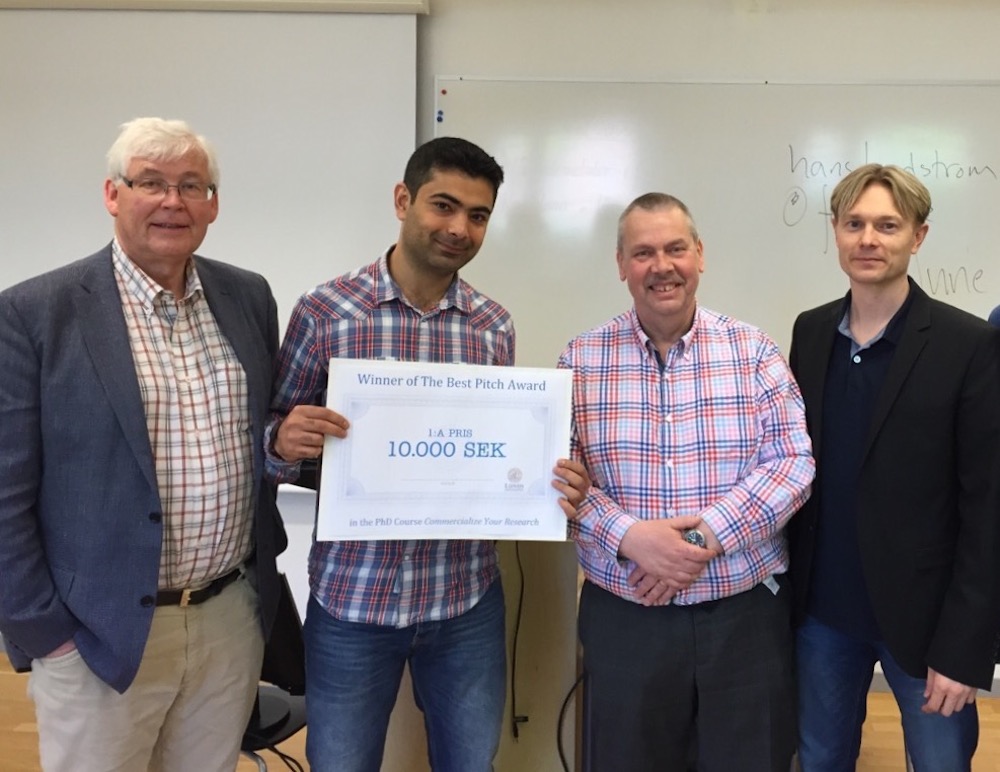
Babak Mohammadi was, after doing the best pitch, awarded with 10000 SEK as the first prize in the “Commercialize your research” course, offered to PhD students at Lund University. There were 21 different projects from all the participants and there was a tight, but exciting competition between groups.
The course itself was about entrepreneurship, innovation and commercialization of research outcomes. It was a very informative and fruitful course conducted by many workshops on customers, investors, entrepreneur’s views; presentations, drafting a business etc. This helped to see yourself and others’ works with different glasses, which was very constructive. The course also introduces different methods and tools to support the researchers with commercializing their ideas.
The business plan was based on research outcome, leading to a pitch competition in the last session. Attendees were real entrepreneurs and investors which made it very exciting. Babak presented the idea of a start-up company based on research results in low power design techniques, targeting the future Internet-of-Things (IoT) market.
Security Day at LTH
Published: 2015-05-21
EIT together with SICS (Swedish ICT) and Ericsson arranged a "Security Day" at LTH last tuesday. Industry, academy and students listened to seminars on "Trust and The Network", "How to Buy a Cloud", "Securing the Internet of Things", "Lightweight Cryptography" and more by presenters from HP, AEGIS, Nokia, ARM, Ericsson and others. Host from EIT was Martin Hell.
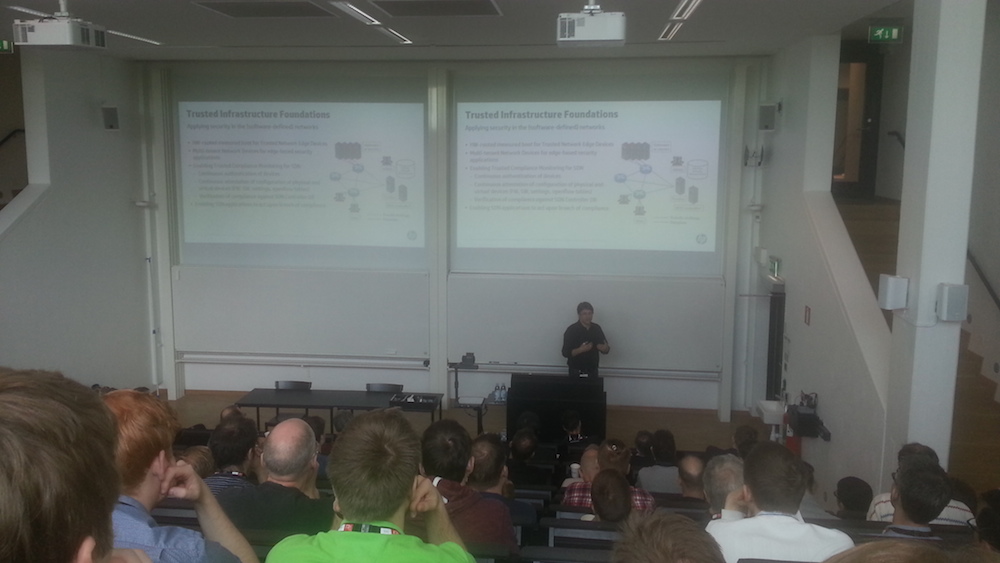
Text: Anders Borgström, Photo: Martin Hell
Från discokula till mångmiljardomsättning på nätverksvideo.
Published: 2015-05-21
På vårens sista tårtseminarium fick vi ta del av Axis-grundaren Martin Grens resa från att vara tonårsentreprenör till att idag som en av de största ägarna fortfarande vara i högsta grad aktiv och klurig inom både teknik- och affärsutveckling inom bolaget. Den 10 februari 2015 lade Canon ett bud på Axis för 340 kronor per aktie vilket värderade bolaget till över 20 miljarder kronor. På frågan om vad Martin gör om 5 år svarade han att det fortfarande är bolagets väl han brinner för, oavsett vad som står på skylten.
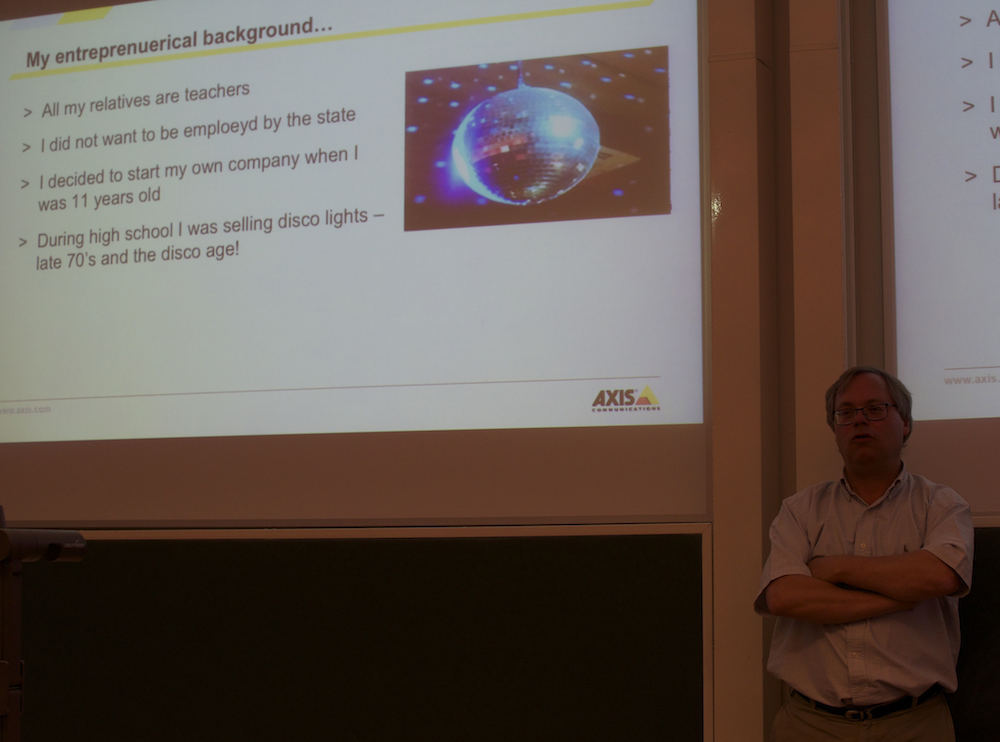
Text, Bild: Anders Borgström
EIT levererar modul för exakta energikickar till ESS-protoner.
Published: 2015-05-19
Protonerna som ska få fart i ESS s.k. LINAC (Linjäraccelerator) kommer via RF-fält stegvis få exakt dimensionerade energikickar när dom löper genom ett stort antal kaviteter. EIT-teamet har nyligen levererat den första enheten för kontroll- och övervakning av dessa kickar och deras utrustning ska testas i ett större sammanhang i Uppsala.
I nyhetsflödet har vi nyss sett att EIT gjort en lyckad leverans av en första s.k. LLRF-modul. Förkortningen står för Low Level Radio Frequency och modulen utgör en vital komponent i ESS-anläggningens kommande protonaccelerator. Eller rättare sagt 155 vitala komponenter. Så många ska nämligen levereras från andra partnerländer i skarpt läge där Lundagängets insatser i sammanhanget estår av utvecklings- och designjobbet. -Vi utvecklar, testar och dokumenterar och andra står för produktion och leverans, säger ledaren för forskningsteamet, Anders J Johansson.
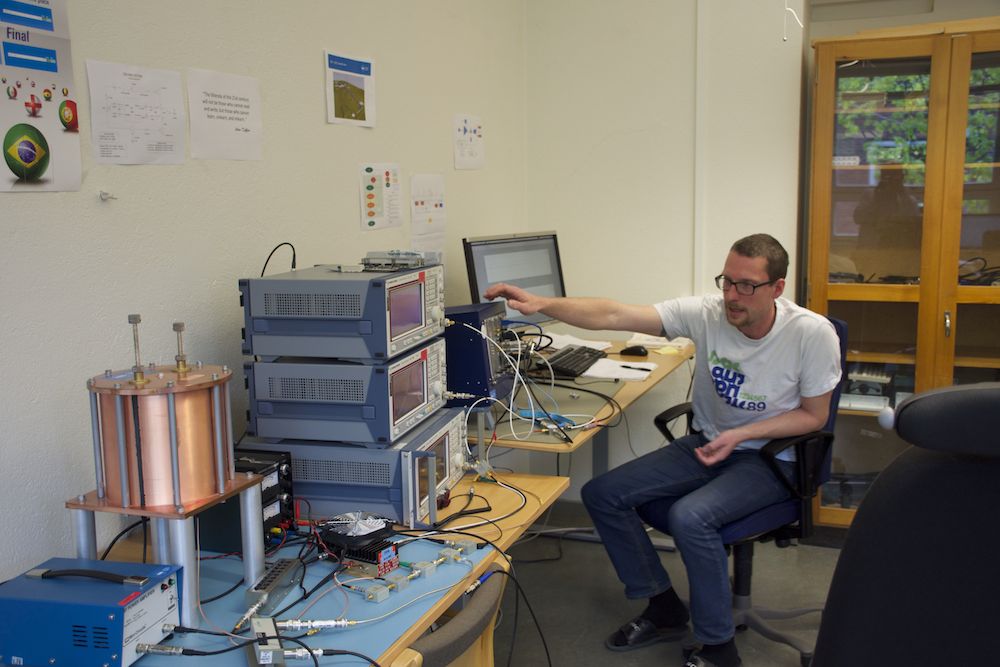
Fredrik Kristensen i LLRF-labbet. Bild: Anders Borgström
Fredrik Kristensen är en av dem som jobbar med utvecklingsarbete i projektet som bl.a. består av avancerad FPGA-programmering. På hans labbänk visar han uppställningar på det som nyligen levererats till ESS-testlabbet i Uppsala. Det står en liten låda där som innehåller kontrollenhet, tidsgenerator, FPGAer m.m. och kaviteten som ska kontrolleras och övervakas är inte den riktiga utan en labbversion. -Hade det varit den riktiga, som finns i Uppsala, hade vi frusit, skrattar Fredrik. -Den ska nämligen kylas ner till 2 Kelvin i skarpt läge. Likaså är förstärkarna i uppställningen moderata i uteffekt jämfört med de som kommer att användas i Uppsala (100-tals kW) och slutlligen på ESS (MW-klass). Annars är elektronikuppställnigen exakt som i Uppsala.
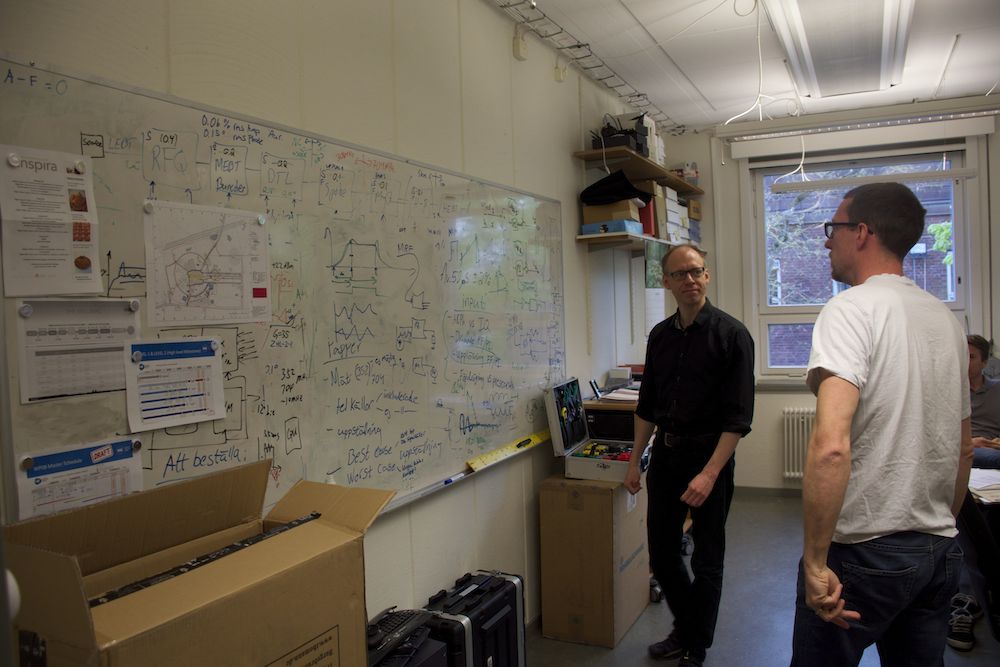
Anders J Johansson och Fredrik Kristensen. Bild: Anders Borgström
Mha den innehållsrika whiteboarden förklarar Anders och Fredrik hur deras insatser inordnas in i ett större ESS-sammanhang och Anders fortsätter sen med att introducera lite mer specifikt vad det handlar om.
Det hela rör sig om ett antal kaviteter som matas med effekt, vilket i sin tur ger fältstyrka och så mäter man att det är rätt fält. Fältet sparkar iväg protonstrålen vid exakt rätt tid vilket alltså fixas av LLRF-enheten från forskarteamets labb. I hela accelatorkedjan, eller LINAC-en på ESS-jargong, finns moduler med olika namn som LEBT, RFQ, MEBT, DTL m.fl. men gemensamt för alla är att de behöver LLRF-moduler som därmed kommer att bli en ganska välrepresenterad nyckelkomponent i anläggningen. 155 stycken i 6 olika varianter ska slutligen komma på plats i det driftsatta systemet och LTH designar som sagt enheterna medan team från andra EU-länder producerar dem. Uppsala testar grejerna i en anläggning där en öppningsbar kryostat (jättetermos) kan kyla ner kaviteter till 2 Kelvin för test. Elektroniken (LLRF) från Lund som ska styra och övervaka kaviteterna ligger utanför termosen eftersom miljön är tuff därinne med vaccuum. Vaccuum krävs vid 2 Kelvin eftersom det annars blir för mycket värmeledning. Oj, mycket att tänka på.
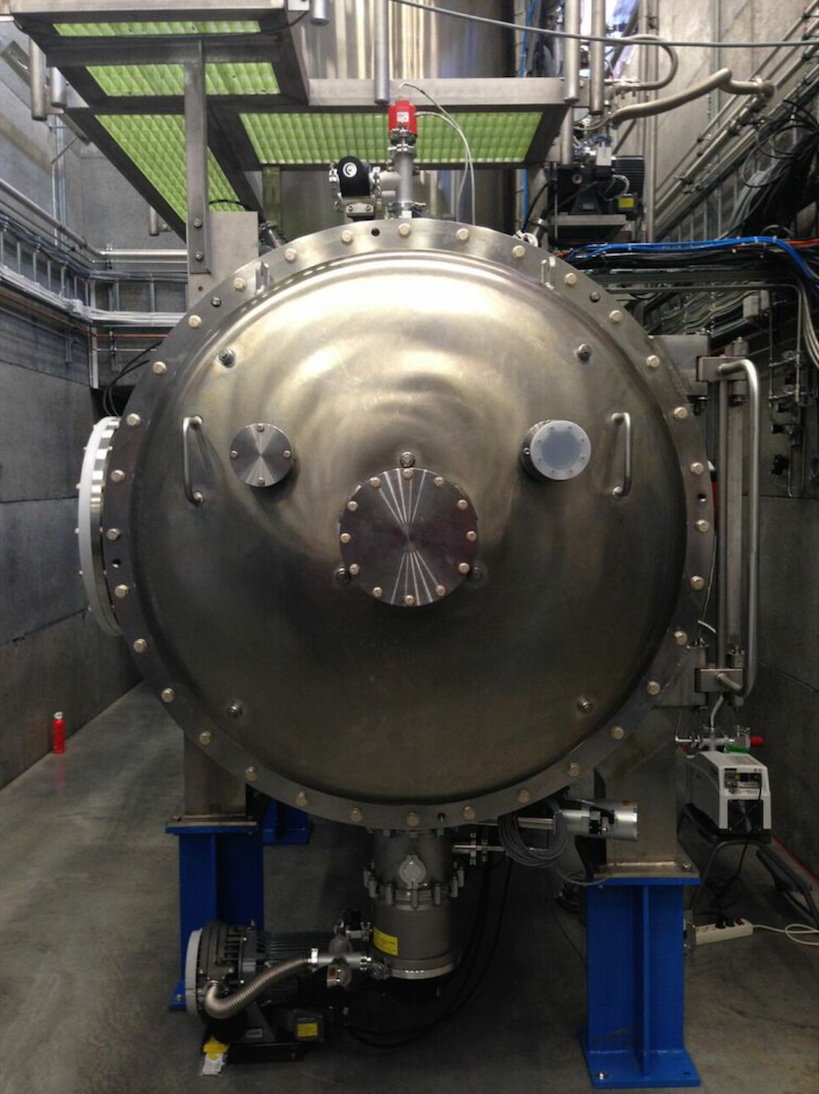
HNOSS Kryostat (Jättetermos). Bild: UU
De färdiga kryomodulerna för ESS-anläggningen tillverkas i Frankrike och ska tillsammans med kaviteter också testas i Uppsalas anläggning FREJA. Testerna ska visa att nedkylning, samt generering och mätning av fältstyrkor funkar dock utan inblandning av protonstrålar. Riktigt skarpt läge blir det först när allt är transporterat till Lund igen och installerat i ESS-tunneln.
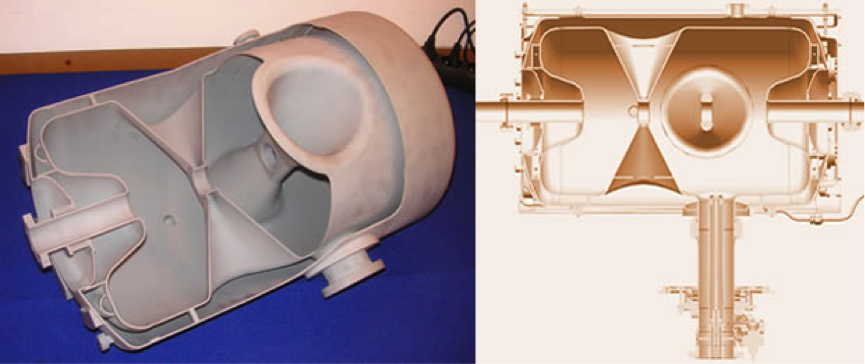
Kryomodul med innesluten kavitet.
Mer om LLRF-leveransen och Uppsalaanläggningen finns att läsa i EITs nyhetsflöde, på ESS hemsida och på EITs temasida
-Dom höga fältstyrkorna gör att elektroner kommer slitas loss och slå in i metaller, bromsas och generera röntgenstrålningar och det är en jobbig miljö med mycket bunkerbygge för att skydda både material och människor, säger Anders J Johansson och vi fortsätter med några snabba frågor till honom...
Vad har ni levererat egentligen? Vad är LLRF?
Partiklarna i en accelerator accelereras av elektriska fält. LLRF är ett styr- och reglersystem som reglerar styrkan och fasen på fältet. Den består av radiomottagare, ett digitalt styr- och reglersystem och en radiosändare. Till sändaren kopplas i slutinstallationen en effektförstärkare så vi får upp effekten till MW-nivåer. Vi ser mha LLRF till att protonerna i acceleratorn får rätt hastighet. Finns inte LLRF så funkar inte acceleratorn.
Varför gör Lunds Universitet LLRF?
Vi kvalar in eftersom vi kan radiosändare, radiomottagare, energisparteknologi och dessutom har vi inom LTH världsledande forskning inom styr- och reglerteknik.
Vad är viktigast och intressantast med leveransen?
Att vi hållit tiden och gjort rätt saker är självklart men framförallt har vi tillsammans med Uppsala-teamet gjort något som funkar bra för både Lund och Uppsala i ESS-processen. LLRF är också fullt integrerat i hela kontrollsystemet vilket är en väldigt viktig punkt. Detta är en aktivitet som är ett utmärkt exempel på samarbete i ESS-anda med kaviteter från Frankrike, testhus i Uppsala, LLRF från LTH och integration till EPICS-kontrollsystem av ESS.
Vilka är de omedelbara konsekvenserna av leveransen?
Vi har visat att vi har ett system som fungerar och att vi har kunnat integrera det även på ett annat labb. En klassisk projekt-milestone helt enkelt.
Hur gjorde ni?
Vi organiserade ett team inom LTH-EIT och LTH-Reglerteknik som tillsammans med ESS och EPICS-integratörer helt enkelt började dra i trådar. Ingångsdata definierades genom besök på motsvarande labb i USA (SNS, SLAC), Tyskland (DESI), Schweiz (CERN), Japan (J-Park) och Kina för att samla erfarenheter och kunskap vilka fått ligga till grund för det nya systemets design.
Finansiering?
Lunds Universitet och ESS finansierar till t.o.m. 2016 då pärmen med upphandlingsunderlag levereras till ESS. Förhandlingar om fortsättning pågår.
Vilka har ni samarbetat med?
Kaviteter utvecklas i Italien, Spanien och Frankrike.
Elektroniken utvecklas tillsammans med Tyskland och Polen och denna består mest av standardkomponenter. Det viktigaste kunnandet ligger i systembygge, regleralgoritmer och specialkunnande inom FPGA-teknik.
Hur sätter vi forskningen i ett större sammanhang?
En metafor kan vara att se ESS som en stor lampa där neutroner lyser istället för fotoner. “Neutron-ljuset” kan användas i mikroskop, i materialstudier, för genomlysning m.m. Ett exempel kan vara hur man samtidigt kan titta på en motors metalldelar med röntgen och dess olja med neutroner.
Varför är forskningen viktig?
Materialstudier brukar lyftas fram som främsta tillämpningen och eftersom ESS kommer att bli upp till 30 gånger kraftfullare än befintliga anläggningar förväntas många genombrott.
Hur påverkas människa och samhälle?
Som all forskning är även detta en kunskapsfabrik om än ganska tillämpad sådan. Man kan jämföra frågan som kom när de första mikroskopen byggdes. Vad skulle de vara bra för undrade man då? Idag är vi glada att de kom fram och började användas. Behoven kommer allteftersom och i ESS-fallet har vi ju här i Skåne regional nytta av hela projektet. Det är ytterligare en fjäder i hatten för universitetet att vara nära knuten till en så stor
Europeisk forskningsanläggning. Beträffande vad “mikroskopet” ska användas till så kan man studera olika material – plaster, läkemedel, metaller och skräddarsydda material – på molekylär nivå med hjälp av neutroner. ESS kommer också att vara lämpad för forskning om komplexa biologiska material och inom ingenjörsteknik, såsom hållfasthet, katalysatorer, flygplansvingar, bilmotorer och kraftverk. Inom miljöteknik kan forskningen med neutroner ge oss miljövänliga förpackningar, kunskap om vattenrening och renare industriella processer. Forskningen kommer också att omfatta vår vardagskemi, exempelvis tvättmedel, målarfärg, rengöringsmedel och smörjmedel. Forskningen kan göra dem mer effektiva och samtidigt mer miljövänliga.
Under tiden framtida ESS-forskare planerar sina kommande experiment jobbar Anders J Johansson och hans team frenetiskt vidare med sina LLRF-moduler som en av många avgörande komponenter för full funktion på anläggningen.
Text: Anders Borgström
Fredrik Tufvesson intervjuas i regionalpressen
Published: 2015-05-18
Fredrik Tufvesson intervjuas på Sydsvenskans/Helsingborgs Dagblads nyhetssajt 8till5 angående kraven på framtidens mobilssystem och hur LTH-s forskning strävar efter att hitta de vassaste lösningarna. Massive-MIMO är återigen i fokus för diskussionen vilket bekräftar att våra forskare ligger i absolut framkant när det gäller att hitta snabb, robust, strömsnål, billig och bandbreddseffektiv teknik för kommande trådlösa och mobila system. Hela artikeln läser du här.
Text: Anders Borgström
Anders Nejdels analogpresentation bäst på SSoCC
Published: 2015-05-17
Den 4-5 maj 2015 hölls ”Swedish System on Chip Conference” SSoCC i Göreborg. Det delades ut pris för bästa studentpresentation inom det analoga samt det digitala området. Anders Nejdel, doktorand i Analog-RF-gruppen vann priset för bästa analogpresentation.
Om SSoCC:
"The annual SSoCC has three main goals: to inspire and educate graduate students presenting and discussing their latest results, to give the participants an overview of SoC-related research and development work in Sweden, and to stimulate to cooperation between different research groups."
Text: Anders Borgström
Acconeer press-coverage after swedish-korean investment
Published: 2015-05-12
![]()
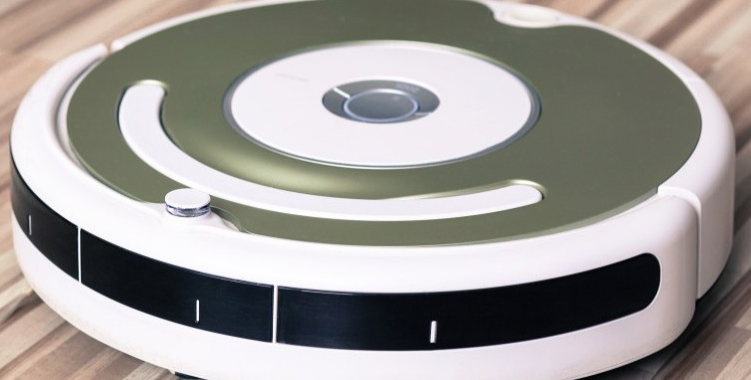
Rapidus News Agency and the magazine Elektroniktidningen report about a new significant investment in Acconeer . The money will be used to hire staff in product development and market introduction of robot vacuum cleaners, an area in which the customer have pilot series plans within the coming year. The technology is based on short ( < 600ps ) , coherent radar pulses generated with InGaAs circuits. The circuits originate from research of Lars-Erik Wernersson and Michael Egard and they have a range of about 50 m.
See full article in Elektroniktidningen
Text: Anders Borgström
Stage is Set for ESS Linac Test in Uppsala
Published: 2015-05-08
The first fully functional Low-Level Radio Frequency control system for the ESS Accelerator has been installed and integrated into the EPICS control system at the FREIA Laboratory at Uppsala University north of Stockholm. This is a delivery from the EIT-labs in Lund.
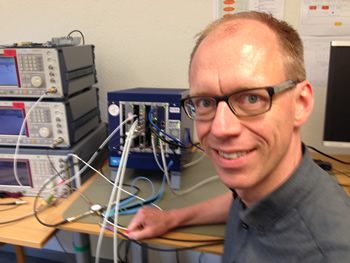
“This is not only an important step in the development and test of the RF systems of the ESS accelerator,” remarked Assoc. Prof. Anders Johansson of Lund University, who is the LLRF work unit leader on the WP8 team, “it is also an example of a successful cooperation between different institutes around Europe and between divisions inside ESS.”
Humans and Antennas Working in Harmony
Published: 2015-05-08
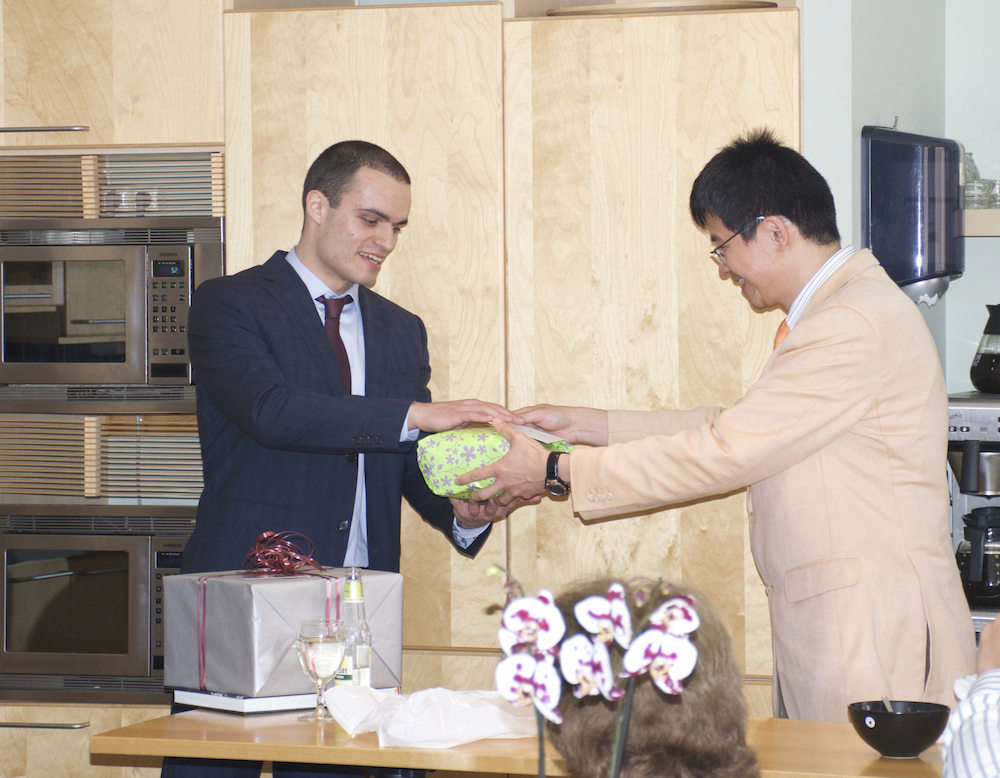
Vincent congratulates Ivaylo
Skilled at hiding his nervousness
“What on earth is ultra-reliable communication?”, “Why did you use a filter with the PA?”, “How big is the isolation between the antennas?”, “Tell me about the q values of the antennas.”, “Why do you use phantoms instead of hands?”, “How does the signal level affect voice/data-quality?”
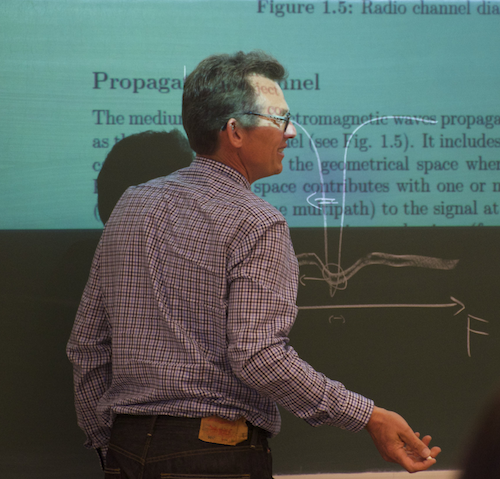 Opponent Pedersen. | 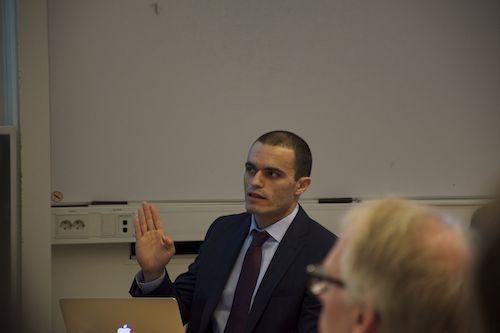 Defender Vasilev |
Ivaylo Vasilev is being bombarded with questions and prompts from the faculty opponent, Professor Gert Frølund Pedersen, most of which he confidently manages to give an answer to. Ivaylo doesn't seem overly nervous. “Not true”, the recent doctorate replies when I ask him about it later. “I was nervous alright, but I'm pleased that it didn't show too much”. He adds happily that “the room was completely full, and obviously people find the subject interesting”.
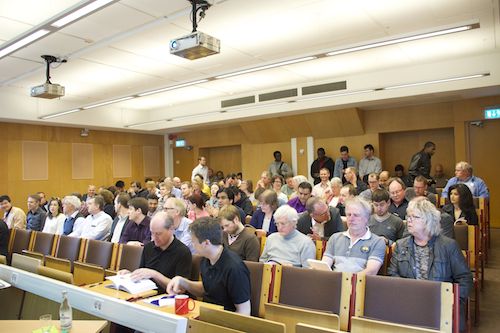
Full room
Motivated by lost signal bars
It is possible for a mobile phone that has functioned perfectly while on a flat surface to drastically drop in communication performance when you pick it up with your hand. Even Apple had to admit to an expensive mistake in an early iPhone launch when the signal bars would often and suddenly disappear. This was one of several factors that helped motivate the research Ivaylo has been conducting and he tells me that they looked at five to ten different antenna constructions, and what the results were of affecting the terminal with various objects.
MIMO and wearables present challenges for antennas
Ivaylo has spent the last 4-5 years of his life conducting research and working to understand how to optimise the antennas of mobile terminals in future MIMO systems and where terminals are used in varying ways. Antenna performance in a smart phone varies a lot depending on whether it is held against an ear or in a hand, and even depending on whether it is held using one or two hands. The future will bring even more potential scenarios, with the rise in popularity of so called wearables. New terminals, like for example watches, wristbands and glasses, will be wirelessly connected and thus total performance will be critically dependant on the antenna that is used. An ill-functioning antenna and/or a less than ideal environment could result in lower data speeds, lost connections and shorter battery lives. Antennas, wave propagation and user scenarios are the main focus of Ivaylos theoretical studies, calculations, simulations and experiments.
AIM helps users and antennas to harmonise
One concept that kept popping up in Ivaylo's discussion was that of Adaptive Impedance Matching (AIM). What is the significance of this acronym? “AIM improves terminal performance by optimising the interaction between the antenna and the propagation environment...”, I start tentatively while looking to Ivaylo for a better explanation, preferrably with a bit less jargon. “Performance optimisation in the presence of users”, Ivaylo says hesitantly. It must be tricky to explain these things in a simple way when normally there is a wealth of formulas and diagrams to help him along. One of the illustrations/images in his thesis shows how “differently” a smart phone can be affected in the presence of a users hands.
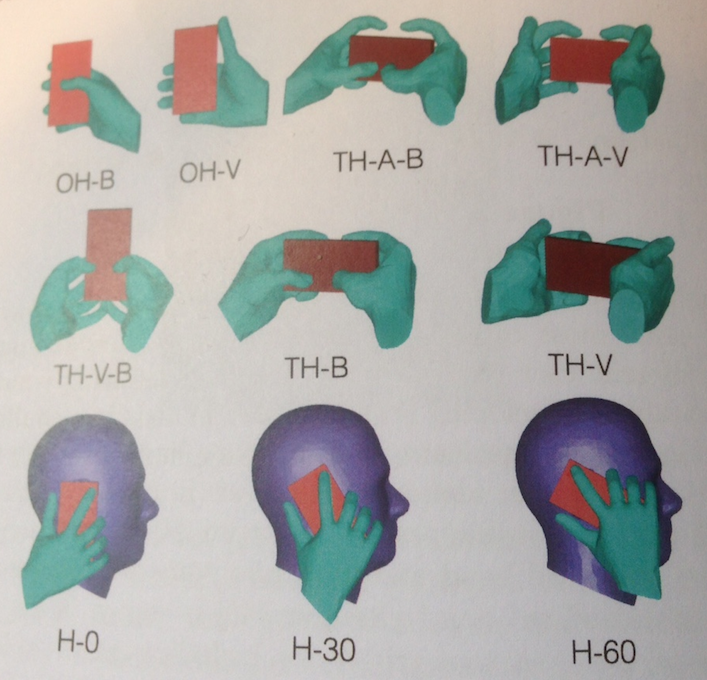
Hands on handset
For anyone who is interested in further information about Ivaylo's research, the following YouTube link has some extra treats for you.
From Bulgaria via Germany
Ivaylo moved to Germany after having finished high school in his home country of Bulgaria and more specifically in the city of Sophia. After that he spent five years in Germany, completing a Master of Science degree. After graduating, a professor recommended him to Buon Kiong Lau (Vincent) who was looking for a PhD student at the time. He moved to Sweden in the spring of 2010 and now, five years later, he finishes off his studies by gaining the coveted doctorate title. “Was it difficult adjusting to Sweden?”, I ask him. “No, it was pretty similar to Germany in many respects, even if it's a bit easier to connect with people here”, Ivaylo says. “And I've liked my colleagues, friends and living arrangements very much. And the food is OK. Even the meatballs.” “I go back to Bulgaria 3-4 times a year to meet my family and many of my friends who still live there”, Ivaylo continues.
Industry beckons
In the near future, Ivaylo is aiming to look for jobs in the industry, probably in Sweden or Germany. His girlfriend lives and works in London and Ivaylo is going to visit her shortly. First time in London!
We wish him the very best of luck in the future and hope to see EIT and Ivaylo's antenna research materialise in wireless, wearable products all over the world.
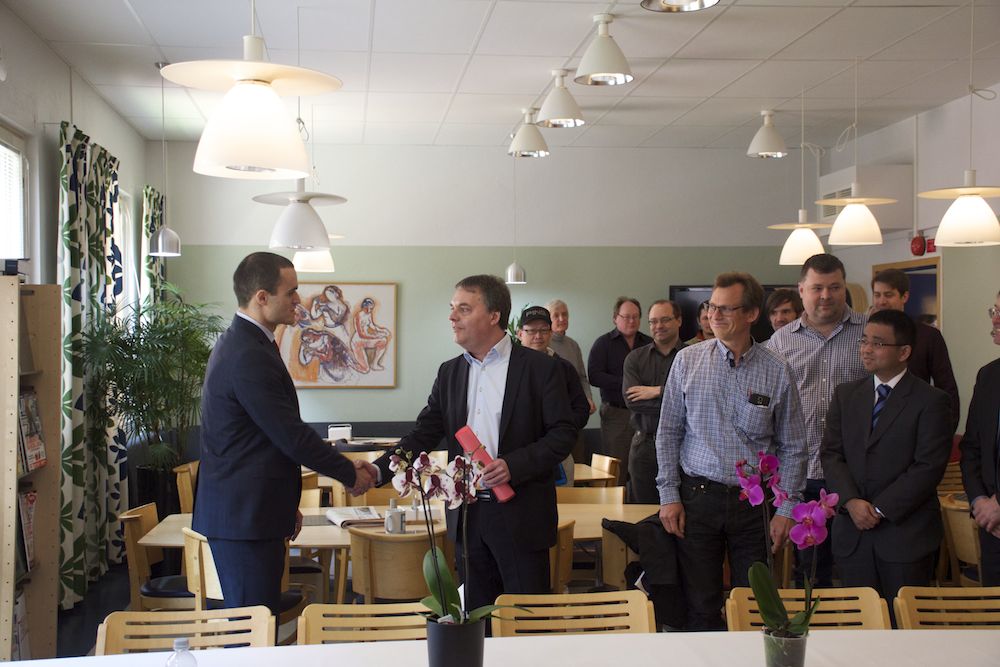
Congrats from committee
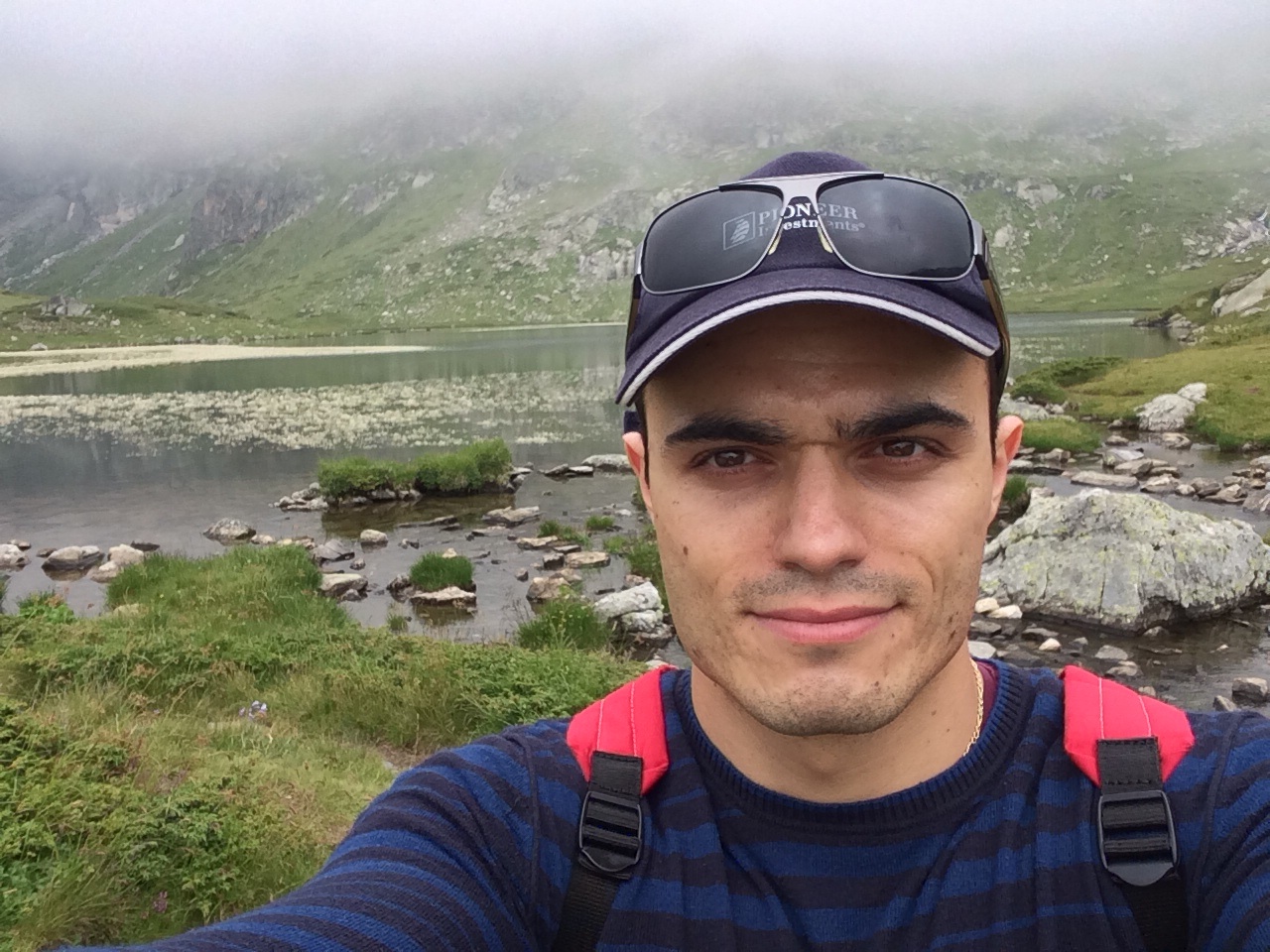
Ivaylo-selfie
Text & photo: Anders Borgström
LuMaMi on SVT
Published: 2015-05-06
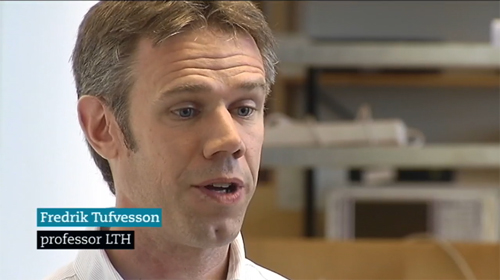
Fredrik Tufvesson interviewed by SVT (Swedish Television) regarding the next generation of (wireless) Internet.
See the interview here (in Swedish):
http://www.svt.se/nyheter/regionalt/skane/enorm-okning-av-datormangden-i-framtiden
Text: Johan Cedervall
Gerhards Grabbar med ny BAN-Antenn
Published: 2015-04-24
Gerhards Grabbar till final med kroppsantenn
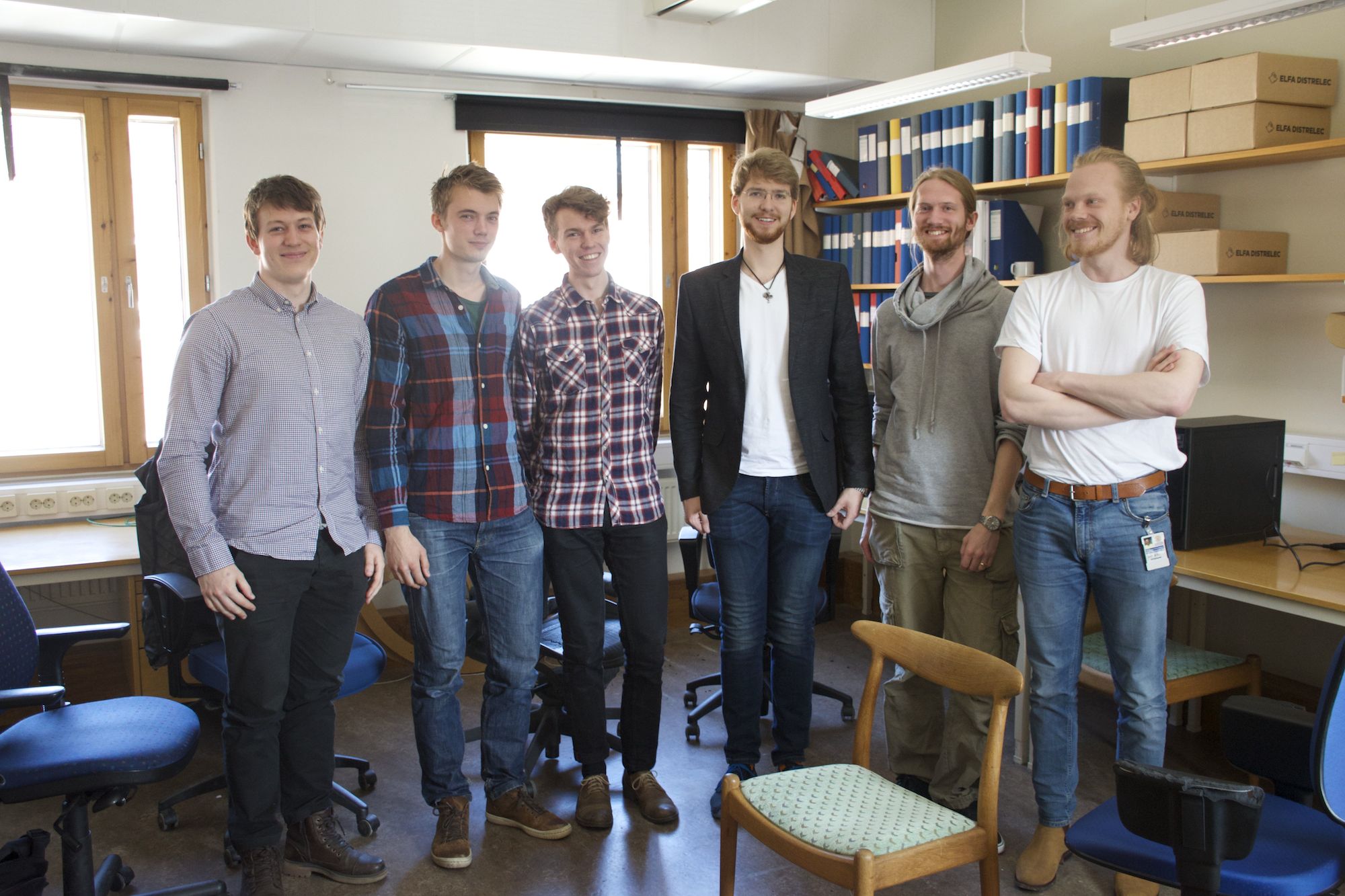
Teamet bakom BAN-antennsystemet: Fr.v. Alexander Israelsson, Hampus Månefjord, Edvard Johansson, Georg Wolgast, Casimir Ehrenborg. Längst till höger: Handledare Jakob Helander.
Bild: Anders Borgström.
Projektkurs ledde till IEEE-finalplats
Ära och pengar står på spel när tredjeårsstudenterna Georg Wolgast, Hampus Månefjord, Edvard Johansson, Alexander Israelsson och Casimir Ehrenborg styr kosan mot Vancouver den 21 Juli i år för att försöka knipa förstaplatsen i IEEE Antennas and Propagation Societys (AP-S) designtävling. Tävlingen går ut på att studenter ska utforma ett batteridrivet lågförbrukande BAN(Body Area Network)-antennsystem och lag från hela världen har kvalat in. Gerhards Grabbar, som teamet kallar sig, har knipit en av tre åtråvärda finalplatser och projektet har drivits inom ramen för EITs projektkurs Elektro- och Informationsteknik. Handledare har varit Anders Sunesson, adjungerad professor från ESS och Jakob Helander, EIT-doktorand på Teoretisk Elektroteknik.
Antennen den bärande delen i helt system
Grabbarna har byggt en antenn som är optimerad för s.k. BANs (Body Area Networks) eller kroppsnätverk där de med en bärbar apparat mäter och övervakar en persons hjärtrytm (EKG) samt skickar mätdata via BAN-et till personens mobiltelefon där informationen sen kan lagras och vidarebearbetas. Mätapparaturen består av elektroder, EKG-sensor, en Arduino microcontroller, bluetooth transciever, en Android-Smartphone med egenutvecklad app och sist och viktigast en egendesignad plan inverterad F-antenn. Bluetooth-LE standarden har valts för sin låga strömförbrukning och för att minimera kroppens utsättande för strålning. Antennen, som är huvudinsatsen i projektet, är designad för att i samspel med kroppen effektivt kunna överföra RF-signalen. Simuleringar, beräkningar, konstruktion och mätningar har resulterat i en för ändamålet väl fungerande ytvågsantenn tillverkad i billig teknik med koppar, glasfiberlaminat och lödtenn som huvudingredienser. Mobiltelefonen plockar vackert upp BT-signalen och presenterar EKG:t på telefonens display. Algoritmer och mjukvara kan sen processa signalen vidare för olika analysändamål och även skicka data vidare. Antennen ger bra signal med god dBm-marginal var den än placeras på kroppen vilket syns tydligt i appens RSSI-indikator. Tar någon konceptet vidare för kommersiell tillämpning kan den även göras både liten, tålig och billig.
Räddar liv hos personer med hjärtfel
Vad ska man ha detta till och vad är det egentligen Gerhards Grabbar mäter och analyserar? Jo, visionen är att rädda liv hos människor med hjärtfel och man mäter helt enkelt EKG som sedan analyseras och i god tid varnar för kommande akuta situationer. Tidig upptäckt räddar liv! Appen kan utvecklas vidare för att skicka informationen vidare till läkare, ambulans eller annan hjälp.
Dags att visa upp sig på bredare front
Sen laddar tredjeårsstudenterna om och innan Vancouver-scenen intas måste antennen lödas om och appen snyggas till. Dom kommande mötena kommer också handla om finputsning av rapport och om att förbereda sig på eventuella kniviga antennfrågor från AP-S panelen. Allihopa är faktiskt F-studenter och teoretisk elektroteknik kanske hittills inte varit huvudintresset i utbildningen så långt. Man anar en liten nervositet där.
De två andra finalisterna är hemliga änsålänge men det står klart att de är bland de andra fem som kvalade in i förra omgången. -Vi har sett deras videor och finnarna verkar vassa, säger killarna ödmjukt.
EIT-teamets video har tagit sin lilla tid också då det inte är helt lätt att vara skådespelare, regissör, filmare, klippare och ljudtekniker på en gång men med Windows Moviemaker har det blivit en mycket sevärd och instruktiv 5-minutersproduktion som säkert hjälpte till ordentligt att ordna finalplatsen. Kolla här.
Gerhards Grabbar presenterar sig och sitt projekt även på institutonen nu på måndag den 27 April kl 16. Kom och lyssna i E:3139 kl 16.15.
Studier först, sen karriär.
-Vi blir ju publicerade snart så det lär ju öppna upp världen för oss, säger killarna med ett skratt. Lite allvar bakom skrattet dock, det finns faktiskt goda möjligheter att få in arbetet som en artikel med tanke på att dom gått så här långt i tävlingen. -Att kunna åka till konferensen är en spännande grej för framtiden bara det, inte minst för alla möten och diskussioner med liknande intressen som det medför säger handledaren Jakob Helander. E-fält, antenner, kanalmodulation, kommunikation och annat diskuteras i minglet och har man tur kommer man i slang med en professor som fiskar efter lovande potentiella doktorander. Att trycka upp gamla hederliga visitkort är ett billigt och gott råd.
Att genomföra grundutbildningen enligt plan är väl annars mål nummer 1 innan akademi- eller industrikarriär väntar. Det finns mycket roligt att välja mellan så inget är hugget i sten men EIT har i alla fall fått ett gyllene tillfälle att rekrytera över F-are till E-världen. Singapore, Zürich och andra exotiska platser som Lund och Finspång blir kommande mål för studier och arbete under bl.a. sommaruppehållet i utbildningen. Semester i USA och Kanada, visum m.m. är nu grejer som också rör sig i huvet på killarna.
EIT gratulerar Gerhards Grabbar och önskar lycka till i Vancouver-finalen!
Framtidens examination prövas på EIT
Published: 2015-04-14
|
Professor Per Ödling har å LTHs vägnar examinerat MOOCs (Massive Open Online Course) i samarbete med Akademi Norr, ett 13-kommuners förbund i norra Sverige där 5 unga människkor från 5 olika länder examinerades av Lund på plats i Arvidsjaur. Per flög upp, satt en halv dag, examinerade och flög ner. Arvidsjaur kommun betalade och det blev stort genomslag i lokalmedia. Detta är en naturlig del av framtidens metodik för högre utbildning och LTH hjälper genom dessa konkreta insatser till att visa vägen. "Affärsmodellen" bygger på att kommunerna agerar campus och studiestöd men “outsourcar” examinationen till i detta fall LU. Våra examinatorer agerar "återförsäljare" åt alla möjliga MOOCs leverantörer och slutlevererar "produkten" genom examination. Akademi Norr vill nu skala upp och köra ett EU-projekt och EIT, LTH eller LU kan haka på och söka EU-pengar för metodutveckling och fortsatt MOOCs-examination. Text: Anders Borgström
|
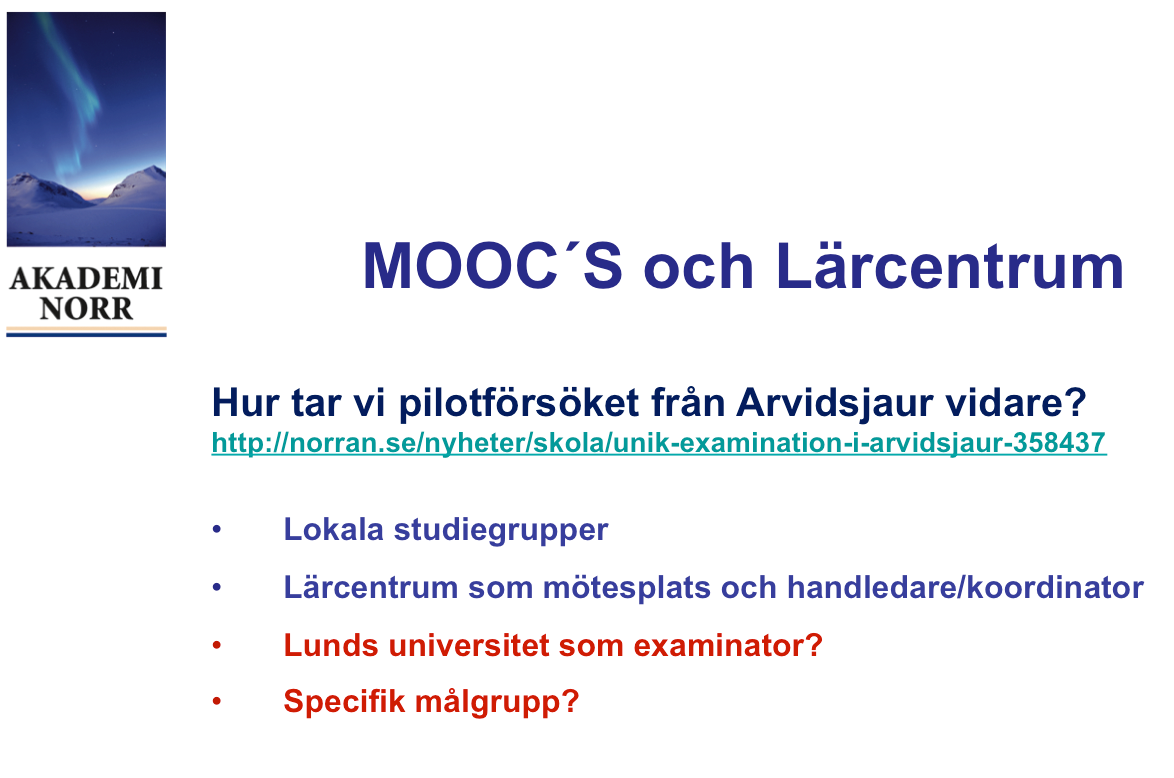 |
SIP Wireless Society programansökan vidare till intervju.
Published: 2015-03-22
|
Ansökan till VINNOVA om att etablera ett SIP (Strategiskt Innovationsprogram) med namnet Wireless Society har nu gått vidare till intervju vilken kommer att ske på Vinnova nu på onsdag, den 25:e mars hos VINNOVA i Stockholm. Från EIT Lund har Viktor Öwall, Anders Borgström och Fredrik Tufvesson deltagit i arbetsgruppen under framtagningen av programansökan. Från Sony Mobile i Lund har Vanja Plicanic Samuelsson deltagit. De som träffas hos VINNOVA för att presentera och försvara programmet är Vanja Plicanic Samuelsson Sony Mobile, Ulf Forsén Ericsson, Jens Zander KTH, Katrin Ekvall Scanreco, Anders Johansson Percipia och Claes Beckman, KTH. Intervjun kommer att utföras av två externa bedömare och minst fem representanter från de finansierande myndigheterna och den beräknas ta drygt 1 timme i anspråk. Intervjun föregås av en programpresentation inkluderande summering, arbetssätt, samverkan, aktörer, samhällsnytta och riskanalys. |
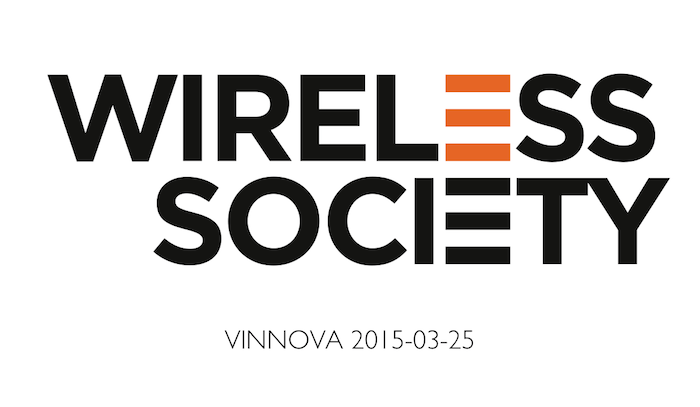 |
EITs föreläser på NMT-dagarna!!
Published: 2015-03-16
|
Denna vecka välkomnas gymnasielärare och elever till årets upplaga av NMT-dagarna. NMT står för Natur, Medicin, Teknik och under veckan föreläser motsvarande fakulteters lärde populärvetenskapligt för att övetyga potentiella blivande LU-studenter om vilken bana man ska välja. Det hålls omkring 300 föreläsningar av drygt 130 olika forskare och EIT "marknadsförs" av våra egna där följande personer och spännande presentationer visas upp.
|
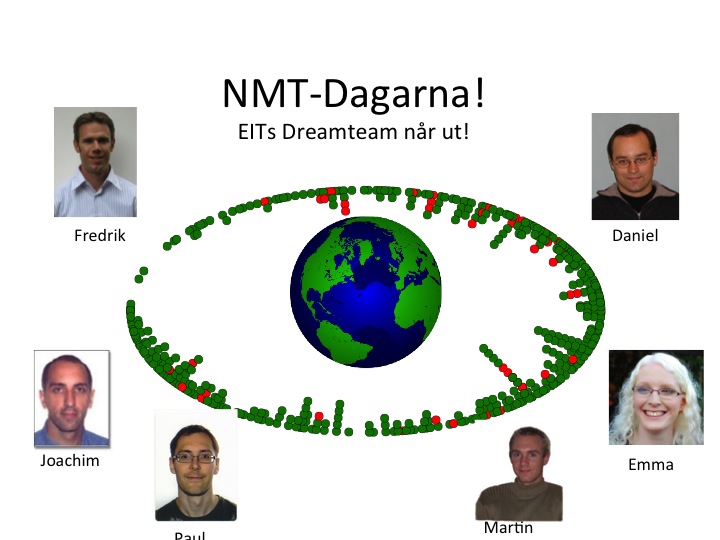 |
Fredrik Tufvesson
Mamma Mia, bilar börjar prata!
Daniel Sjöberg
Satellitkommunikation – samtal tvärs över jorden via rymden
Paul Stankovski
Vem stal mitt Facebookkonto och hur gjorde de?
Martin Hell
Att knäcka ett lösenord
Joachim Rodrigues
Elektronik i kroppen
Emma Fitzgerald
Trådlösa nätverk, kommunikation genom luften
Text/Bild:Anders Borgström
Ericsson lanserar "5G for Sweden". EIT är med!
Published: 2015-03-02
|
Ericsson lanserade idag på MWC i Barcelona ett nytt forskningsprogram "5G for Sweden". Med forskning, innovation och industriella pilotprojekt ska industrins konkurrenskraft inom 5G stärkas och forskningen ska tillämpas inom olika industrigrenar. Nya projekt inom akademi och industri skapas samtidigt som värdefulla insikter erhålles runt 5G-innovationer och digitalisering av industri och samhällsfunktioner. |
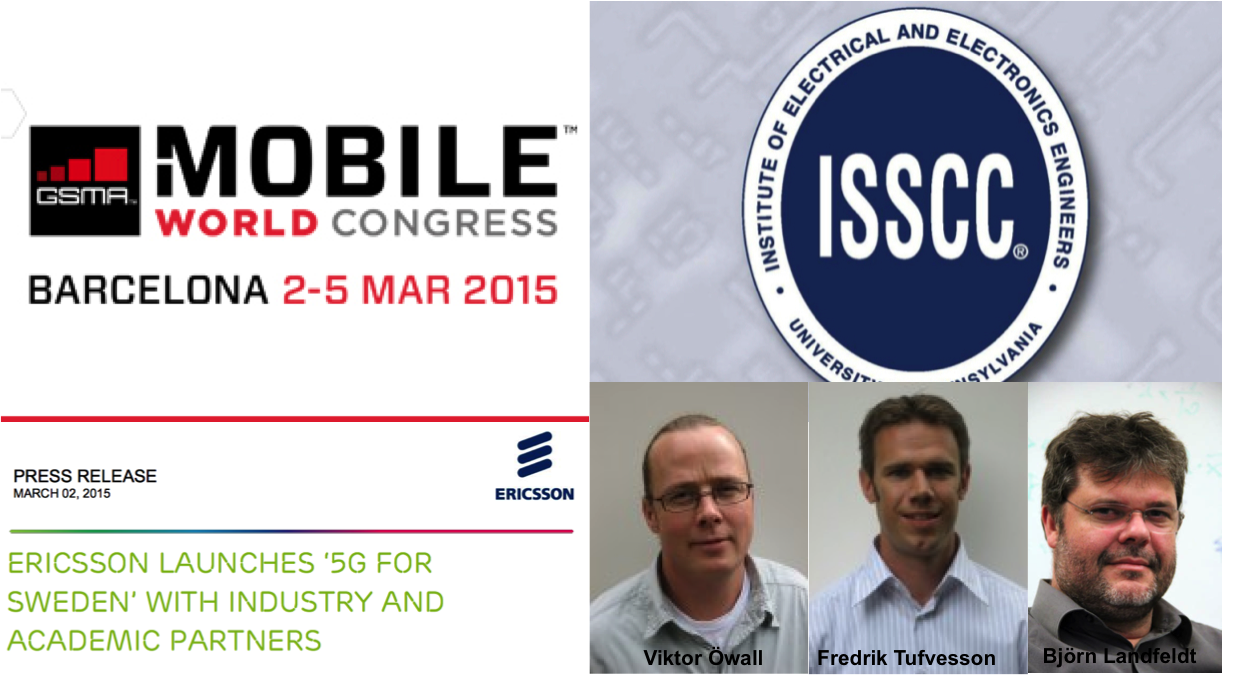 |
|
Programmet visar vägen med hårdvara mjukvara och tjänster inom mobilitet, bredband ochmoln samt skapar grund för nya ekosystem. Partners inom "5G for Sweden" är Scania, Volvo Construction Equipment, KTH, Chalmers, LiU, LTH, RISE, Swedish ICT och dessutom stödjer VINNOVA programmet finansiellt. Samarbetet presenterades på MWC av Tony Sandberg, Scania, Charlotte Brogren, VINNOVA och Sara Mazur, Ericsson. Kommentarer från de egna leden: –Lund har en lång tradition inom mobil kommunikation och har jobbat aktivt med Ericsson sedan början av 80-talet. LTH har många unika kunskaper inom bland annat hårdvara, algoritmer och systemutveckling som alla är viktiga delar inom framtida 5G-system. Unik kompetens från Lund är bl.a. Massive MIMO där Lund är världsledande. Fredrik Tufvesson har nyligen presenterat tekniken på världens största chipkonferens ISSCC i San Francisco och jag själv presenterade samma sak på Intel och Xilinx. Allt med stor framgång, säger allas vår rektor Viktor Öwall. –Det behövs mycket fundamental forskning och utveckling inom 5G och det är väldigt spännande att vara en del av den kraftsamling som nu sker nationellt. 5G kommer att föra med sig helt nya systemlösningar och teknologier och framförallt kommer dessa att möjliggöra stora förändringar inom olika industrier och samhället i stort. Det är viktigt för oss att i samverkan med industrin bidra med den expertis vi har för att lösa svåra forskningsfrågor och möjliggöra denna utveckling, säger Björn Landfeldt, föreståndare för MAPCI. |
Läs mer (LTH-Nytt)
Text/Bild: Anders Borgström
EIT presented 5G-contributions at ISSCC
Published: 2015-03-01
Last week Fredrik Tufvesson presented "More Bits via the Same Spectrum - Massive MIMO opportunities and challenge " at ISSCC (International Solid State Circuits Conference) in San Francisco within the session “How to Achieve 1000 × more Wireless Data Capacity? 5G?”. EE Times covered the session and mentioned the Lund-teams contribution as:
Sweden’s Lund University created and tested a prototype 5G base station (described above and shown below) that supports 100 coherent RF chains using OFDM transmission. It uses an array antenna printed at the university and generated 10 Gbytes/second of data in operation.
In tests so far with 10 users working in 20 MHz of spectrum at 3.7 GHz, the prototype supported adequate coherency with signals well aligned in time, said Fredrik Tufvesson, a professor at Lund. “We got it working, now we need to squeeze it,” he said.
Read the full article here:
Carl cracked the codes and broke through
Published: 2015-02-17
A mixture of family tradition, psychology studies, chance and teachers at LTH is the basis for Carl's work to do the (digital) world safer in the future. A successful work, which survived the tough grilling at the PhD defense.
– It was not as tough as I feared, says Dr. Carl Löndahl.
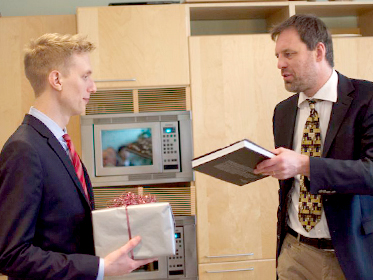 Carl Löndahl (left) getting congratulated by supervising professor THomas Johansson |
Hot subject with everyday use
With Edward Snowden and Julian Assange on the world's headlines, cryptanalysis has become a hot and highly topical area. Questions regarding personal privacy versus various types of monitoring, for different purposes, involve the masses. But even such a mundane and common activity to log on to one’s online banking uses encryption – technology that constantly need to be developed and improved to keep secure.
Got into crypto by accident
Carl was reading courses in cognitive psychology and became interested in mathematical models. Combined with a family tradition, the educational choice became obvious – both father and grandfather were electrical engineers. Carl chose to study Electrical Engineering at Faculty of Engineering, LTH - but to specialize in cryptography, however, was less expected.
– During the undergraduate courses I ended up on a cryptographic course more or less by accident. But because I enjoy solving problems, the area suited me well. Some teachers persuaded me to continue by disputing and I do not regret doing it, says the newly-appointed doctor.
Makes information unreadable
EIT research group Cryptology and Security has research ancestry in various cryptologic areas since 1982. Not least, its findings have found applications in mobile telephony.
– Briefly, one can say that encryption is used to make the information unreadable. Information gets put in, called cleartext, together with a secret key. The encryption algorithm then converts the plaintext into ciphertext, which will be unreadable without the key, says Carl.
Reformulating the cryptosystem
His thesis is titled "Some Notes on Code-Based Cryptography" and is, among other things, about how to protect against crypto-cracking. Most classical cryptos will henceforth be forced. The cryptographers must therefore find new ways to encrypt. Carl’s focus has been on trying to crack cryptos to learn how they can be improved. In other words: he has been working with cryptanalysis.
– My research has moved around a cryptosystem called McEliece. It is not new and has been considered impractical because of the large key size – but it is becoming more and more interesting. My thesis deals [among other things] with how to reformulate the cryptosystem to increase security against attacks.
Will stay on the trails?
Carl from Kristianstad will leave EIT to work in the industry indefinitely. But first and foremost, the future contains new challenges as the upcoming family member who moves into a crib in Carl and his girlfriend's apartment at Lilla Fiskaregatan. And probably comply with Carl on his wanderings in the woods and fields.
– I love the outdoors and spend many hours each week with lumbering around in it. I have inherited that from my mother, Carl Löndahl concludes with a smile.
EIT congratulates and wishes Carl good luck!
Text: Johan Cedervall
Photo & research: Anders Borgström
Optimized networking for Dr Li
Published: 2015-02-03
|
EIT's latest Doctor is Yuan Li, who has spent his time in Lund doing PhD-studies in the field of wireless networks optimization. With curiosity that befits a scientist, Yuan has looked at issues like network topology, network latency, improved network performance and also used mathematical programming tools for that purpose. Basics in China and Specialisation in Sweden The cradle of Chinese civilisation! It's another name for the mighty Huang He, the Yellow River, which passes the city of Yongji in the Northern parts of China.
|
Yuan Li with committee |
|
A city of approximately 40,000 inhabitants, it is here that Yuan Li was born and where he completed his basic and high school education. He then moved further south – to the city of Changsa – to study Computer Science at the Nation University of Defense Technology. During his university studies Yuan Li got a well-rounded knowledge of wired and wireless networks but decided he wanted to further his knowledge on the subject and grasp more advanced theories of wireless networks. “I searched online for 'research on wireless networks' and EIT seems to be highly ranked by the Google algorithms because one of the first things I saw was a doctorate on the subject”, Yuan says. He got the job and started off by thoroughly learning optimisation theory, which he could then apply to his research. With all due deference to theory, Yuan's goal all along was to find solutions for 'real' problems in the world of networks, especially focusing on industrial applications. Wireless networking technologies have profoundly influenced people's lifestyle and working habits, especially greatly changed the way of communicating. Different kinds of wireless networks have been used and deployed during the past two decades, such as Bluetooth, cellular networks and wireless local area networks. Accordingly, the demand for network services with high bandwidth, low latency, good fairness and strong reliability, etc., continues to increase rapidly. To improve network performance, it is crucial to optimize wireless systems in both the design and the operation phase. The optimization techniques play important roles for this purpose. -In my work, I have studied a set of problems existed in wireless systems, including delay minimization problem in wireless networks, fair resource allocation in wireless mesh network, and topology design in wireless optical networks, Yuan describes his PhD-studies. Utilizing the tool of mathematical programming, I provide global optimal solutions to these problems, which deliver much better network performance than empirical solutions. When the problem size becomes large, it is quite time-consuming to approach exact solutions. I also designed some heuristic methods which can solve the problem in a reasonable time and deliver near-optimal solutions. The presented solutions and methods provide important guidelines for engineers to design and deploy various wireless networks. Entering the work force When this is published, Yuan has already moved back to China and his aim is to find a job either at his old university or in the industry. He now wants to work in a more practical manner and be able to apply the mass of knowledge he has accumulated during his years of education and research. For example, why not construct an effective wireless city network? Bowling, meatballs and fermented herring Any hobbies? “Well, maybe watching movies, and in that case action, Hollywood and Chinese films suit me the best”, Yuan says. He had never tried bowling before coming to Sweden but it turned out to be a fun experience and his colleagues managed to teach him some tricks. And how Swedish does he feel? Does he speak Swedish? “No!” Read Swedish? “A little bit!” What about Swedish food? “Good!”. He likes meatballs but prefers to add his own spices. Fish is good too and Yuan says he's even tried the notorious fermented herring, a claim to which this interviewer remains sceptical. Going back home As mentioned, Yuan is already back in China and we hope he'll give us some free publicity there by excelling in his future career within wireless networks. However, before then he's set to get married in his hometown of Yongji. “Not that big,” Yuan says, “just a couple of hundred guests”. EIT wishes Yuan Li the very best in the future! Text/Photo: Anders Borgström |
Wrong went right for Dimitar
Published: 2015-01-27
|
Advanced technology doesn't always work Technology has invaded our lives and we are surrounded by increasingly high-performing electronics. The ever more miniaturised semiconductor technology is vulnerable to faults and so despite the high performance, there is a risk that the electronics will stop working. At times this could have catastrophic consequences. |
Dimitar Nikolov at work |
|
This field of research is known as fault tolerance and the challenge is to make stuff work properly even when something goes wrong in the technological functions. Fault tolerance deals with technology and methods that detect and correct faults. This often results in a time overhead which can cause problems for real time systems as these systems are dependent both on correct calculations and on things happening at the right time. “My research is about how to handle fault tolerance in real time systems”, Dimitar says. Fault tolerance is an increasingly important field as electronics are introduced into the vital parts of more and more products, industries and activities. Faulty electronics could lead to everything from cars crashing to mobile phones failing and even heart surgery going wrong. And that's obviously something we would want to prevent from happening. Academic route the right choice for Dimitar Dimitar knew he wanted to take the academic route early on and for that reason doctorate studies felt like the natural choice. When he first started his research, this particular field of studies was unknown to him which proved a welcome challenge. “Throughout the years my field of vision has widened significantly and I have more and more realised how important this field of research is”, a pleased Dimitar remarks. Dimitar's Master's degree is from the University of Ss. Cyril and Methodius, in Skopje, Macedonia. While there he also worked as a laboratory assistant and this was what made him realise he wanted to continue within academia and research. After this he applied for a position as a PhD student in Sweden which lead to him beginning his doctoral studies in Linköping. “After a while I moved, along with my supervisor, to Lund and LTH where I've really enjoyed both my studies and my spare time” says Dimitar. “And I will continue my career in academia and research. Preferably in Sweden but money and finance will be the main deciding factor”, he adds. Despite his doctoral thesis having been approved, Dimitar has a couple of points he needs to take in research and tutoring before he finally gets to graduate as a Doctor. That means he will keep his laboratory and office in E-huset until at least June. From Macedonia to Lund Dimitar lives at Norra Fäladen in Lund but visits family in his home country of Macedonia whenever he gets the chance. With a Macedonian mother tongue and English spoken with his colleagues, Dimitar has never gotten around to learning very much Swedish. But Dimitar at least knows the Swedish word "soffpotatis" (couch potato) and describes himself as a little bit of one when I ask him if he practices any sports. “I did a little bit of Squash but never that much. But I've become interested in photography!” As a present for completing his thesis, Dimitar got a new Nikon camera and with four different lenses in his camera bag there will be no shortage of things to photograph. This also results in a sizeable portion of the interview being spent talking about shutter speeds, image sensors and other camera geekery. EIT hopes that the electronics in Dimitar's camera is fault tolerant with nice pictures as a result and congratulate this new Doctor on his completed thesis. And wishes him good luck with any future research! |
Text/Photo: Anders Borgström
Gerhard Kristensson kallad till hedersledamot i SNRV
Published: 2015-01-15
Den sedan december pensionerade professorn blev under torsdagen hyllad av kollegor från olika håll och strax före lunch blev han varse sitt innehav av hederstiteln från Svenska Nationalkomittén för radiovetenskap (SNRV), vilken han efter nio år som ordförande också pensioneras ifrån.
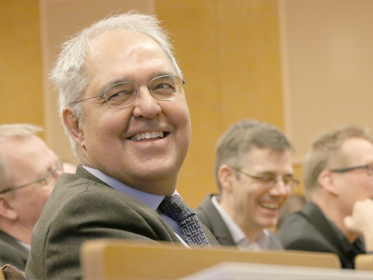 Munter stämning under Gerharddagen. |
Torsdagen den 15 januari 2015 går till historien som ”Gerharddagen”, i varje fall i EIT:s historiebok. Det var dagen då Gerhards kollegor – både nyare och betydligt äldre – fick tillfälle att samlas och framföra hyllningar och prata om gamla minnen.
Stämningen var mycket munter. Som när dagens värd, Anders Karlsson, berättade om reseminnen. Eller som när en annan föredetta kollega berättade om ett experiment som aldrig resulterade i någon skriven artikel men som handlade om hur man lämpligast blir av med duvor från balkongen. Eller som när en annan kollega berättade om hur man kan göra för att få in en kanot i en lägenhet på tredje våningen - utan att väcka uppståndelse. Och utan att använda trapphuset (eftersom kanoten inte får plats i trapphuset).
Carl-Henrik Walde, överingenjör och sekreterare i SNRV, höll ett uppskattat föredrag med fokus på radiohistoria. Ett synnerligen tilltalande ämne. Det började med whiskey och avslutades med musik. Strax dessförinnan hade Carl-Henrik förmedlat beslutet att kalla Gerhard till hedersledamot i SNRV. Motiveringen löd som följer:
”Gerhard Kristensson har varit kedamot i SNRV i 24 år, varit ordförande i dess sektion B i 12 år och senast varit synnerligen uppskattad ordförande i SNRV i nio år. Gerhard har varit aktiv inom URSI och har där och inom KVA setts med stor respekt vilket även gäller SNRV som helhet. Han har under 25 års tid vidareutvecklat en institution på LTH till mycket hög klass.
SNRV har beslutat kalla Gerhard till hedersledamot.”
Text & foto: Johan Cedervall
Electromagnetic Theory workshop is on
Published: 2015-01-14
The SSF-project "Complex analysis and convex optimization" is having a workshop in E:3139 during the whole day.
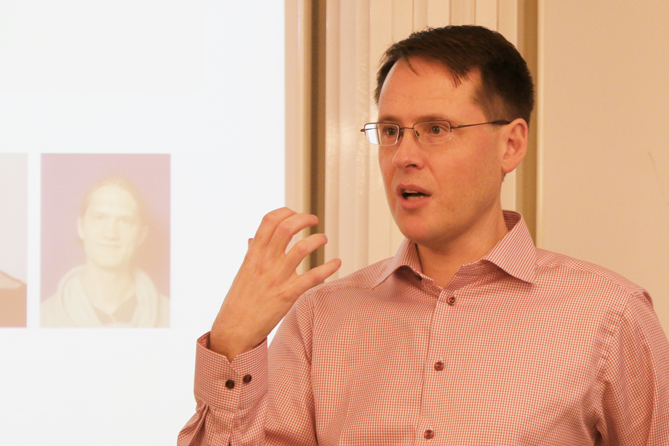
Mats Gustafsson is the project leader and started the lecture-dense Wednesday.
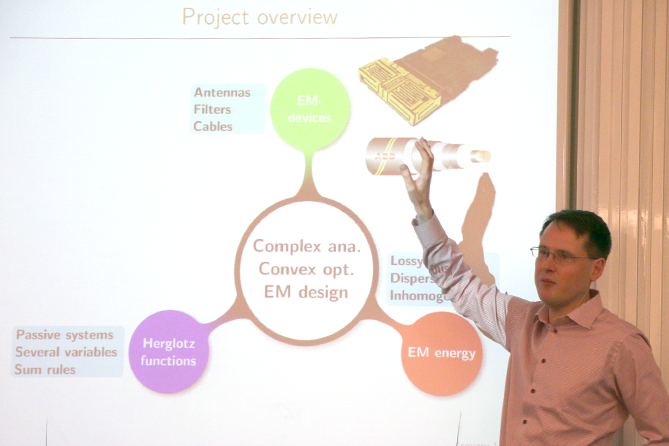
Mats is giving a lecture at 15:30 ("EM energy and antennas"), but started with speaking about the project in whole.
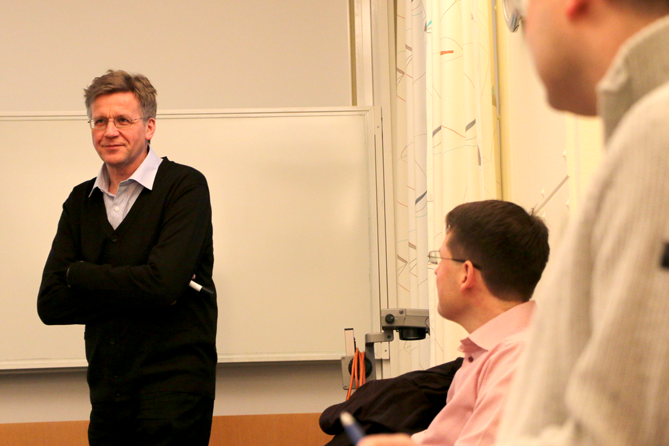
Ragnar Sigurdsson from University of Iceland was the first speaker. The topic was "Complex analysis in several variables".
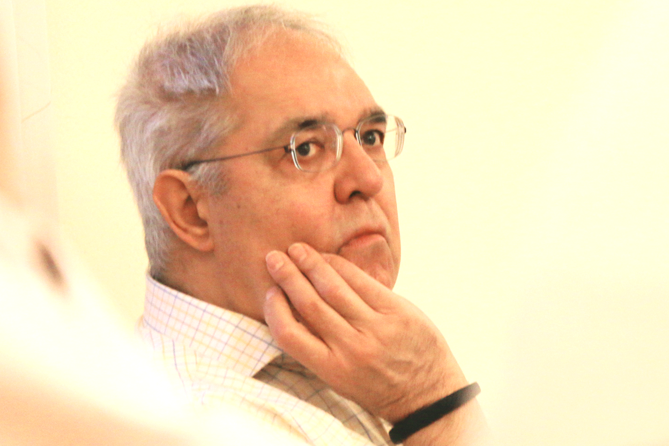
Gerhard Kristensson is in the audience. Tomorrow he will be the focus of everyone's attention - the whole day (15/1-15) is going to be used to tribute him for his efforts during his working years (start 10.00, E:1406).
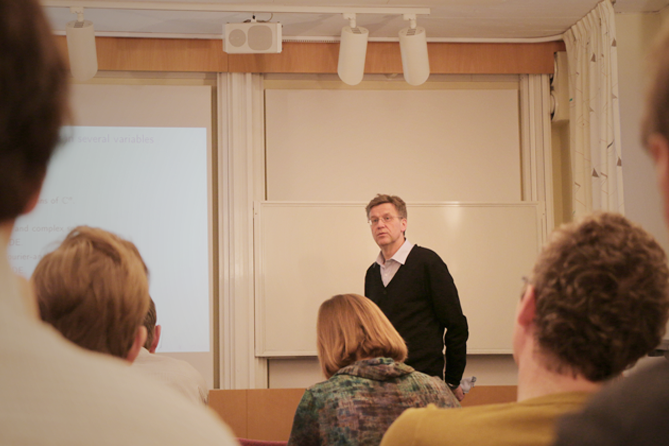
Ragnar Sigurdsson and audience.
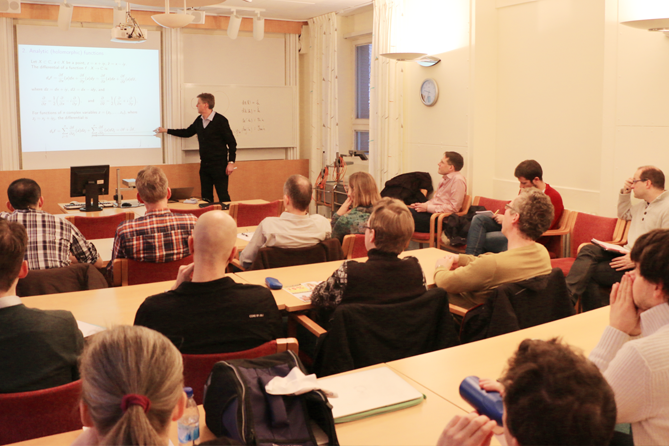
Well-attended E:3139
Today's program is found here: http://www.eit.lth.se/index.php?news=2&L=1#1914
Read more about the project here: http://www.eit.lth.se/index.php?puid=175&L=1
Text & foto: Johan Cedervall
